
- Salkantay Trek
- Inca Jungle Trek
- Huchuy Qosqo Trek
- Ausangate Trek
- Vilcabamba Trek
- Choquequirao Trek
- Huayna Picchu
- Altitude Sickness
- Packing List
- Humantay Lake
- Lake Titicaca
- Nazca Lines
- Rainbow Mountain
- Get A Trek Quote

Salkantay Trek to Machu Picchu – One Of The World’s Best Hikes
Back in September 2022, I hiked the Salkantay route to visit Machu Picchu . I also spent over a month in Cusco .
In this article, I've compiled the most up-to-date and comprehensive information on the Salkantay trek based on my own experience and extensive research.
I've included guidance on the route, costs, the tour operators, how to do the Salkantay without a guide, when to go and much more.
Let's jump in.
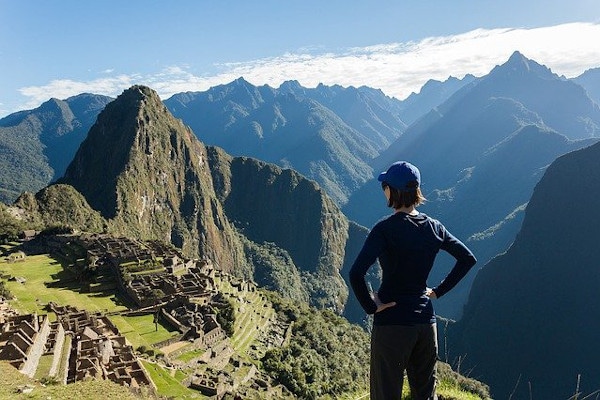
Get a Salkantay trek quote
Start planning your Machu Picchu hiking holiday.
Salkantay Trek to Machu Picchu - One of the World's Best Hikes
A brief overview of the salkantay trek.
The Salkantay trek (also known as the Salkantay trail) is the most popular alternative trek to Machu Picchu . And with good reason - it offers hikers an incredibly diverse trekking experience.
National Geographic Adventure Magazine rated the Salkantay trek as one of the 25 Best Treks in the World.
The trail is relatively easy to access from Cusco. Unlike the Inca Trail , there are no permit limitations. In fact, the Salkantay trek can be completed without the use of a guide or tour agency.
See more in our guide on how to do the Salkantay Trek unguided .
The trail journeys through incredible landscapes with lowland jungle giving way to highland alpine settings and glaciated mountains.
See our handy route map below outlining the various checkpoints along the Salkantay trek.
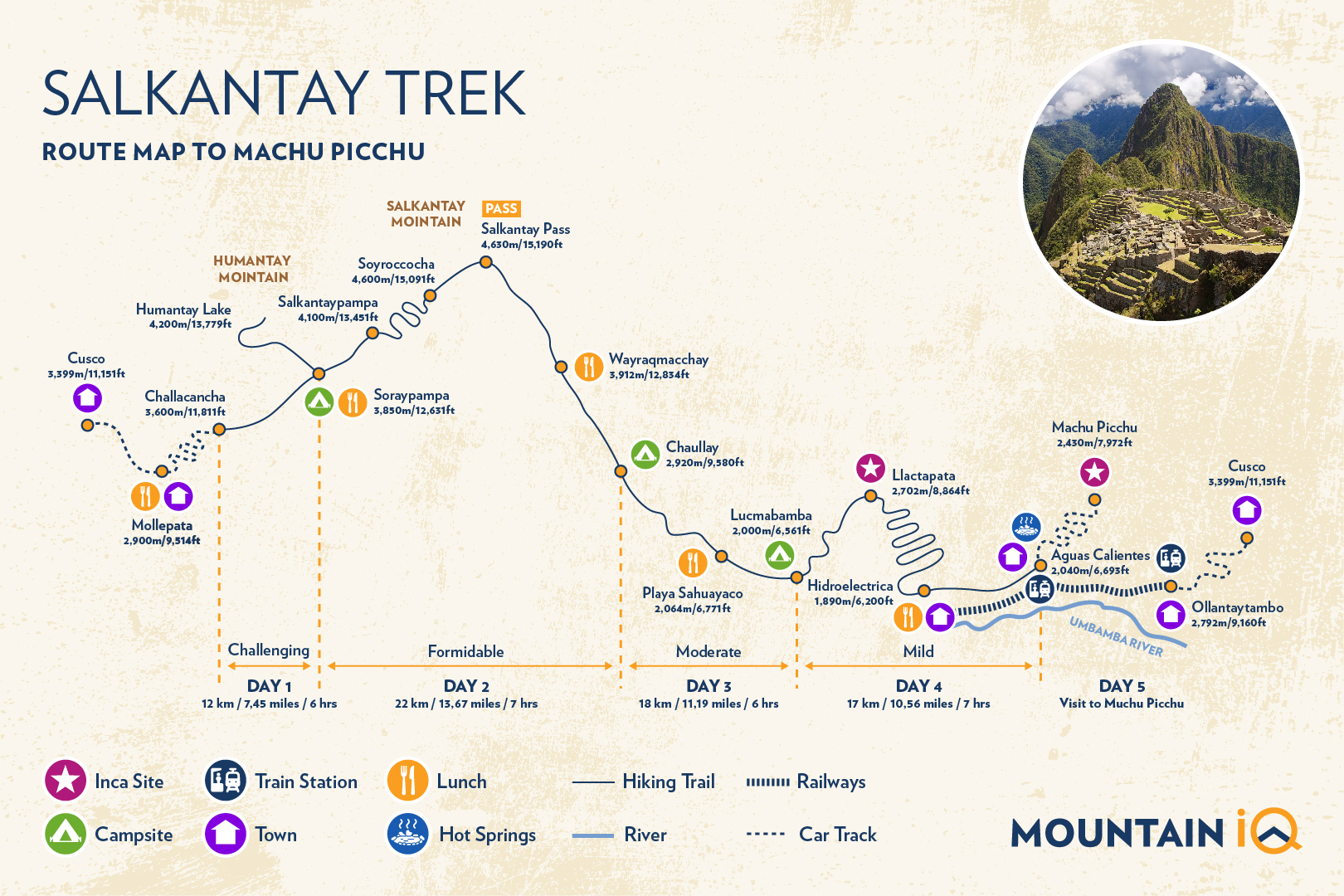
How long is the Salkantay Trek?
The Salkantay Trek is approximately 69 kilometres / 42.87 miles long. There are some variations on route depending on where you start and the company you trek with.
The trek is typically completed on a 5 Day / 4 Night itinerary with a visit to Machu Picchu on the fifth and final day. However, it is possible to do the trek on a 4 Day / 3 Night itinerary too.
You can also combine the Salkantay trek with the Inca Trail for a challenging, 7-day hike.
Looking for a day tour? Here are my 5 favourite day tours around Cusco:
- Rainbow Mountain day trip (with meals)
- Moray and Salt Mines Quad Bike Tour
- Sacred Valley day tour
- Humantay Lake day tour
- Machu Picchu and Huayna Picchu entrance tickets
See more Cusco day trips .
Is the Salkantay Trek Difficult?
The Salkantay trek is not too difficult and considered a long hike with some moderate to challenging ascents. The Salkantay trail is generally said to be more difficult than the 4-day Inca Trail since it is almost twice the distance.
After hiking the Salkantay, I would say it is not especially challenging. There are no technical parts and only two long uphill climbs. Many of the days include long sections trekking downslope.
With that said, you will need to be physically fit to take on this hike. Some form of training is necessary (see more in our section on training and preparation below).
I would also suggest you first take on some tough day trails (more than 15km / 9 miles) and shorter overnight hikes. Huaraz in North Peru is a great place to prepare for the Salkantay trek.
The most difficult part of the Salkantay trek is on Day 2. This is when you ascend the pass to Salkantay Mountain (6,271m / 20,574 ft). During this part of the trek, make sure you drink plenty of water and stop often to catch your breath.
Day 4 is another long day with a steep hike in the morning. I found the 2-hour descent to Hidroeléctrica (1,890m / 6,200 ft) to be particularly tough on my knees. Take it slow and walk in small zigzags down the path.
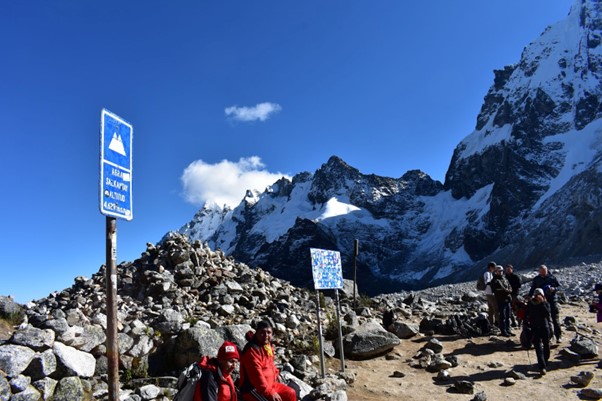
Day 2 of the Salkantay Trek - The top of Salkantay pass.
What Makes Salkantay Mountain Special?
What makes Sakantay trek special is its most notable landmark - Mount Salkantay, for which the trail is named.
Mount Salkantay (or Nevada Salkantay / Salcantay) is the most iconic mountain near Cusco. It is also the highest mountain in the Willkapampa range.
Trekkers on the Salkantay trail approach the mountain from the south. On the first night, you can sometimes hear avalanches from camp in the valley below this snowy summit.
On the second day, hikers scale the Salkantay Pass (4,630m / 15,190 ft). At the top of this pass, you will be in close proximity to the mountain. This altitude also provides amazing views into the valley below.
This mountain is held sacred within Peruvian culture. It is not easily scaled and there have been few summit expeditions.
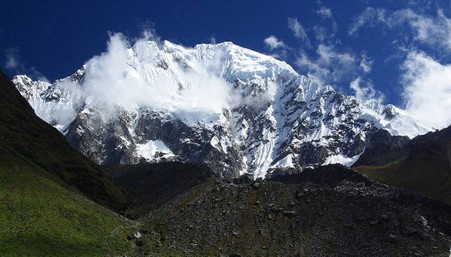
South-west face of Nevada Salkantay, as viewed from the Salkantay trail.
What Is the Salkantay Trek Itinerary?
The Salkantay trek set out below is for a typical 5 Day / 4 Night itinerary using an official tour company. With these treks, arrieros (horsemen) are employed to carry gear for hikers.
This route is the most common. You may see some variations from tour company to tour company.
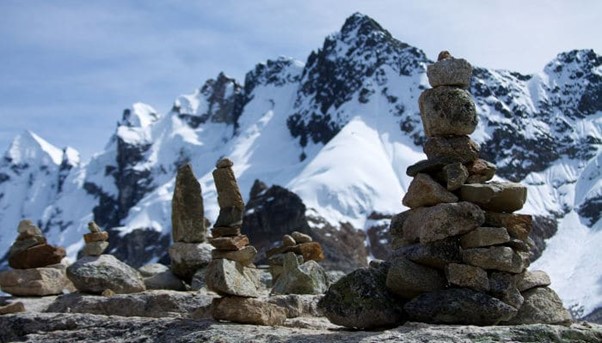
Stone Cairns left by previous trekkers at the Salkantay Pass (4,600m / 15,092 ft).
Day 1: Cusco - Mollepata - Soraypampa
- Total trek distance: ~12km / 7.45 miles
- Total time walking: ~6 hours
Most Salkantay tours depart by bus or private car from Cusco city (3,399m / 11,151 ft) early on day one. You will be picked up from your hotel or meet at the company office around 4:30 / 5:00.
From Cusco, it is a 2-hour drive to the town of Mollepata (2,900m / 9,514 ft). Here is the first checkpoint where you will need to pay Salkantay entrance fees (which costs about 20 soles). This money goes directly to the community. In Mollepata, you will likely stop and have breakfast.
It is possible to start the trek from Mollepata but most tour operators don’t. This is because this lengthens day one by a few hours. Also, the beginning of the trail is along a rather unpleasant road.
Most operators will take you to the trailhead at Challacancha (3,600m / 11,811 ft). You may also start slightly further on at Sayllapata. Both these start points are around 3,600m (11,811 ft) above sea level.
From here, trekkers follow a gradual trail that climbs upwards. It takes about 3-4 hours to reach Soraypampa (3,850m / 12,631 ft).
Soraypampa is where you will meet your support team. The first good views of Salkantay and the Apurimac River valley are visible from here.
This is where most trekking groups will stop to have lunch. After lunch, you may trek up to Humantay Lake situated at 4,200m / 13,779 ft (1.5 hours up the pass) before returning to Soraypampa to camp for the night.
Alternatively, some companies start from Soraypampa Camp (3850m / 12,631 ft). In this case, the first day is a short but challenging ascent of 3km (1.8 mi) to Humantay Lake.
After spending some time at the lake, you will hike back down to your camp for the night.
There are a few companies that continue on to Salkantaypampa Camp (4,100m / 13,451 ft) for the first night. In this case, Humantay Lake may be skipped altogether during a Salkantay trek.
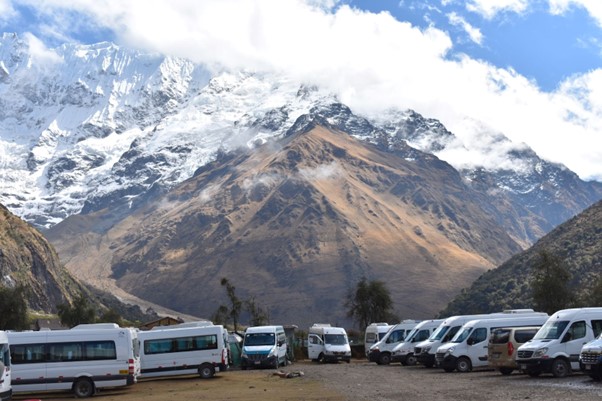
Buses at Soraypampa camp.
Day 2: Soraypampa / Salkantaypampa – Soyrococha – Abra Salkantay / El Passo – Huaracmachay – Colpapampa
- Total trek distance: ~ 22km / 13.67 miles
- Total time walking: ~7 hours
Day two is the longest ascent, so prepare to be challenged.
After waking early, you will begin the trek from Soraypampa / Salkantaypampa to Soyrococha (4,600m / 15,091 ft). This stretch takes about 2-2.5 hours. It starts gradually and gets steeper.
After about an hour of trekking, the trail begins zigzagging. These switchbacks are called the 7 Culebras (7 snakes), making this one of the toughest parts of the trail.
Many guides refer to this section as the ‘Gringo Killer’. Don’t let that scare you! In the cool hours of the morning, the ascent is totally manageable if you take it slow. After my trek, my entire group agreed that the slope was not as difficult as it had been made out to be.
Please Note: There is an option to ride a mule or horse up this section (at an extra cost of 100 soles). If you are already struggling with the altitude, consider taking this ‘mountain taxi’ for the rest of the way up.
At the top of the Culebras, you might notice that the temperature is cooler. Wear a hat and sunscreen as the sun is more intense at this altitude.
The views of Salkantay from here onwards are breathtaking. Make sure you have enough film and battery life. After this, you will reach Soyrococha before 10 am.
You might be exhausted as the air is thin at this altitude. There is still a significant climb ahead, so dig deep in your reserves!
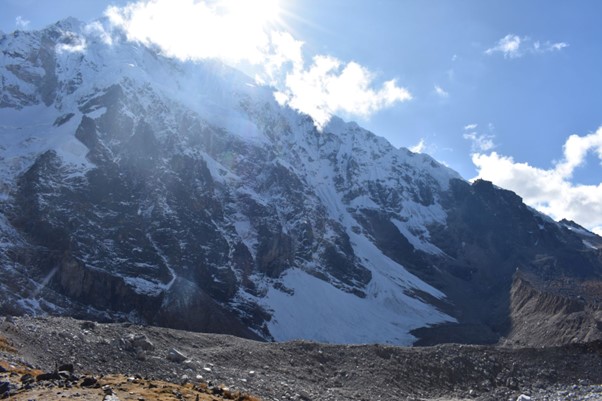
Salkantay Mountain
You will continue for another hour upwards, with Salkantay on your right. Finally, you will reach the Salkantay Pass (4,630m / 15,190 ft). You can enjoy the feeling of immense satisfaction and pride at this exquisite height.
On a clear day, you will get amazing views of Salkantay Mountain to your right and Humantay Mountain (5,917m / 19,413 ft) to your left.
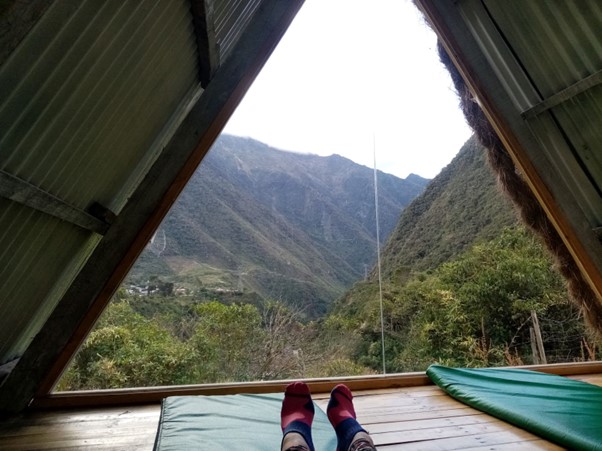
One of many camps at Chaullay. You can enjoy a well-deserved rest here after a mammoth day of trekking!
Here’s the good news. From the Salkantay Pass, it is all downhill. You will descend 2-3 hours to Wayraqmacchay (3,912m / 12,834 ft) for a lunch break. It is possible to stay overnight here. However, most tours continue further for 3 more hours down to Chaullay (2,920m / 9,580 ft) or Collpapampa (2,850m / 9,350 ft).
As you get lower in the valley, you will notice that the landscape changes dramatically. Andean mountain terrain becomes a lush tropical forest.
Day 3: Collpapampa - La Playa
- Total trek distance: ~18km / 11.19 miles
Day 3 is considered fairly easy-going. You may even rise later than usual to depart from the campsite at Collpapampa.
There are some ascents at the beginning of the hike. However, most of the trail is along even ground towards Playa Sahauyaco (2,064m / 6,771 ft). The route is a little more populated than the earlier trails. The area sits firmly within the tropical forest zone.
Some friendly advice : douse yourself with insect repellent before you begin hiking. My legs looked like a war-zone, covered with bites from nasty little sandflies.
Playa Sahauyaco is a small campsite bordering the Salkantay River and the Santa Teresa Valley. With that said, it is a lot bigger than any of the other campsites you would have stayed at. For this reason, some trekking companies like to continue on for 30 minutes to Lucmabamba. Other trekkers catch a minibus to Santa Teresa .
You should reach your camp by lunchtime. Some companies include a short coffee tour before or after your meal.
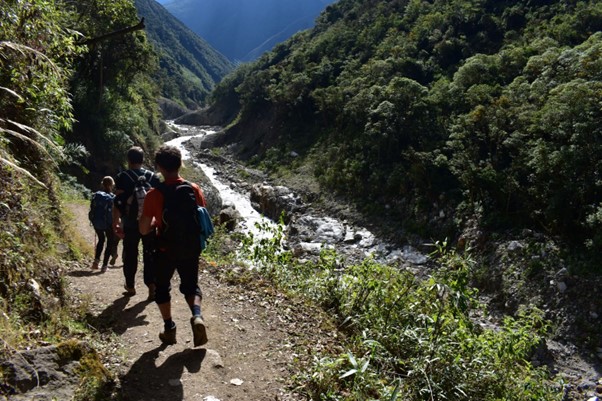
Jungle trail along the river on Day 3 of the Salkantay Trek.
Day 4: La Playa – Hidroeléctrica – Aguas Calientes
- Total trekking distance: ~17 km / 10.56 miles
- Total time walking: ~7 hours
Some companies offer Day 3 activities on the morning of Day 4. After these activities, tour groups are then transported directly to Hidroeléctrica (1,890m / 6,200 ft).
However, it is more common to trek over the mountain on Day 4. You will then arrive at Hidroeléctrica on foot.
Wake up early and hike from Playa Sahauyaco or Santa Teresa through aromatic coffee plantations. This is a long and challenging hike uphill. Some of this trail goes up the original Incan steps.
The views from the lookout points are spectacular and you will see flocks of green parrots along the way.
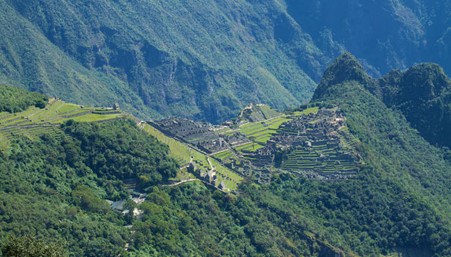
First view of Machu Picchu in the saddle.
It will take you around two hours to reach the viewpoint of Machu Picchu. Do not skip this lookout! You can catch your first glimpse of the ancient city - nestled between the Huayna Picchu and Machu Picchu mountains in the distance.
From the top, it is around 20 minutes down the mountain to the Llactapata Ruins (2,702m / 8,864 ft). The site is still covered by vegetation in some areas. It gives a good sense of what Machu Picchu must have looked like when Hiram Bingham stumbled upon it in 1911.
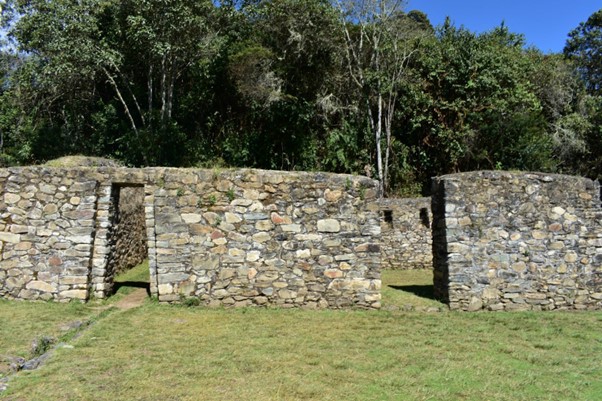
The route descends steeply for 2 hours from the site to the Hidroeléctrica Station.
Here, you will stop for lunch before catching the train (which costs about $25) or trekking another 2-3 hours (10km / 6.2 mi) along the rails to Aguas Calientes.
See more in our guide on how to travel to Machu Picchu .
Where to stay? Here are 5 of my favourite accommodation options in Cusco:
- Sonesta Hotel
- Antigua Casona San Blas
- El Mariscal Cusco
- Hotel Paradis
- Quechua Hostel Recoleta
See more Cusco accommodation options .
Day 5: Aguas Calientes – Machu Picchu – Cusco
Aguas Calientes (2,040m / 6,693 ft) is the town that sits below Machu Picchu. You will stay overnight here in a hotel – ah, a real bed and shower! The next morning, you will make your way to Machu Picchu.
See more in our guide on best Machu Picchu hotels in Aguas Calientes .
From Aguas Calientes, there are buses that run regularly up and down between the town and Machu Picchu (2,430m / 7,972 ft).
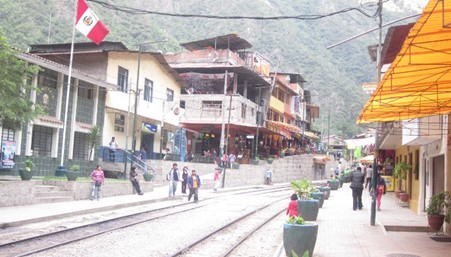
Aguas Calientes, the town below Machu Picchu (often referred to as Machu Picchu town).
The first bus departs around 05:30 and tickets cost about $12 each way. Queues for buses can start before 05:00 during the peak trekking season (May-September), so get there early. A one-way bus trip takes 30 minutes.
It is also possible to walk up to Machu Picchu. This takes a good hour and a half and involves scaling over 1,700 steps!
For many, it is a goal to witness the sunrise from Machu Picchu’s Sun Gate (Inti Punku) situated at 2,730m / 8,956 ft). You will need to get one of the first buses to the Citadel and then briskly walk up the trail leading to the Sun Gate. It is well marked and takes about 45 minutes at a good pace.
The view of Machu Picchu from Inti Punku (the Gate of the Sun).
Please remember your passport and your ticket as you will need them to enter Machu Picchu. If you have booked the Salkantay trek with a company, you will have a 2-hour tour around Machu Picchu with your guide.
After the general circuit, you will have free time to explore Machu Picchu . The route you take depends on your ticket. You may also have booked a hike up one of the mountain viewpoints.
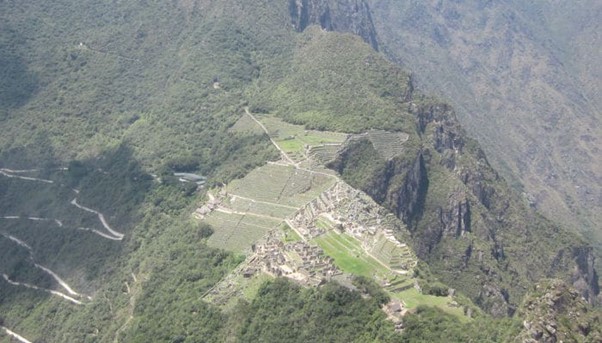
The view of Machu Picchu from Huayna Picchu (aka Wayna Picchu or Wayna Pikchu).
You need to book early if you want to climb Huayna Picchu. Machu Picchu Mountain is less popular but equally challenging. Permits are also required, so make sure you book well in advance.
When you finish exploring Machu Picchu, you can either walk back down to Aguas Calientes (which takes about 1 hour) or catch a bus. Buses depart regularly, but expect queues during and just after lunchtime. This is when most trekkers head back to catch trains to Cusco.
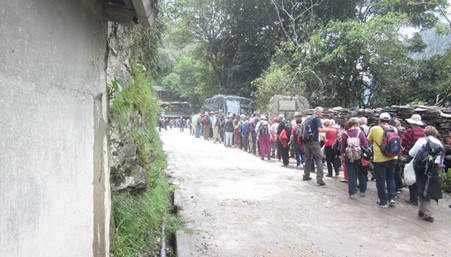
Queues for buses at Machu Picchu start forming around lunchtime and waits can be as long as an hour on bad days.
If you are with an organised tour, you will likely have train tickets booked for Ollantaytambo (2,792m / 9,160 ft). From Ollantaytambo, you will catch a minibus / private car back to Cusco, which takes approximately 1.5 hours.
If your tour doesn’t include the train (i.e., you booked the ‘return by car’ option), you will need to walk back along the rails to Hidroeléctrica. This will take another 2-3 hours.
From Hidroeléctrica, the van ride to Cusco is 7-8 hours with a stop for a snack. I highly recommend taking motion sickness tablets for this windy ride.
Other Things to Do During the Salkantay Trek
Many Salkantay Trek companies also offer additional activity options.
Whether you're looking for adventure or relaxation, there's something for everyone venturing along the Salkantay trek.
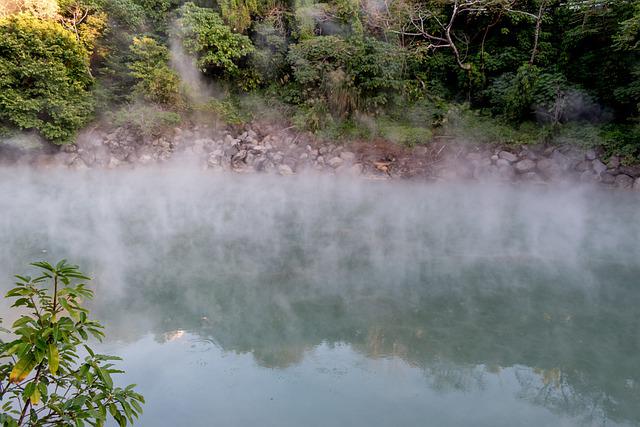
Option 1: Hot Springs in Colcamayu
The first option is the most relaxing. Particularly if you are feeling shattered after 3 days of hiking. A bus will take you to the thermal baths in Colcamayu. This is roughly a 45-minute drive from the town of Santa Teresa.
Spend a few hours soaking your sore muscles whilst enjoying jungle surroundings. You may want to take extra cash for cocktails.
Price Range: ~50 soles / $16 (including transport)
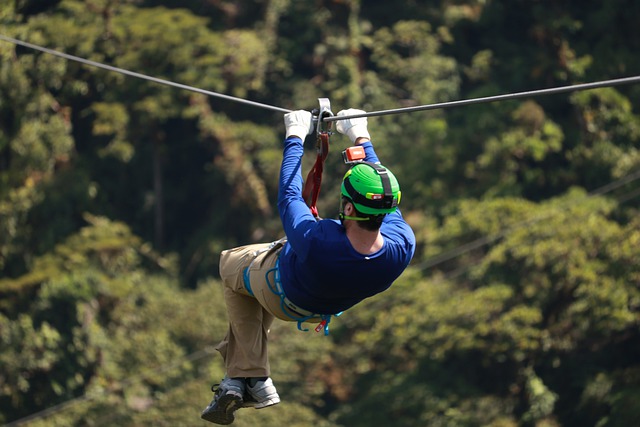
Option 2: Zip-lining at Cola de Mono
This option is for adrenaline-seekers. Trekkers are transported to Cola de Mono, the site of South America’s highest zip-line.
Here you will fly down 5 different lines between 12 platforms. The steel cables are approximately 250 meters (820 feet) above the ground.
Price Range: ~100 soles / $30
What is The Salkantay / Inca Combo?
The Salkantay / Inca Trail Combo combines the best of both worlds. This is where the extraordinary mountain scenery of the Salkantay Trail meets the authenticity of the Classic Inca Trail.
Although the route has a similar first day to the Salkantay Trail, it soon departs from the Classic route by heading east around Salkantay. The route is longer and more challenging than the classic Salkantay trek. It is typically completed on a 7D/6N itinerary. It is sometimes called the 7-Day Inca Trail and requires an Inca Trail permit.
See more in our guide on the full itinerary for the Salkantay-Inca Trail .
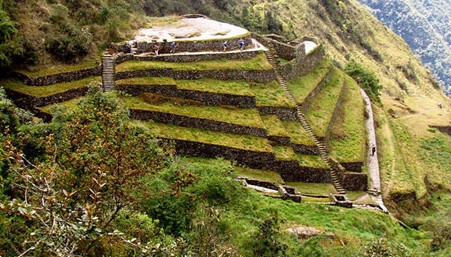
Salkantay Trek Altitude Profile
Here are some more details about the route followed on a typical Salkantay trek. After most trekkers reach Soraypampa, the trail tends to split in western and eastern directions depending on the trekking itinerary.
The Western trail follows the Salkantay trail up and over El Paso and around Playa Sahauyaco. The Eastern trail showcases the Salkantay / Inca Trail Comb trek by climbing over the Incachiriasca Pass to join the Classic Inca Trail at Wayllabamba (3,000m / 9,842 ft).
There are also some excellent route maps available in the Trailblazer Inca Trail Guidebook .
Here is our handy altitude profile for the Salkantay Trek. As you can see below, the first two days are tough. After this, the gradient evens out from Chaullay onwards.
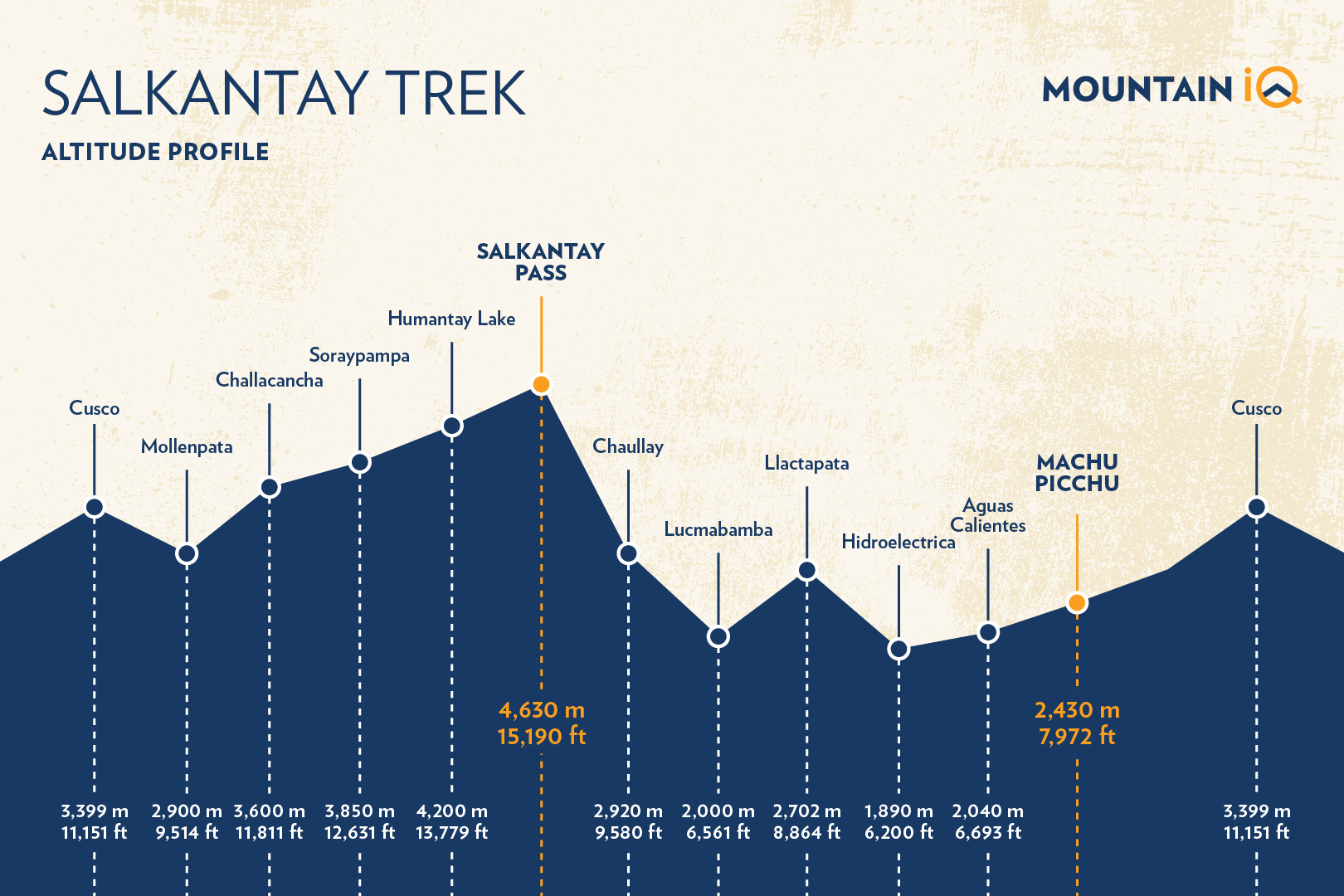
When Is the Best Time to Do the Salkantay Trek?
There are two main seasons in the subtropical Peruvian Andes:
- The dry season, which runs from late April through to early October.
- The wet season, which starts around mid or late October and draws to a close in April.
The peak trekking season to Machu Picchu occurs during the dry season. The Inca Trail is very busy during these months and permits sell out months in advance.
Those who don’t get permits for the Inca Trail typically overflow onto the Salkantay trail or the Lares trail . This means that between May and September, the Salkantay route can be busy.
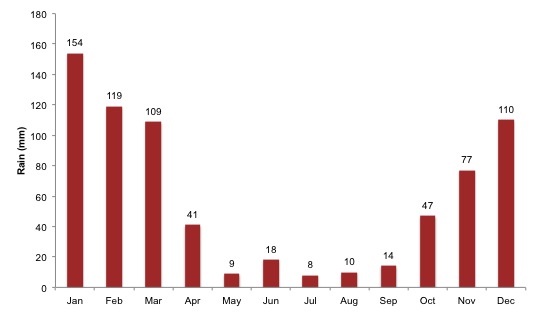
That being said, you will not get a sense of overcrowding which can be the case on the Inca Trail. There are usually around 6 groups (8-20 people each) hiking the trail at a time on the Salkantay. These are spread out as groups start the day at different times and walk at different paces, which still allows you some tranquility during your trek.
Technically speaking, the Salkantay trek can be completed all year round. Although, I highly recommend avoiding the months of December, January, and February. This is when rainy days are the norm, which can make trekking extremely dangerous due to landslide risk.
The best trekking times run from the shoulder wet months (March / April). Good weather continues up to the shoulder dry months (October / November).
Temperatures throughout the year follow a very consistent pattern. The days are warm, reaching the high twenties in Celsius (70-80°F). The nights and early mornings are cold. After dark, temperatures are usually single digits and sometimes go below 0°C (32°F).
Temperature fluctuation is further exacerbated by the dominant micro-climates in the region. The first night is particularly icy below Salkantay Mountain. It gets warmer as you descend into the tropical forest on the following days.
Layering your clothes is key to staying comfortable throughout your trek. See more in our equipment packing list section below for details on ideal clothing requirements for the Salkantay trek.
Full charts on historic weather patterns in and around Machu Picchu can be seen here .
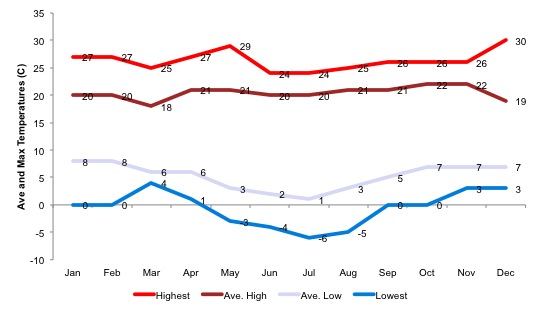
What To Know Before Hiking the Salkantay Trek
Acclimatization and altitude sickness on the salkantay trek.
The Salkantay trek is a high-altitude hike and comes with altitude sickness risks.
The highest altitude that you will reach on this trek is just over 4,600m / 15,092 ft) (4,900m / 16,076 ft if you do the Salkantay / Inca Trail Combo). This might be the highest altitude you have ever gone to outside of an airplane, which is remarkable when you think about it.
At this altitude, available oxygen per breath is nearly 45% less than what is available at sea level. This results in a number of physiological impacts.
It is difficult to predict how a higher altitude will personally affect you. There is very little correlation between altitude sickness symptoms and age, fitness, or gender.
However, we do know that going too high too fast is a key determinant of altitude sickness. Given enough time and adequate spacing, the body can adapt to higher and higher altitudes – this is called acclimatisation.
The trouble with treks to Machu Picchu is that most, if not all trekkers, start their journey from Cusco (3,399m / 11,151 ft). This city is already at a high altitude, making the potential of altitude sickness even greater.
It is important that you spend a few days (2 at a minimum) acclimatising in Cusco. You could also stay in the Sacred Valley before starting your trek. This area is nearly 1,000m / 3,281 ft below Cusco.
See more in our guide on acclimatisation and altitude sickness .
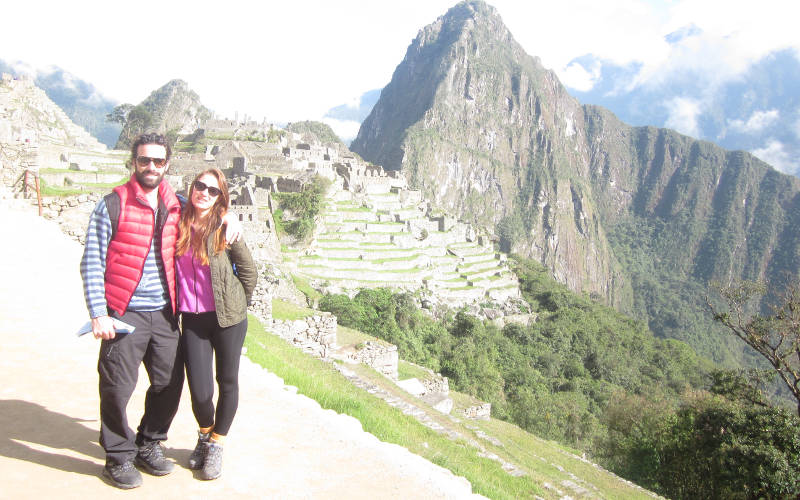
What Do I Pack for the Salkantay Trek?
There are a few key equipment items that you will need to take with you on your Salkantay trek.
I have written a very comprehensive packing list for the Inca Trail . This checklist is identical to what is needed for the Salkantay trek.
The only key difference is that mules are used to carry gear on the Salkantay trek instead of porters like on the classic Inca Trail.
The weight distribution between porters and mules is very similar. You will be given a tog bag and allowed to pack up to 5kg / 11 lbs. (7kg / 15.4 lbs. including a sleeping bag).
Basically, you will be packing a few changes of clothes and your toiletries. Include a small towel and warm layers for the evenings.
During the day, you will be carrying a daypack. This should contain your waterproof jacket, camera, snacks, hat, sunscreen, and other essentials.
Please Note: Don't pack anything delicate as the bags get fastened onto the mules and your items could be crushed.
Do I Need to Train for the Salkantay Trek?
The Salkantay trek is a moderate to tough hike, so you don’t need to be super-fit or a marathon runner. However, you should be in relatively good shape all the same. It will help to train for a few months before arriving in Cusco.
The best type of training you can do is aerobic cardiovascular exercise. This includes long-distance jogging, swimming, or cycling. Click here to read our hiking training program . This provides some useful guidance on how best to prepare for the Salkantay trek.
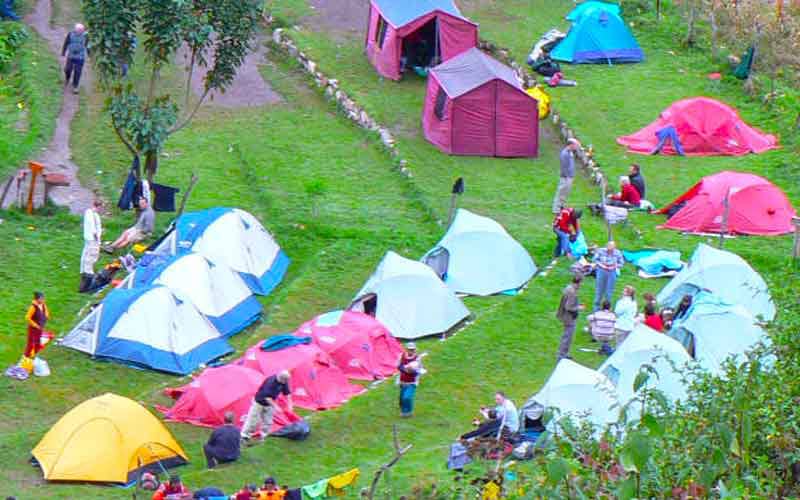
Are There Toilets and Showers On The Salkantay Trek?
The Salkantay Trek goes through small villages and rural areas. Along the way, at regular intervals, you will find flushing toilets that you can pay 1 sole to use. Most of these bathrooms are fairly clean but don’t expect to find toilet seats or toilet paper. Be sure to pack a toilet roll in your backpack.
There are showers at almost every camp, particularly as you head towards Machu Picchu. Most of these are fairly basic and only have cold water. At some campsites, it is possible to pay up to 10 soles to have a hot shower.
- Hotel Paradis
- Quechua Hostel Recoleta
Is There Drinking Water On The Salkantay Trek?
It is not advisable to drink water along the trail. Rivers in this area pass through communities and there are many animals around. It’s better to be safe than sorry with drinking water on the Salkantay Trek.
If you have booked with a more expensive tour company, the chefs will boil water to refill your bottles each day. Budget Salkantay companies do not provide water.
You will have loads of opportunities to buy bottles of water at camps and along the trail. However, these are sold with a huge markup. A 1-litre bottle of water will cost between 6-10 soles. This adds up quickly if you are traveling on a tight budget.
I recommend being prepared and bringing a water bottle with a filter attached. Purification tablets are usually okay but are not 100% effective in every case, making filters more reliable.
Either way, fill up your bottle from high in the catchment or where the water is clean and flowing well. Never take water from below houses or where grazing animals are located.
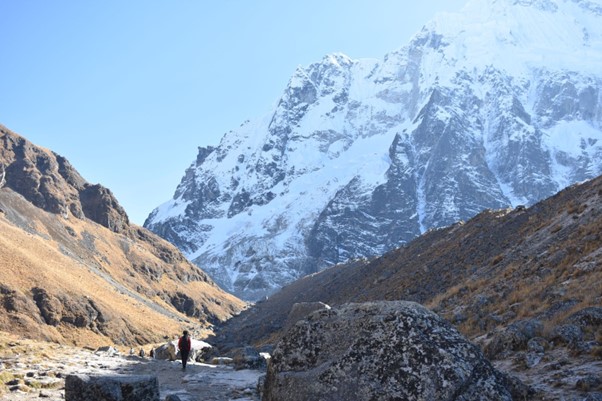
How Much Does The Salkantay Trek Cost?
Like most treks to Machu Picchu, the costs vary quite dramatically. Here is a brief overview of the types of operators you will come across and their prices:
- Local Operators: $250-600 per person
- International Trek Operators: $400-$700 per person
- Private / Luxury Salkantay Treks: $800-$2000 per person
When it comes to local operators, it is important to note the quality of treks. There are huge variations in terms of service, equipment, guiding, facilities, and safety.
There are over 200 local trekking companies in Cusco alone. Generally, they are split into two types:
- Cheap local operators
- Responsible local operators
Cheap Local Operators
At the bottom of the market are the cheap local operators. These guys often cut corners and pay questionable wages to their staff. Their services often don’t stack up to their promises.
Cheap operators base prices on large groups of up to 16 trekkers. If they don’t reach this number, they will combine treks with another company.
Booking with a cheap operator doesn’t necessarily mean that you will have a bad experience. But the likelihood of poor service is much higher. If it sounds too good to be true, it probably is.
Prices for this type of operator often exclude certain key tour items. Usually, these are the bus tickets to Machu Picchu and return train tickets. Make sure you check what is included beforehand.
Responsible Local Operators
There are a number of great local trekking companies. These companies offer excellent services and run responsible operations.
Finding a responsible trekking company for the Salkantay Trail can be tough. I have picked out some of my favourite Salkantay trekking companies .
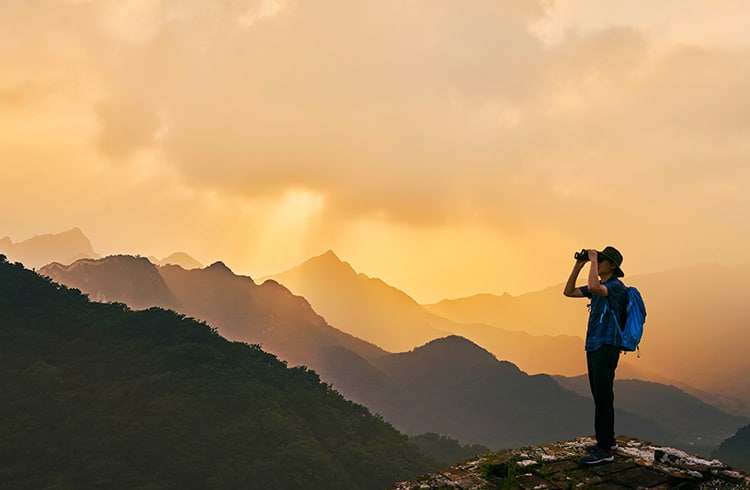
World Nomads has you covered so you can trek worry-free
Do You Need Insurance For The Salkantay Trek?
Insurance for your trek to Machu Picchu is a must. Most operators will require you to carry sufficient travel insurance for your trek.
As most trails to Machu Picchu go over high 4,000m / 13,123 ft passes, you will need to make sure your insurance covers you for high-altitude hiking (up to 6,000m / 19,685 ft).
We have reviewed a number of travel insurance providers and the most affordable and best by far is World Nomads .
I hope that I have answered many of your questions about the Salkantay trek. If you have any unanswered questions, please leave a comment below and we will respond within 24 hours.
Please feel free to share this page with friends and family or link to it from your blog. We always appreciate a shout-out on your social media page!
We very much welcome questions or feedback so that we can keep this article up to date. Thanks!
Tags: Salkantay Trek, Salkantay Trail, Salkantay Trekking, Salkantay Trek to Machu Picchu, Salkantay Trek Peru, Camino Salkantay, Salkantay Pass, Salkantay Peru, Salkantay Trail Peru, Salcantay trail
Alison Macallister
With a degree in Nature Conservation and experience working with wildlife including the Big 5, Alison works as a guide for a 5-star reserve. She enjoys sharing her passion for all things nature-related. She enjoys hiking, horseriding, 4x4 driving and kayaking.
Leave a Reply
Your email address will not be published. Required fields are marked
Name * * * *
Email * * * *
Hi! I’m currently looking into doing the Salkantay trek at either half November or half December (around the 15th). I will be in Peru from the beginning of next week, so I could fly from Lima to Cuzco and do this trek at the beginning of my trip. Or, I will end with it, after traveling around for four months. I’m very worried about the weather in December, but on the other hand don’t know if it is “smart” to start Peru with the Machu Picchu (because of the altitude). Furthermore, I don’t know if there are any tickets still available. What is your opinion? Hoping to hear from you and thank you for your time.
Hi Noa, The weather can be quite unpredictable in December – usually there is quite a bit of rain, but you may get a glorious week. The altitude risk is really highest in Cusco. I recommend spending a few days relaxing in Cusco or the Sacred Valley before hiking the Salkantay – that way you can pre-acclimatise for the Saklkantay pass, which is the highest altitude you will reach. You should still be able to secure Machu Picchu entrance tickets – but worth checking with a few operators now instead of booking last minute.
I found this and the initial article re the Salcantay walk exceptionally good and informative, and clarified a great deal. I am in my early sixties fit and have hiked in NZ and Nepal, and would loke to trek in south America , the Salkanty, and the O or W track in Chile, and this article was very encouraging in respect to my aspiration to trek solo or at least independently of a tour group. I'm also trying to marry this up, no pun intended with travelling with my wife who is no so keen on extended day treks . Could she possibly take the train to Aguas Calientes, so we could do the last part of the trek to Machu Pichu together , then travel back together on the train/bus ?
Hi Warren, thanks for your kind feedback. Yes, your wife could take the train to Aguas Calientes to meet you. She’ll obviously need to hang around Cusco for 3-4 days whilst you hike the Salkantay. From Aguas Calientes it’s a relatively short and easy walk up to Machu Picchu. Most people take a bus for this section, but you and your wife could easily walk. You’ll probably want to stay the night in Aguas Calientes on the day of arrival and then hike up to Machu Picchu, do a guided tour and then get a train back. Hope this helps!
Hi! Great article! I’m thinking think to travel to Peru in mid March-April or in November, since I work from May to October. What do you think is a better month for trekking? I’ve seen the ‘rain’ chart and it seems that April would be my best option; but, in terms of landscape, do you think it will be nicer in April, after rain season, or in November, after dry season? Also, I would like to leave my backpack in Cuzco so I don’t have to carry too much weight during the trail, do you think this is possible?
Thank you very much!
Hi Alex, I would go in April, this is a better month than March – weather-wise – and the scenery is great too. In terms of your backpack, almost all hotels offer a storage facility for hikers so you shouldn’t have a problem leaving it in Cusco. All the best!
Hi Alison, you've written a great blog about the Salcantay trail! So very helpful! Such a gift! A couple of questions: I'm 66, in shape but no marathoner, and am wondering if I'm a suitable candidate for this hike? I'm thinking of taking the 8 day Cusco & Salkantay Trekking to Machu Picchu with your recommended outfit, Inkayni travel. An ignorant question: how do I dial their number from the US (California)? Thank you so much! Lori
Hi Lori Thank you so much for the response. I’m glad to know the info is useful! Yes, you are absolutely OK to do this hike. Just be sure to spend a few days in Cusco acclimatizing to the altitude. Also, take it easy and drink lots of water and coca tea. I suffered a bit from altitude sickness on one of my early hikes in Peru, it doesn’t discriminate by age and fitness level!
I have personally never tried dialing Peru from the USA but I believe you need to Dial 011 51 933 839 757. Hopefully that works.
Have an amazing trip!
Wow ! All great information ! Do I nedd to make some camp site reservation if i'll like to hike de Salkantay by my own? For a first experience, do you recommed with a guide tour or I can organise everything by my own? Thnaks
Hi Odrey, you are most welcome! From my experience, camp site reservations are not usually necessary. However, this trail gets busier every year and things change. If you can track down a number for camping/ accommodation, I’d say try to call. Of course you can do it on your own (it’s very manageable and the trail is easy enough to follow) but I sometimes find it’s nice to hike with a group. The social aspect is fun plus it takes away all the stress of planning. It’s up to you and depends on your travel style but, if it’s your first multi-day trek and you don’t speak any Spanish, I’d lean towards the guided option. If you do want to enquire about guided trips, I’d recommend checking out Skyhook Adventures. Hope that helps!
Get a quote from our recommended local trek operator in Peru
Get a Machu Picchu trek quote
Best Local Guides. Great Value Hikes.
- Just Me
- Me + 1
- Me + 2
- Me + 3
- Me + 4
- Me + 5
- More than 6

Ultimate Guide to the Salkantay Trek to Machu Picchu
The 5 day Salkantay Trek is one of the best alternative trails to Machu Picchu in Peru.
It takes you to stunning glacier lakes and across snow-capped mountain passes. Along the way, you’ll enter cloud forests, walk ancient Inca pathways, and reach Peru’s most famous landmark, Machu Picchu.
I did the Salkantay Trek in July 2023 and was blown away by its beauty.
Yes, it’s a challenging hike. But it’s also incredibly rewarding.
Here’s everything you need to know about the Salkantay Trek, including what to expect along the way and how hard it is. I also share why I chose the Salkantay Trek vs Inca Trail and whether it was really worth it.
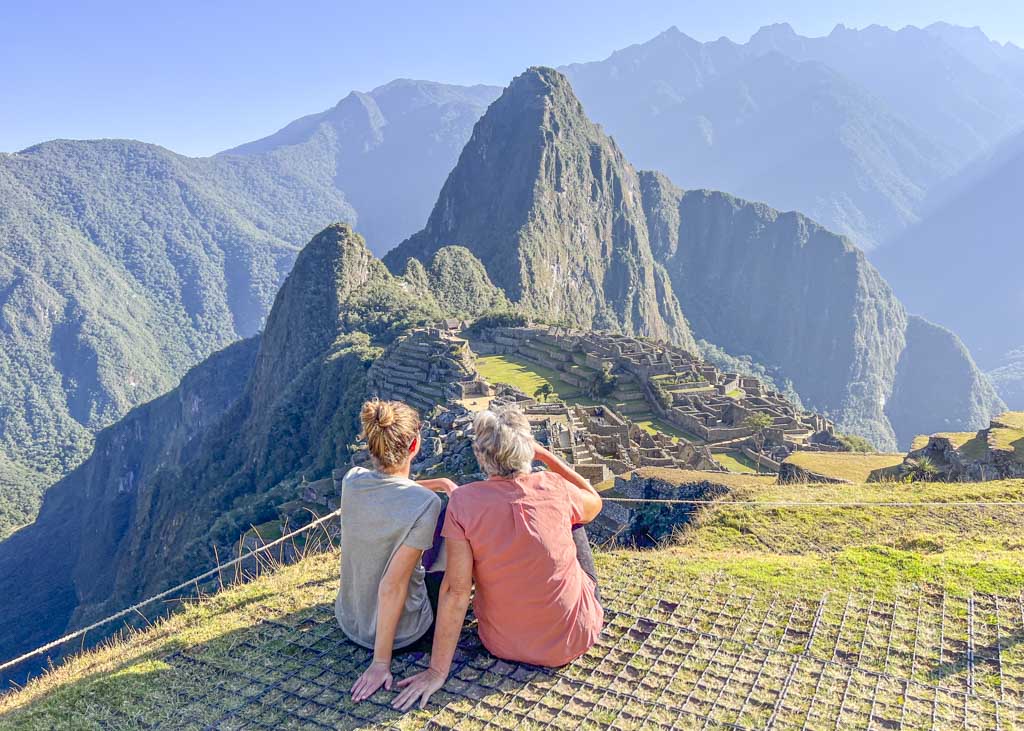
Quick Navigation
Salkantay Trek overview
- Total distance: 74 km
- Time needed: 5 days (the 5th day is at Machu Picchu)
- Highest point: 4,630 m at the Salkantay Pass
- Difficulty: Challenging
- Starting point: Cusco
What is the Salkantay Trek
The classic Salkantay Trek is a 5 day hike to Machu Picchu. Named after the Salkantay Mountain, it’s one of the most scenic trails through the Peruvian Andes.
It’s easily accessible from Cusco (I recommend staying here in Cusco before the trek), but the trailhead officially starts in Soraypampa, a 3-hour drive away.
The Salkantay Trek lies in the shadow of the more famous Inca Trail. But the two offer a very different experience.
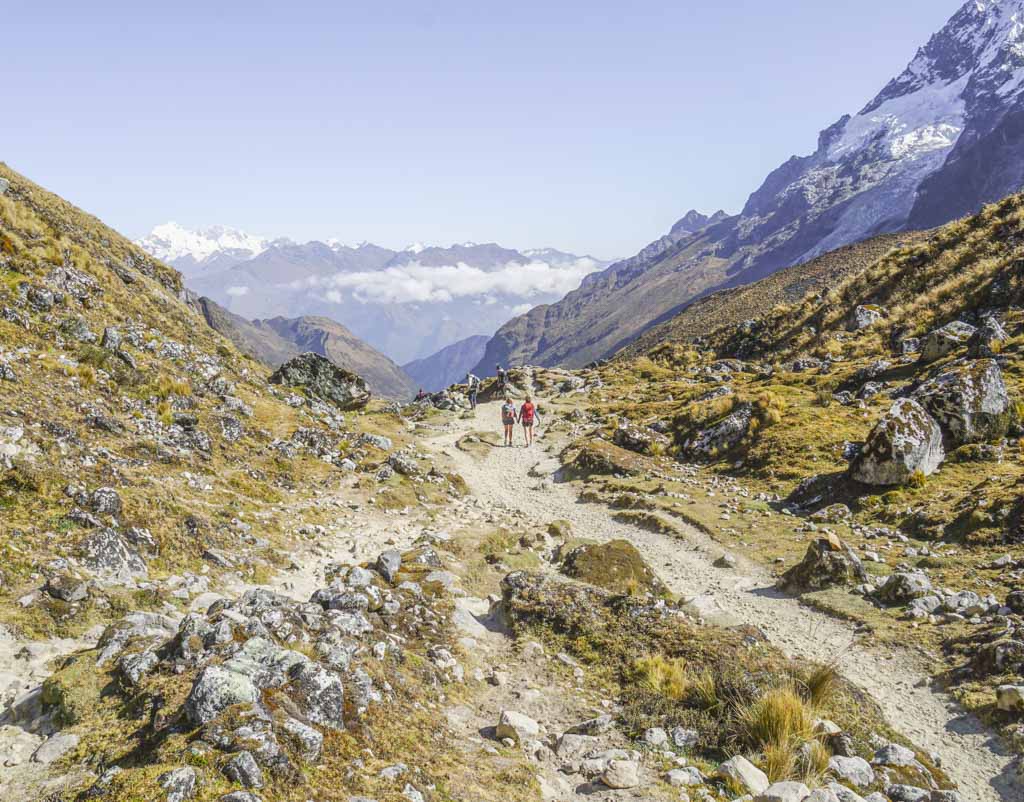
Salkantay Trek vs Inca Trail
The Salkantay Trek is a popular alternative hike to Machu Picchu.
Below are a few differences and why I chose to hike the Salkantay Trek to Machu Picchu (instead of the Inca Trail).
1. The scenery & archaeology
The Salkantay Trek is said to be the most beautiful of the two hikes. It takes you over the mountains and crosses diverse landscapes.
It’s also a higher altitude trek that reaches 4,630 m above sea level. However, you only see ruins and authentic Inca pathways on day 4 of the Salkantay Trek.
2. Tour costs & availability
There are no restrictions to the number of hikers on the Salkantay Trek. This makes it a great option for travelers who don’t have fixed dates yet or who missed out on the Inca Trail.
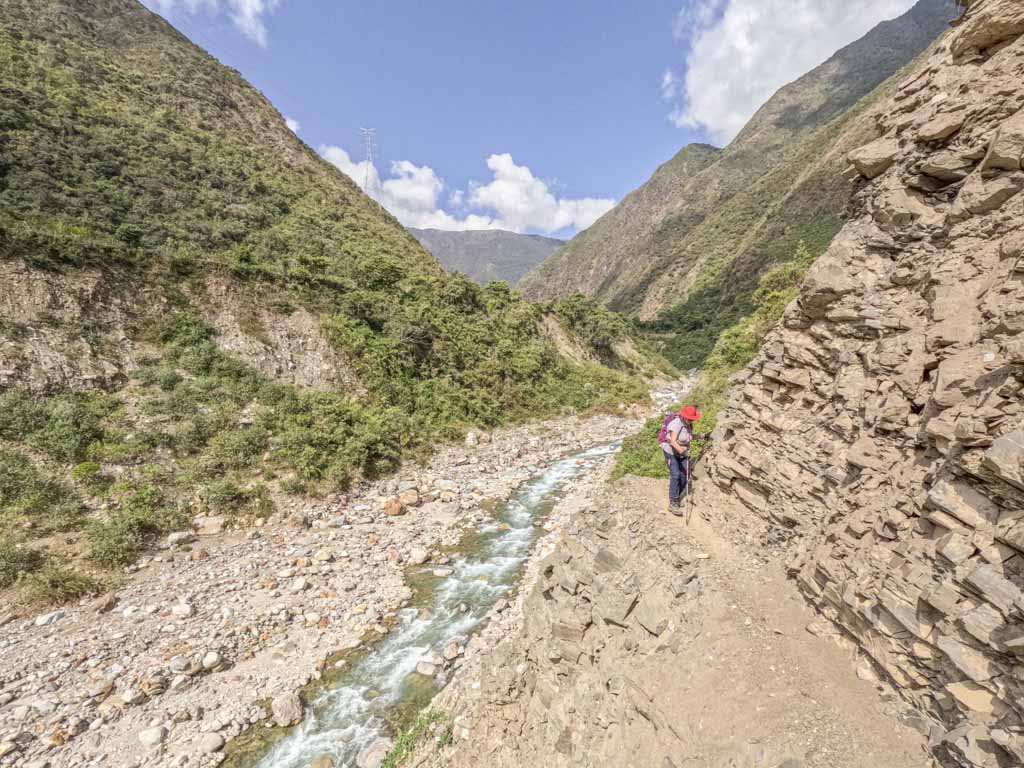
3. Difficulty
The Salkantay Trek is known to be harder than the Inca Trail.
This is due to the higher elevation, the challenging mountain terrain, and the total walking distance, which is 74 km on the Salkantay Trail vs 42 km on the Inca Trail.
4. Arrival at Machu Picchu
The Salkantay Trek does not actually end at Machu Picchu. Instead, you finish in Aguas Calientes, the closest town to Machu Picchu.
Your last night is at a hotel in this town, and you’ll visit Machu Picchu the next day. You can either take a bus or walk to the main entrance. But regardless, you’ll be joined by every tourist going to the famous site.
With the Inca Trail, you follow the Inca’s route to the iconic Sun Gate before hiking down to the lost city of Machu Picchu.
But there’s a lot more to consider when deciding which to choose. I recommend reading my blog post comparing the Inca Trail to the Salkantay trek.
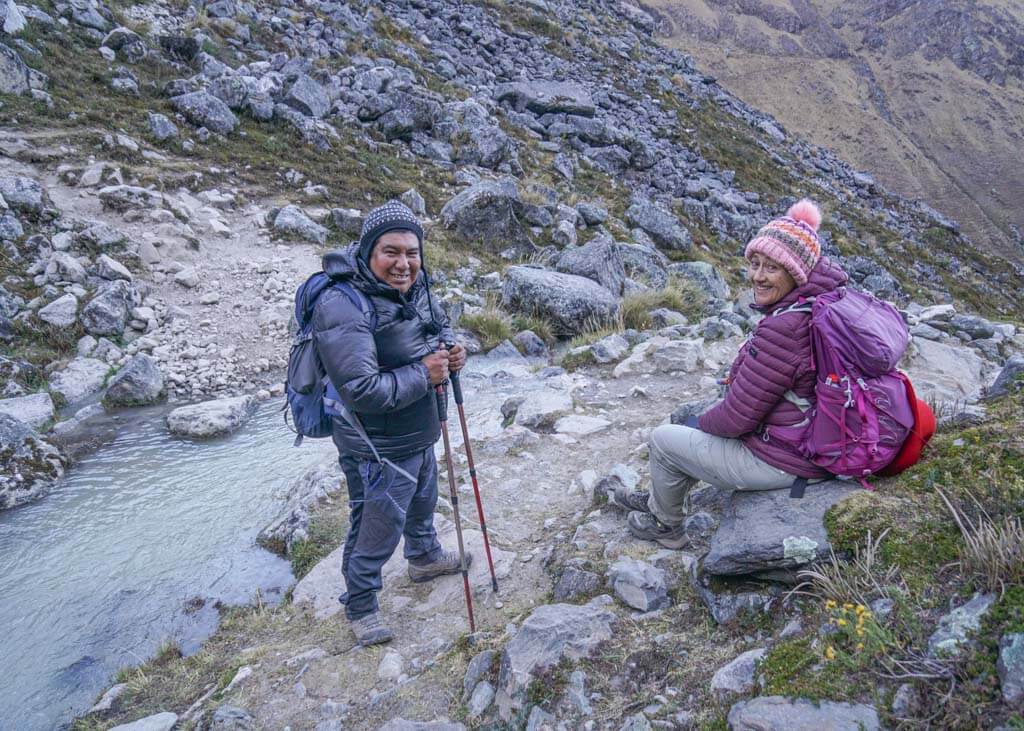
How long is the Salkantay Trek
There are two options for doing the Salkantay Trek: a 5 day tour or a 4 day tour.
With both of these, you’ll spend the last day exploring Machu Picchu.
5 day Salkantay Trek
The most popular Salkantay Trek itinerary is a 5 day, 4 night hike. I chose this option and recommend you do the same.
This classic route takes you to all the iconic locations, including Humantay Lake, Salkantay Pass, and Llactapata Ruins.
During the 5 day Salkantay Trek, you walk the entire journey from the starting point in Soraypampa to Aguas Calientes town.
Top tip: From my experience, day 4 of the 5 day trek was extremely difficult but 100% worth it. This is the section you’ll miss if you do the 4 day tour. It’s the only day you actually walk parts of the Inca Trail, and the views from Llactapata are incredible.
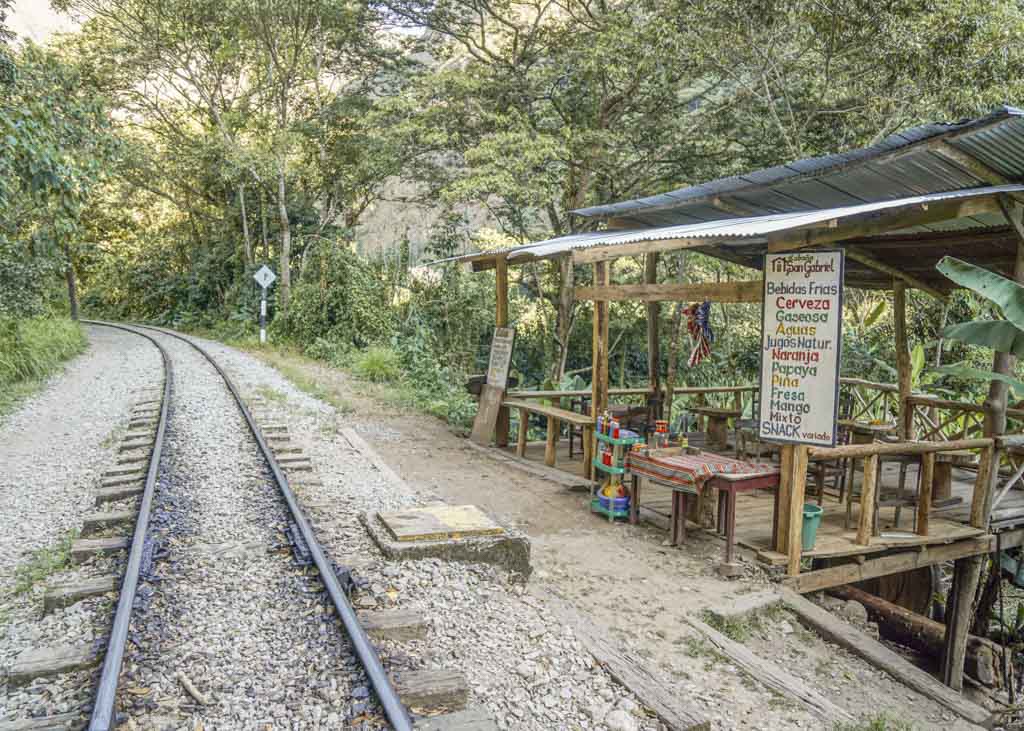
4 day Salkantay Trek
If you’re short on time, you can opt for the 4 day tour instead.
This is not the ideal option, but it’s still a fantastic tour if you don’t have much time in Peru.
Like the 5 day Salkantay Trek, the 4 day tour starts in Soraypampa and ends at Aguas Calientes.
So what’s the difference?
On day 3, you’ll walk most of the Salkantay Trail. At lunchtime, you’ll separate from the 5 day tour and take a bus to Hidroelectrica Train Station. From here, you’ll walk to Aguas Calientes.
This means you skip the Cocalmayo Hot Springs as well as the hike to Llactapata Ruins.
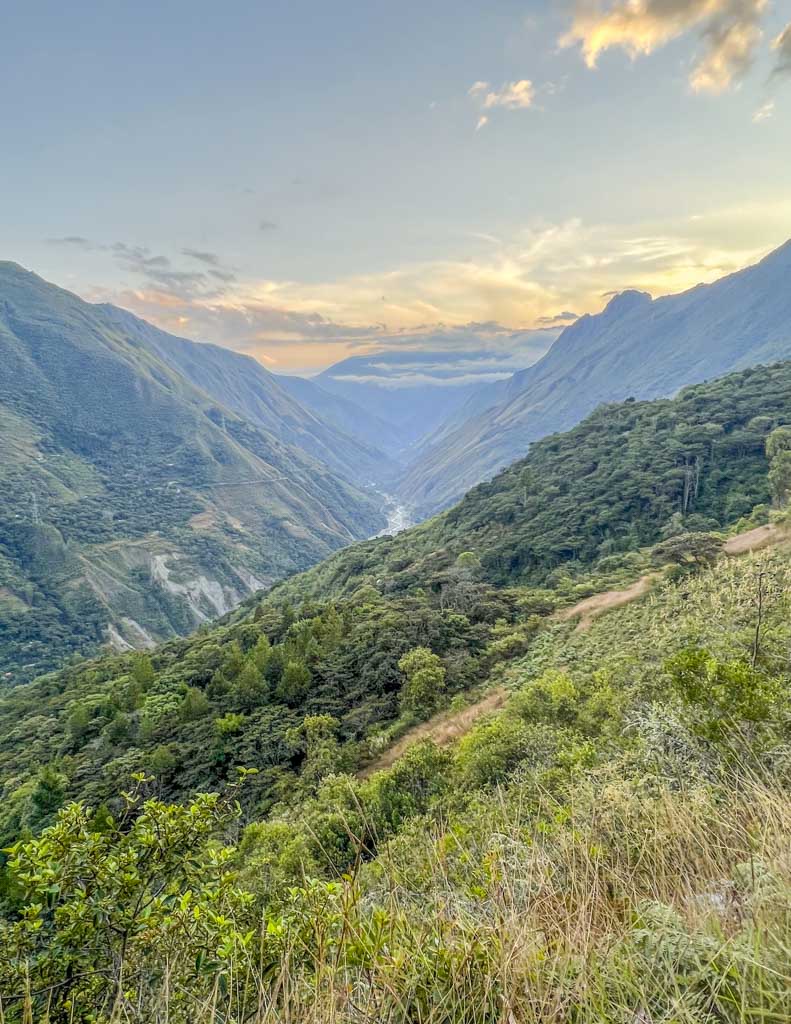
Things to know about the 5 Day Salkantay Trek to Machu Picchu
Here are a few things to consider if you’re planning on doing the Salkantay Trek.
Salkantay trek difficulty
The Salkantay trail is a difficult hike, but it’s achievable for most people.
So, what makes it difficult?
Firstly, the high altitude at the Salkantay Pass, which sits at 4,630 m.
The ascent up the pass is the hardest part of the trek. This is because there’s less oxygen in the air, and it’s a struggle to breathe.
As a result, you’ll walk very slowly, and you may experience symptoms of altitude sickness. The freezing cold temperatures don’t make it any easier.
Secondly, it’s a long distance to walk.
The Salkantay Trek to Machu Picchu is a 74 km trail, and you’re averaging 19 km per day over 4 days (because the last day is at Machu Picchu).
This, combined with the hilly terrain, only adds to its difficulty.
Here’s my post on how difficult the Salkantay Trek really is . It covers everything you need to know to get through the 5 day trek.
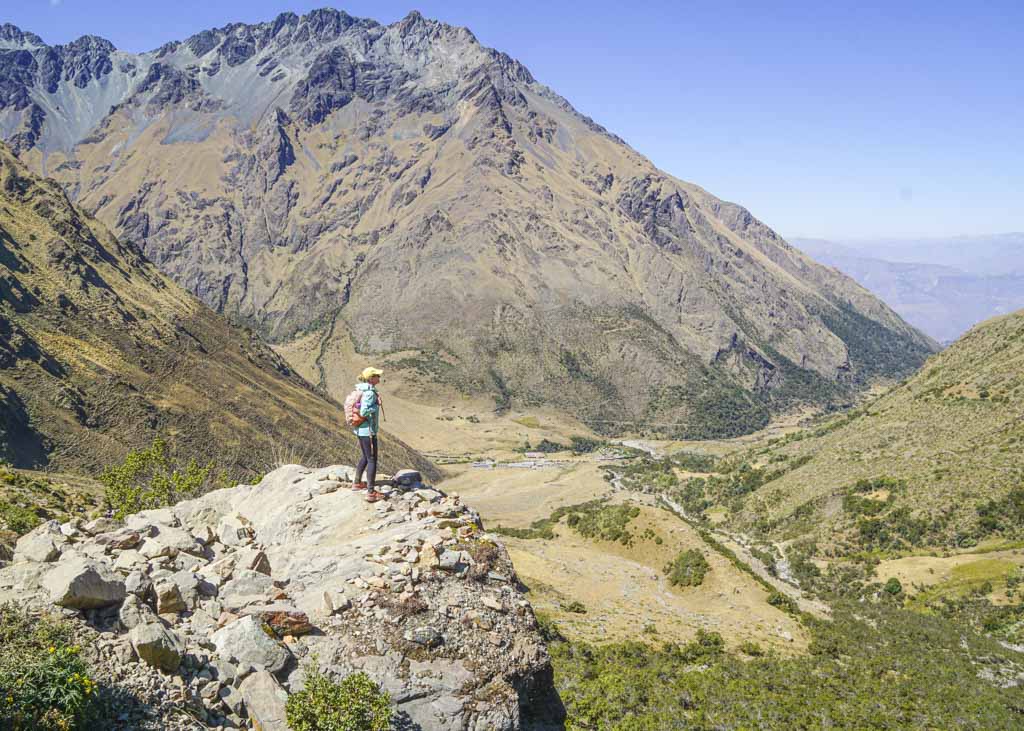
Best time to hike the Salkantay Trek
It’s possible to do the Salkantay Trek all year round.
But most tour operators don’t offer tours in February. This is because the route is often closed due to maintenance.
Here’s when you should plan your trip.
Dry Season: Best time to do the Salkantay Trail
Hiking season in Peru is from April to September.
During this time, you can expect clear skies and warmer temperatures. It’s a great time of year to be on the trails, and I recommend doing the Salkantay Trek during these months.
July and August is high season and the busiest time to visit Peru. The trails will be teeming with people, and Machu Picchu will be extremely crowded.
However, don’t be put off by this.
I did the Salkantay Trek in July and had a great time. But make sure you get to Machu Picchu early in the day to avoid the crowds.
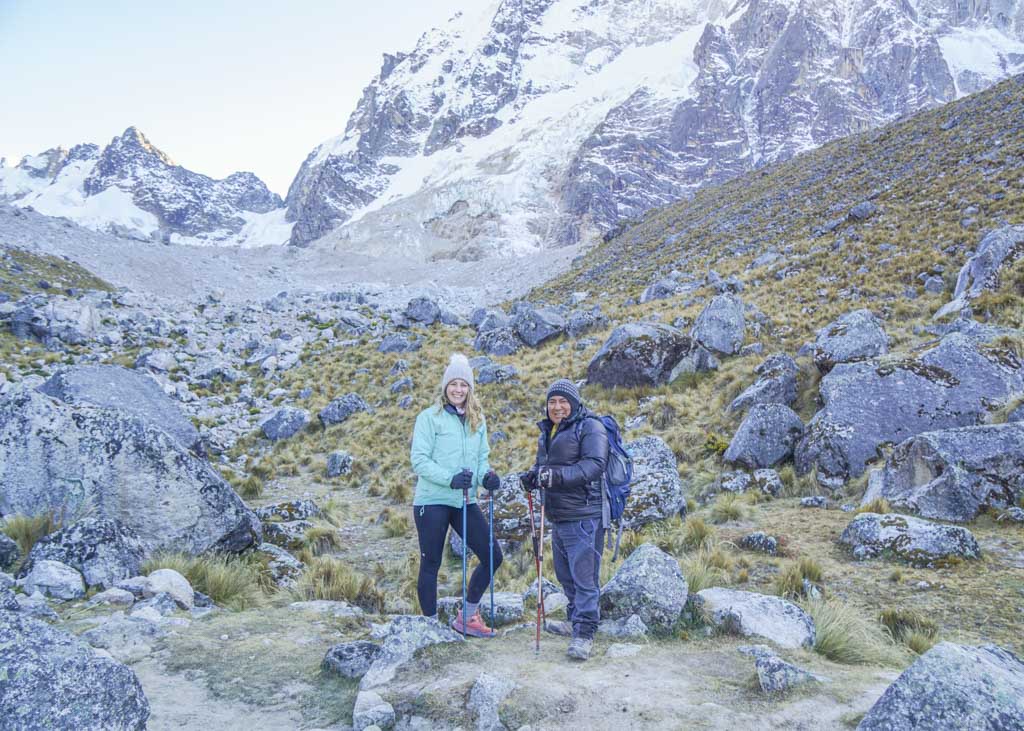
Rainy Season
The wet season is from December to March. The weather can be unpredictable during this time, and you should be prepared for a few days of rain.
This makes the Salkantay Trek more dangerous, especially as you go up the Salkantay Pass. There is also a greater chance of last-minute cancellations due to bad weather.
Packing for the Salkantay Trek
The most important thing to pack for the Salkantay Trek is your Passport. You need this to enter Machu Picchu and will not be allowed in without it.
In terms of hiking gear, most tour companies provide a small duffel bag to trekkers.
This will allow you to store up to 7 kg of your clothing and personal items for the trek.
Yes – there’s a 7kg weight limit, which includes you’re sleeping bag. This is not a lot, considering it’s a 5 day trek, so you need to pack lightly and smartly.
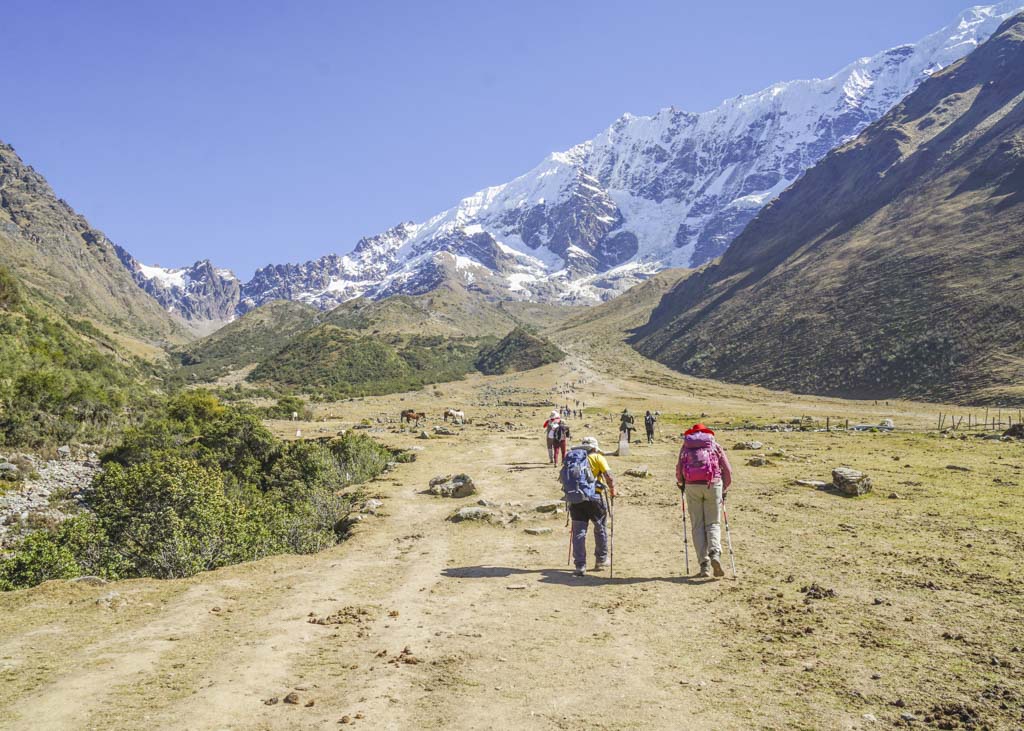
Accommodation along the Salkantay Trek
The accommodation along the Salkantay Trek differs between tour operators.
This ranges from basic and luxury camping to glass domes and cabins. Your last night is spent at a hotel in Aguas Calientes.
For most tours, there are no showers on the first night. But from night two onwards, you can treat yourself to magnificent hot showers.
My mom and I did the Salkantay Trek with Inkayni Peru Tours , and I highly recommend them.
We camped for the first three nights, but it was more like a glamping experience, and we were extremely comfortable.
Each day, we arrived at our campsite with our tents already set up and offered snacks and hot chocolate as a reward for getting through the day.
One positive about camping is that you have the option of staying higher up the Salkantay Pass on night one. This was a huge advantage as we got a head start to the day and had the Salkantay Pass all to ourselves for sunrise the next morning.
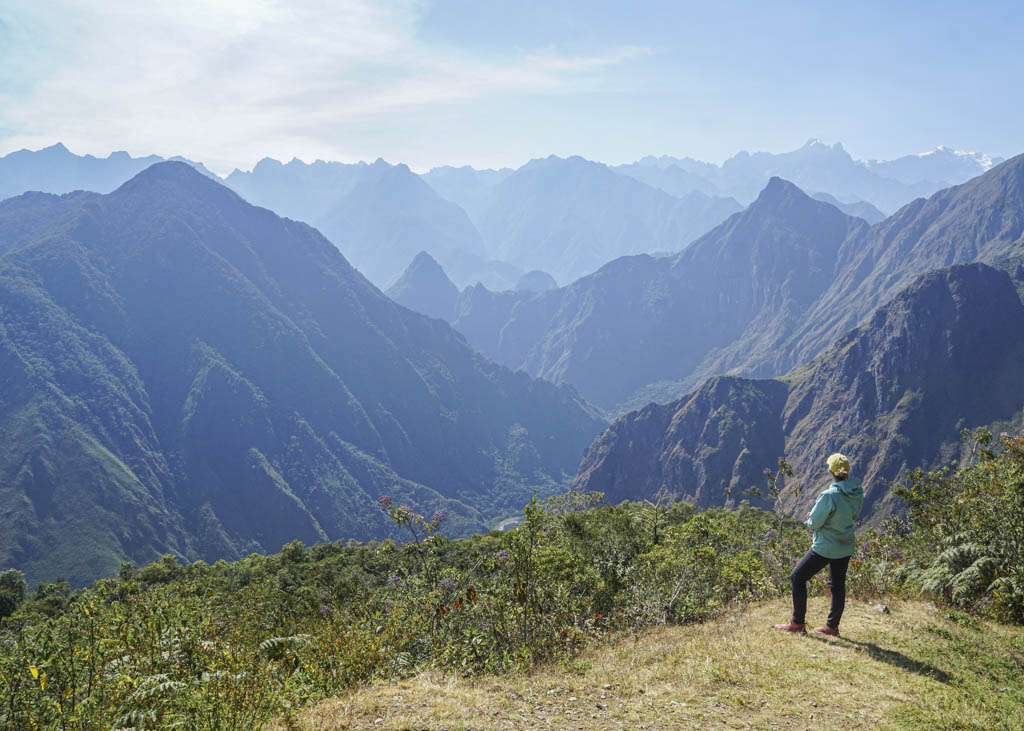
Salkantay Trek highlights
If I haven’t convinced you to do the Salkantay Trek, this next part will!
Here are some of the highlights – most of which you won’t experience on the Inca Trail.
Humantay Lake
The first day of the Salkantay Trek starts with a bang!
After driving a few hours from Cusco, you’ll be dropped off at the trailhead in Soraypampa. Shortly after, the uphill hike to Humantay Lake begins.
Humantay Lake is a stunning turquoise glacier lake that sits at 4,200 m.
It’s a popular day trip from Cusco, so this part of the trek will be busy. But after returning from the lake, you’ll have the trail to yourself.
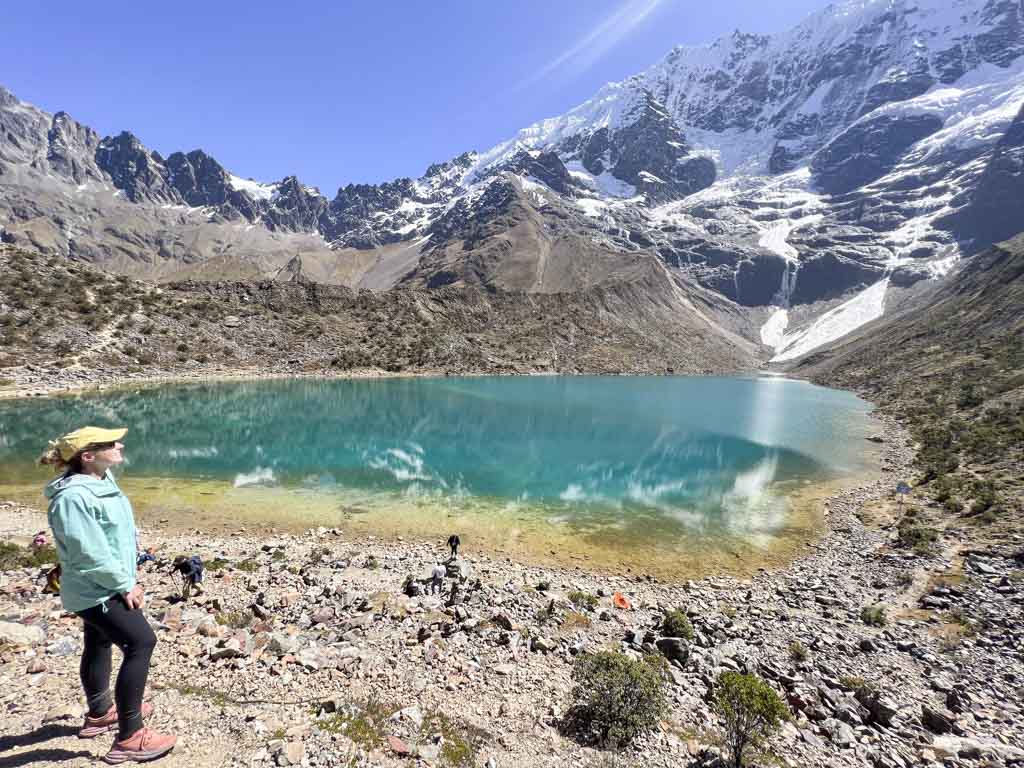
Salkantay Pass
With an elevation of 4,630 m, the Salkantay Pass is the highest point of the Salkantay Trek.
Getting to the pass takes a lot of mental and physical energy. But standing at the top and looking on to Salkantay Mountain is a feeling you’ll never forget.
From here, the trek only gets easier (well, until day 4) .
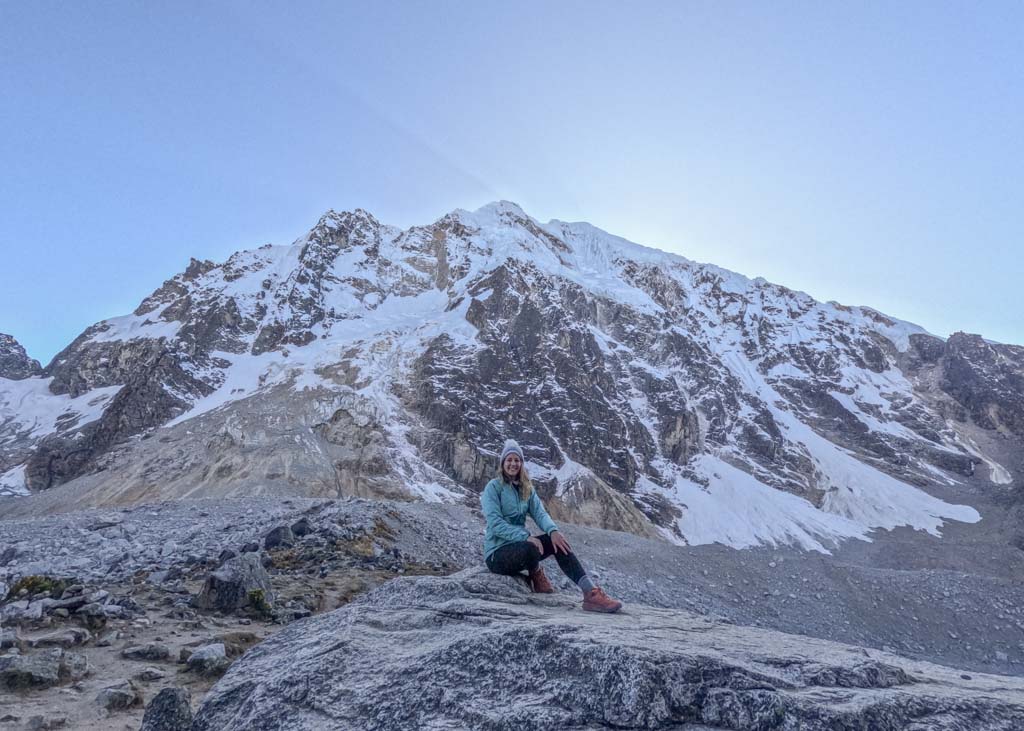
Cocalmayo Hot Springs
On the third day, you’ll reach your campsite at lunchtime. This gives you a free afternoon to explore the nearby attractions.
You can either visit the Cocalmayo Hot Springs or do a coffee tour. There’s even zip-lining!
I visited the Cocalmayo Hot Springs, and it’s just what my body needed.
There are four natural pools here with water of varying temperatures. We spent an hour relaxing in them, and it was a great break from the long trekking days.
Outside the hot springs, you’ll find kiosks selling refreshments and snacks.
Most people doing the Salkantay Trek congregate here, and it’s a great place to enjoy a few beers and meet other hikers.
I nearly didn’t visit these hot springs because of what other people said.
Yes, the water isn’t boiling hot.
Yes, it can get crowded on weekends.
But after three days of hiking the Salkantay Trek, your body will not care!
You’ll love the warm waters and will want to sit back and relax.
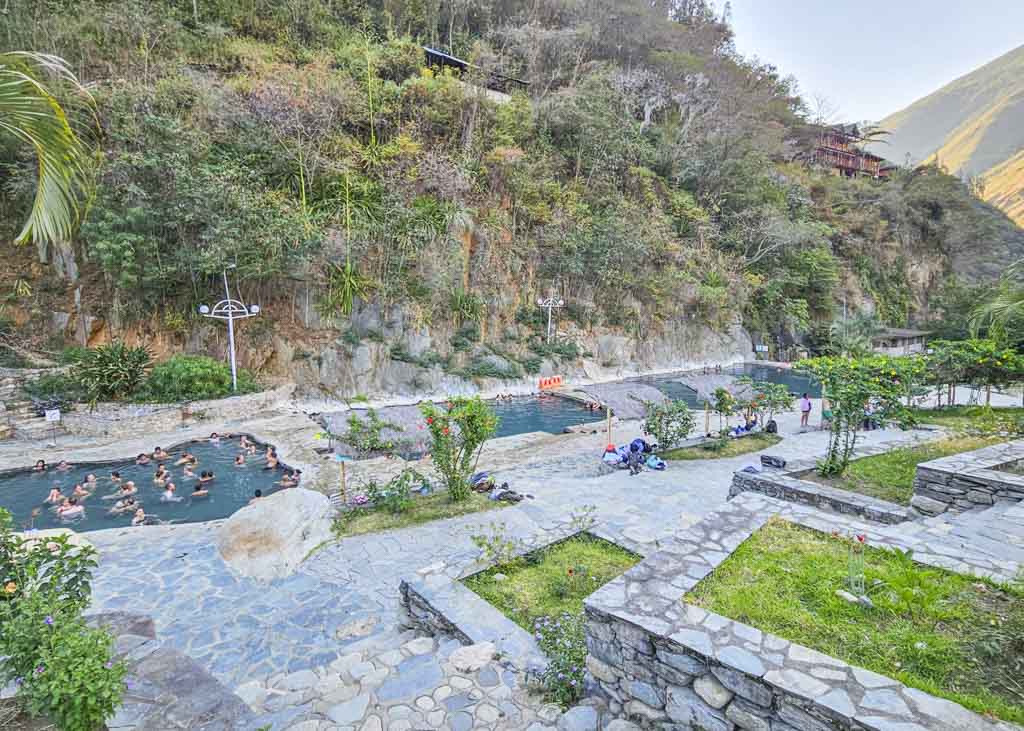
Llactapata archeological site
Llactapata is an important archaeological site near Machu Picchu. It’s less explored than other Inca sites and offers unspoiled views of Huayna Picchu Mountain.
To get to Llactapata, you follow the same trail the Incas did. This is the only part of the Salkantay Trek that includes the Inca route.
It’s a strenuous uphill hike from Lucmabamba to Llactapata. After exploring the site, you’ll descend the other side of the mountain, which is equally as challenging.
If you do the 4 day Salkantay Trek, you will skip this section of the trail.
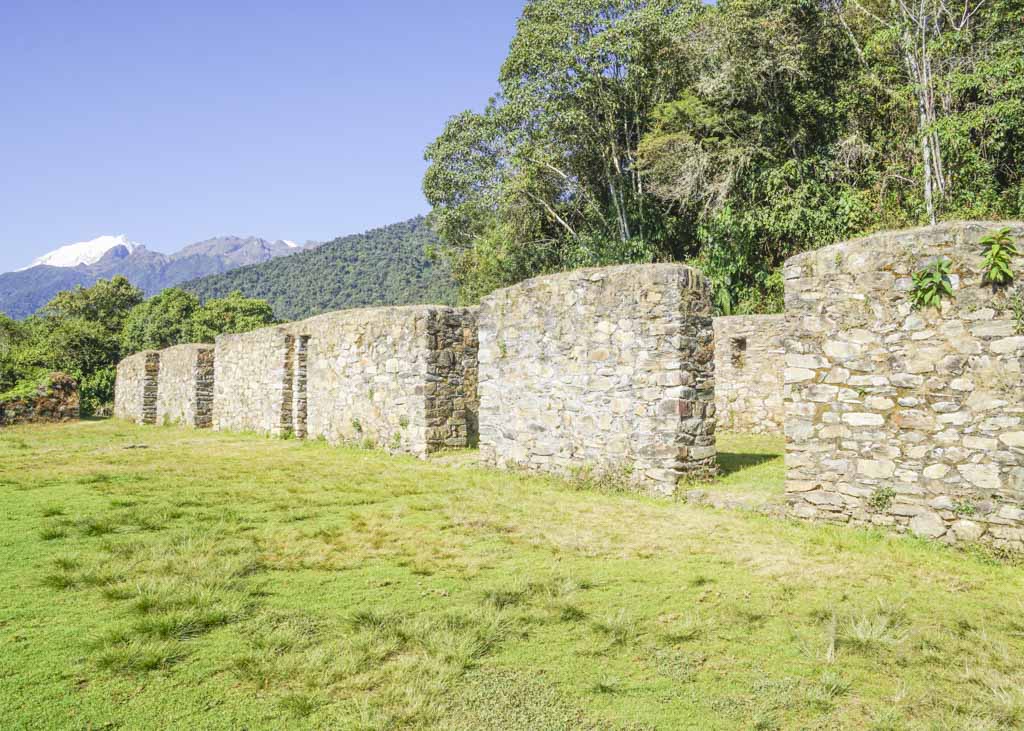
Machu Picchu: The Highlight of The Salkantay Trail
And finally, the most iconic site on the 5 day Salkantay Trek: Machu Picchu.
This wonder of the world completely blew me away. I had heard so much about Machu Picchu and thought it might be overrated.
But I can confirm that it is not!
Machu Picchu is a fascinating place, and our exceptional guide, Percy, played a big part in my experience of visiting it.
Over the past 5 days on the Salkantay Trek, Percy had taken us on this incredible journey through time and nature that culminated with the history of Machu Picchu.
He shared stories of Pachamama (mother nature), the Incas, their mystery, and Peruvian culture.
His passion for his country and its people was one of the most beautiful things, and I learned so much from him.
You can visit Machu Picchu without a guide, but you’ll be missing out on so much.
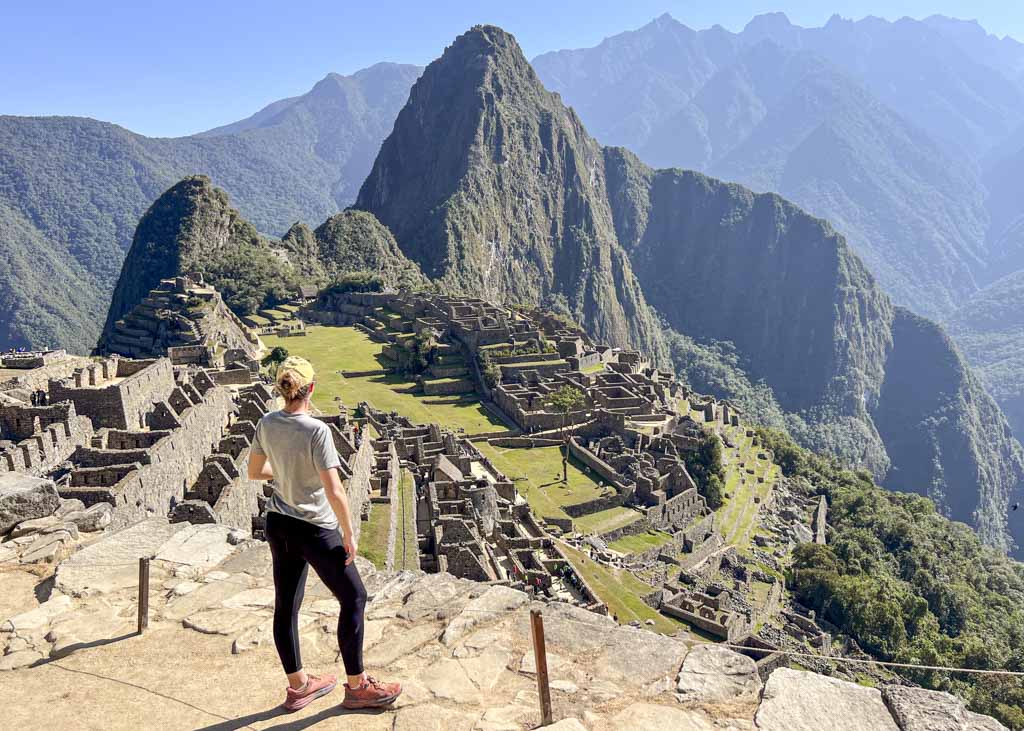
Salkantay Trek itinerary
Below is an outline of the itinerary we followed.
- Day 1: Cusco – Soraypampa – Humantay Lake – Soyroccocha
- Day 2: Soyroccocha – Salkantay Pass – Wayraqmachay – Chaullay
- Day 3: Chaullay – Lucmabamba – Cocalmayo Hot Springs – Lucmabamba
- Day 4: Lucmabamba – Llactapata – Hidroelectrica – Aguas Calientes
- Day 5: Aguas Calientes – Machu Picchu – Aguas Calientes – Ollantaytambo – Cusco
Salkantay trekking tours
I booked my Salkantay Trek tour through Inkayni Peru Tours after reading all these positive reviews , and they were fantastic.
Inkayni is a local tour operator specializing in smaller group tours and personalized services. And that’s exactly what I got.
I did the Salkantay Trek with my mom, who is in her 60s. It was a tough hike for both of us, but we made it to the end – and I have no doubt that you will too.
Our guide was patient and kind and offered all the support and encouragement we needed.
Inkayni took care of absolutely everything for us, from the Machu Picchu entrance ticket to the scenic train ride.
This was a special mother/daughter trip that was made extra special thanks to the team at Inkayni Peru Tours.
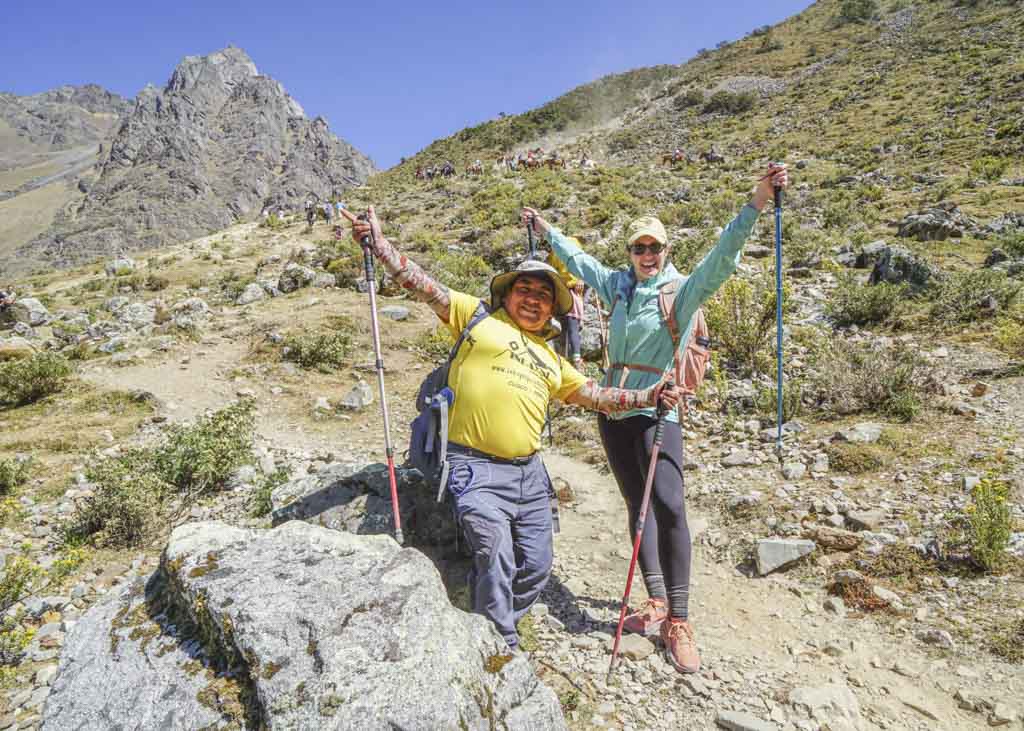
Other Salkantay Trek tours
Unlike the Inca Trail, the Salkantay Trek doesn’t need to be booked months in advance.
You can arrive in Cusco and book a tour for the next day. That’s how easy it is.
But I do not recommend this.
Every tour offers a different experience and itinerary. So don’t book with the first operator you come across.
If you’re worried about your fitness levels and the high altitude. Or if you’re questioning whether you will be able to finish the hike, I recommend opting for a smaller group tour like the one I did with Inkayni. You’ll enjoy the experience a lot more as you won’t feel rushed or pressured to walk faster.
Some Salkantay tours cater specifically to backpackers. This means you’ll be one of eighteen people in your group, the food won’t be anything to write home about, and you will have less one-on-one time with your guide.
If you’re doing the Salkantay Trek on a budget, this might be your best option.
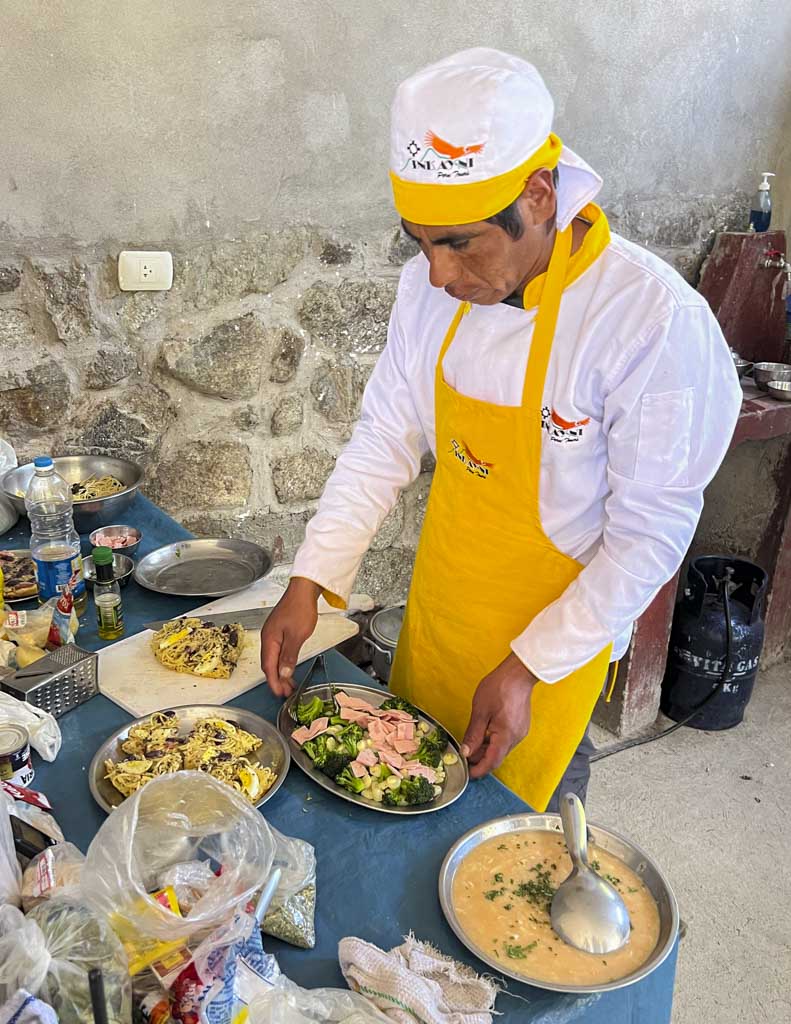
Do your research
But I cannot stress the importance of researching before booking your tour.
I met a few travelers along the route who complained nonstop about the quality of their food and camping gear provided by their tour company. They also moaned that their guide’s English was not perfect.
I soon realized that they had paid next to nothing for their tour. I’m surprised they were even given food!
I don’t know how their guides and porters are expected to live off that measly amount, and I felt sorry for their trekking team.
If you’re paying for the cheapest tour, you cannot expect a five-star experience. I understand that not everyone has the budget, but you need to be realistic about what you’ll get from a cheaper operator.
Tips for the 5 day Salkantay Trek
- Check whether your tour includes Machu Picchu entrance tickets. If not, book this in advance and choose Circuit 2.
- Spend at least two nights in Cusco to acclimatize to the higher altitude.
- Rent hiking poles, as there are a lot of uphill and downhill sections.
- Tip your trekking team at least 10% of your total tour cost. While tipping is not mandatory, it is expected and means the world to the team.
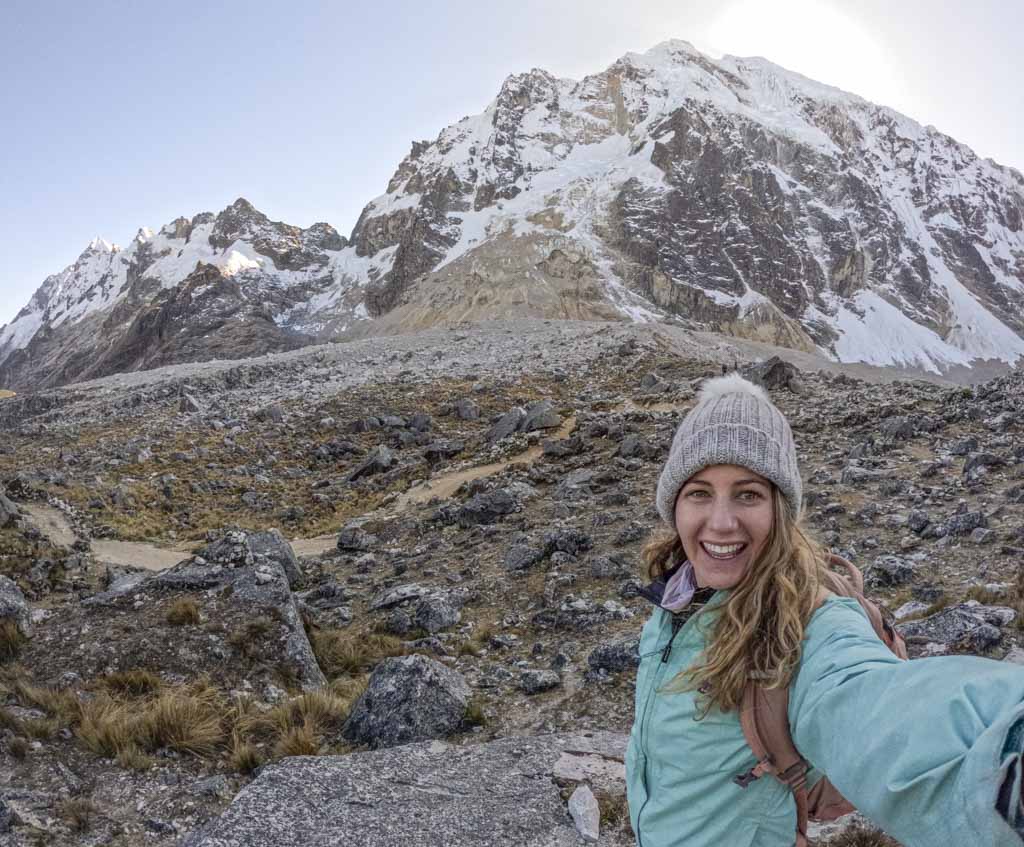
How long does it take to hike the Salkantay Trek?
The classic Salkantay Trek is 5 days and covers a distance of 74 km. Trekking time is 6 to 7 hours per day, except on the last day when you’re exploring Machu Picchu.
Is the Salkantay Trek worth it?
Yes! The Salkantay Trek is a magnificent trek through the Peruvian Andes to Machu Picchu.
Is the Salkantay Trek harder than the Inca Trail?
The Salkantay Trek is harder than the Inca Trail as it is a much further hike and reaches a high altitude on day two.
Is the Salkantay Trek dangerous?
No, the Salkantay Trek isn’t dangerous. But you need to acclimatize properly to ensure you don’t get altitude sickness as you ascend the Salkantay Pass.
What’s the difference between 4 and 5 day Salkantay Trek?
On the 4 day Salkantay Trek, you take a bus to Hidroelectrica instead of walking. This means you skip Llactapata, which is an archaeological site overlooking Huayna Picchu Mountain.
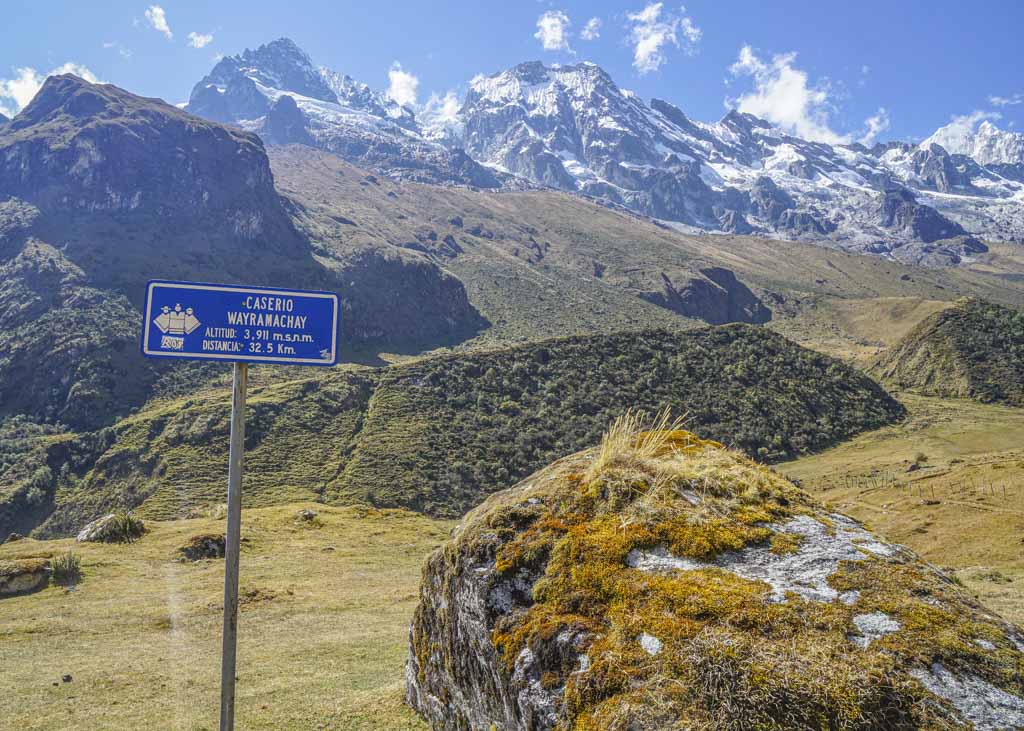
My Salkantay Trek review
I loved the 5 day Salkantay Trek to Machu Picchu.
It has everything you want from a multiday trek. Beautiful scenery where you’re immersed in nature. Challenging sections that will push you to your limits. Incredible archaeological sites that take you back in time. What more do you want?
The Salkantay Trek was one of the best things I did in Peru, and I highly recommend adding it to your itinerary.
Like it? Pin it!
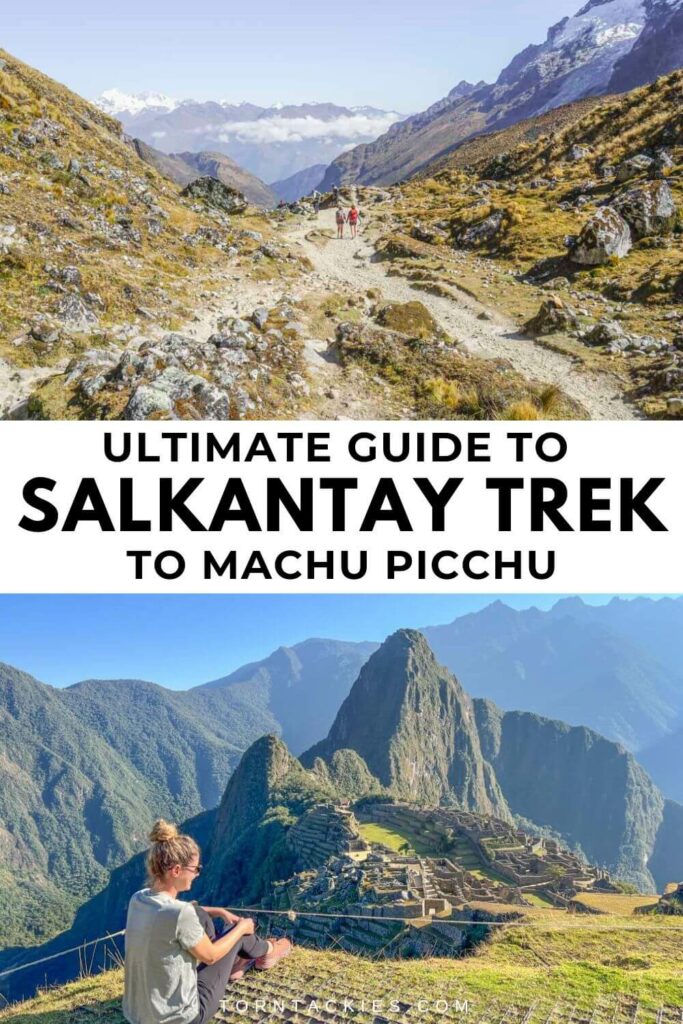
Do you have any questions about the 5 day Salkantay Trek to Machu Picchu? Drop me a message in the comments section below!
Looking for more Peru travel inspiration? Check out my other posts!
- The Best Place to Visit the Amazon in Peru
- Laguna 69: Guide to The Best Day Hike in Peru
- How to Get to Laguna Paron in Huaraz
- Ultimate Guide to Laguna Llaca in Huaraz
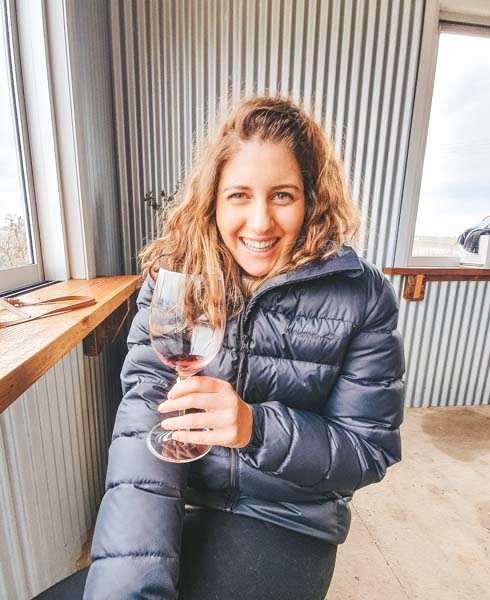
Hi, I'm Carryn. I’m an adventure travel blogger trying to figure out my way through life by traveling and exploring. Join me as I share my travel guides and tips for life abroad. Find out more about me here .
Salkantay Trek Packing List: 60+ Things you need to pack
Ultimate guide to maipu, mendoza: wineries, restaurants & more, leave a comment cancel reply.
Salkantay Trek
To machu picchu, salkantay trek to machu picchu.
Travel back in time to the 15th century on this epic 5-7 day Salkantay Trek across majestic landscapes and into perhaps the world’s most spectacular man-made construction project, Machu Picchu. Created by the Inca tribe over 500 years ago, this incredible UNESCO world heritage site is a testament to the power and ingenuity of one of the world’s great civilizations. At its peak, this spanned an area from modern day Ecuador into Chile, which is equal to nearly the horizontal width of the United States.
Shrouded in mystery, Machu Picchu is thought to have been a ceremonial site, military stronghold, or a retreat for Incan nobility. Abandoned just 100 years after it’s completion and with no written records to confirm, the true purpose may never be known. On this adventure, you’ll discover for yourself the mystique and majesty of this special and sacred place in the most authentic way possible, on foot and under your own strength as the original inhabitants once did.

About The Salkantay Trek
• Duration: Typically 5 days | Luxury experience – 7 days • Distance: 74km, which is 30km longer than the Inca trail • Elevation: 4,600m • Wildlife: chinchillas, bears, deer • Difficulty: Moderate – Challenging
Best Time To Go
The busiest time to hike is in July and August, however unlike the Inca Trail, Salkantay Trek can be made year-round which means smaller groups and no crowds. It only depends on your tolerance for rain and mud.
Optimal Conditions:
Late April & Early October will allow you to enjoy great weather with the fewest hikers possible.

What To Pack
Embarking on the Salkantay Trek will take you through a variety of climates. Hike through lush valleys, dense rainforests and snow capped peaks. For this adventure, you’ll want to pack as light as possible with a priority on layers and waterproof apparel.

How Much Does It Cost
Depending on the experience that you are seeking, the trek with a guide can be done for as little as $250 USD. This typically includes: transportation to trail head, Machu Picchu entry ticket, return train to Cusco, meals and camping equipment.
For a premium luxury experience over 7 days, the costs start at $1480 – $3995 USD.
Helpful Tip
The Salkantay Trek is one of the most rewarding hikes in all of Peru, however it can be quite challenging. In order to prepare, it is highly recommended that you spend atleast 2 days in Cuzco in order to acclimatize to the elevation before setting off on the trek.

related articles you may also enjoy

Explore The Galapagos Islands | Ecuador

Safari in the Okavango Delta | Botswana

Island Hopping in Coron | Philippines

Dive Sibultan, El Nido | Philippines
Privacy overview.
The Hiking Life
Trail Guides, Gear Reviews, and Backpacking Tips
Salkantay Trek: Independent Hiker’s Guide
Posted on October 4, 2017 December 19, 2020 Author Cam 177 Comments
When most people think of hiking to Machu Picchu, the first name that comes to mind is the Inca Trail. And justifiably so. For decades that classic trek was the sole focal point for anyone looking to arrive at the fabled ‘lost city’ on foot. However, as Machu Picchu’s fame increased, so did the quantity of people wanting to experience the Inca Trail. In the early 2000’s authorities installed a much needed quota on hiking numbers, a decision which led to the emergence of the Salkantay Trek on the world’s backpacking radar.
I hiked the Salkantay Trek in August, 2017. The information contained below is mostly geared towards hikers who choose to do the walk independently rather than with a guided group ( Note : Since 2001 it is prohibited to hike the Inca Trail without a guide).
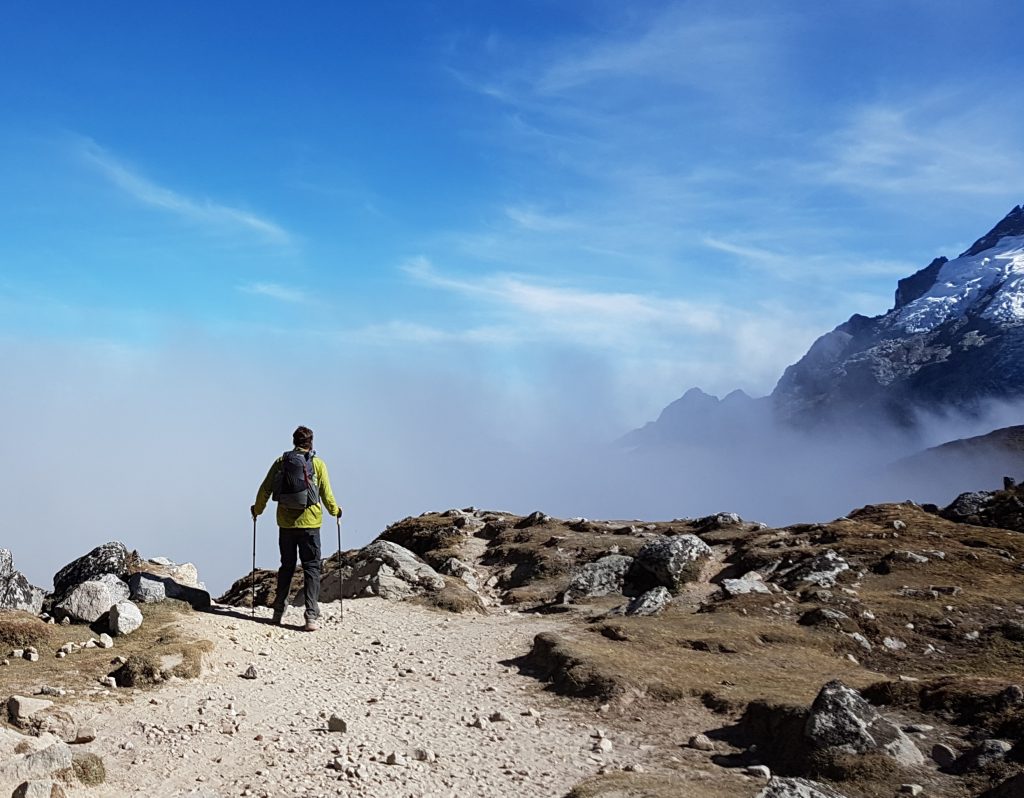
Ryan “Dirtmonger” Sylva descending from Salkantay Pass (4630m/15,190ft).
Distance : 57.2 miles ( 92 km)
Avg. Time : 5 days.
- That is the standard amount of time taken by guided groups . If you are fit, acclimatised and carrying a light pack, there are no real issues in doing the hike in three or four days if you feel like it.
Start : Mollepata
- As of 2017, virtually all organized groups start at Soraypampa, which cuts off some 12 miles/20 km from the overall distance mentioned above. We decided to begin our hike at the traditional trailhead of Mollepata, and hike from there to Soraypampa. From Mollepata you can either follow the dirt road or take a well marked trail (the signed junction is just a few minutes out of town) all the way to Soraypampa.
Finish : The summit of Machu Picchu mountain.
- The traditional end of the Salkantay Trek is the Machu Picchu archeological site. We decided to extend it a little by making the summit of Machu Picchu Peak (3061m / 10,042ft) our finishing point.
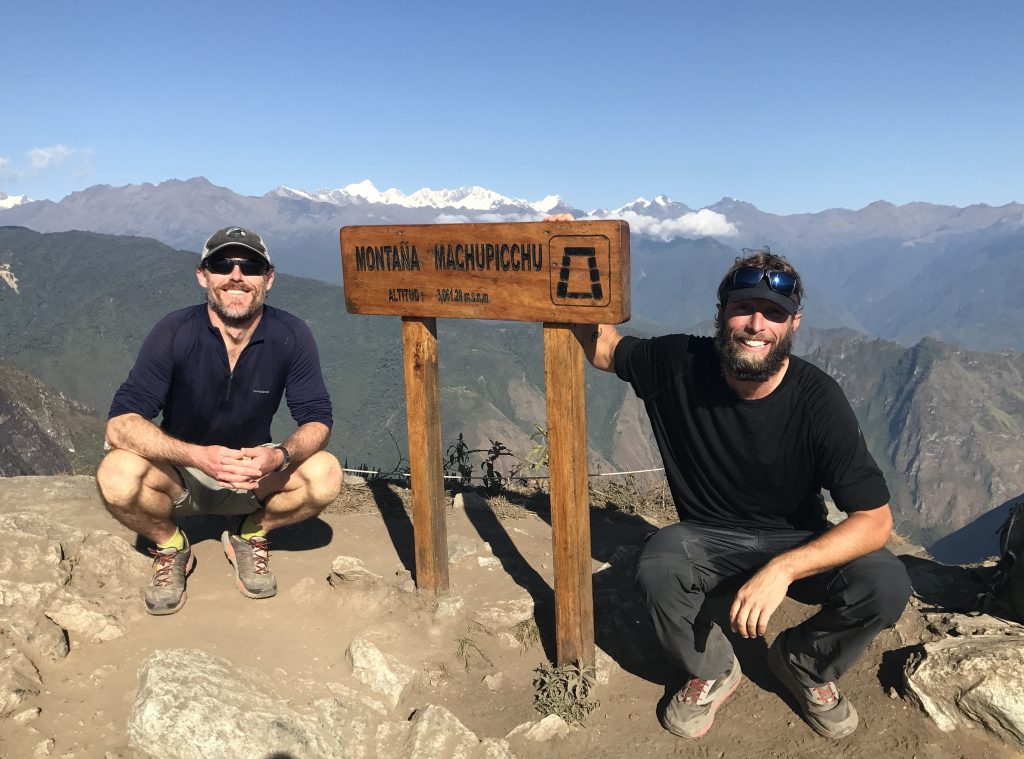
Yours truly and Ryan “Dirtmonger” Sylva on top of Machu Picchu Peak – finishing point of our Salkantay Trek.
Highest Point : Salkantay Pass 4630 m (15,190 ft)
Lowest Point : Hydroelectric Plant 1800 m (5906 ft)
Difficulty : Easy to moderate.
Transport :
- Mollepata – Three hours by regular buses from Cusco. Cost 15 Peruvian Soles (about US$5). As of 2017, you can catch daily minibuses from near the junction of Arcopata and Avenida Apurimac. They usually leave around 7 to 8 am.
- Machu Picchu – Returning to Cusco from the finish of the hike is either expensive or time consuming. The priciest, easiest and most comfortable way is to take the train from Aguas Calientes to Cusco (4 hrs). Alternatively you can catch the train to Ollantaytambo, then take a Collectivo minibus or taxi from there to Cusco (between 3 hrs and 4 hrs total). Finally, the cheapest and most time consuming way to return to Cusco from Machu Picchu is as follows: 1. Walk the 11 km back to the Hydroelectric dam along the railroad tracks; 2. From there take a minibus or collective taxi to the village of Santa Teresa; 3. Catch another bus back to Cusco. This three step journey can take the best part of an entire day depending on connections, and you may well find yourself overnighting in Santa Teresa; not such a bad thing as it does sport some soothing hot springs ( Note : If you plan on taking the train, you should book well in advance ).
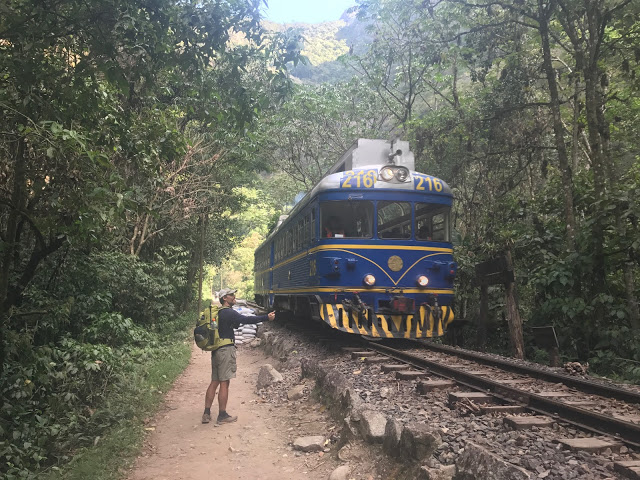
The world’s most futile hitching attempt on the way to Aguas Calientes (photo from Ryan Sylva).
Season : Possible all year, though the dry season between May and October is ideal. During this period nights can be chilly (0°C is common), but days are generally clear.
Guidebook / Maps / Online Information :
- Guidebook : Alexander Stewart’s The Inca Trail (2013) contains trekking notes and basic maps for the Salkantay Trek (as well as other hikes in the area).
- GPS : For GPS details see Salkantay Trek on the GaiaGPS website.
- Blogs by Independent Salkantay Hikers : Sayonarapushek.com, Kevinstravelblog.com, rediscoveringpassions.wordpress.com and last but not least, my hiking partner Ryan “Dirtmonger” Sylva’s personal account of our Salkantay Trek experience.
Permits & Fees : No permits are needed to hike the Salkantay Trek. However, you will need to purchase an entrance ticket to the Machu Picchu archeological site and Huayna Picchu or Machu Picchu peaks. Independent hikers can organise these in advance through the official Peruvian Ministry of Culture website . Alternatively, if you are going with an organised group, the tour company may do it for you. It’s worth noting that as of 2017, you can also pick up entry tickets to Machu Picchu (but not the peaks) once you arrive in Aguas Calientes.
For a thorough overview of the ins and outs of purchasing Machu Picchu tickets, see Thrifty Nomads .
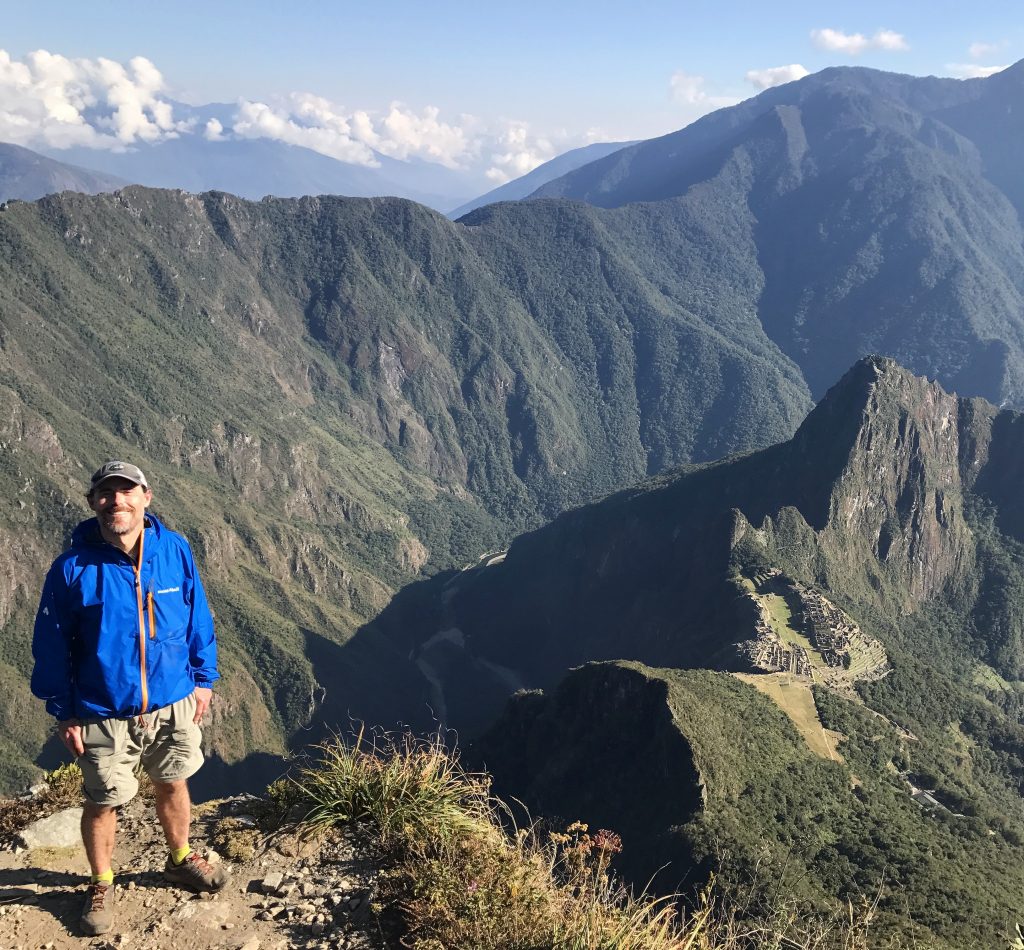
The view from Machu Picchu Peak overlooking the citadel and Huayna Picchu (Photo courtesy of Ryan Sylva)
Food : You have a few options: 1. B ring all your supplies from Cusco; 2. Purchase provisions and organise meals along the way at Soraypampa, Colpapampa and La Playa, or; 3. Do a combination of both. We went with the final option, and enjoyed a few wonderful home cooked meals during our journey. For those interested in taking the same approach, I’d recommend starting the trek with no more than two days food.
Water : Plenty of water available throughout the trek (we never carried more than 1.5 lt at a time), however, due the prevalence of livestock and human settlement it is recommended that all water should be treated.
Guided Vs Independent : More than 95% of hikers tackle the Salkantay Trek as part of a guided group. However, if you have the necessary gear (it’s also possible to rent equipment in Cusco) and a reasonable amount of backpacking experience, there are no issues with doing the hike independently. The trail is easy to follow throughout its course and as mentioned above, you can purchase food along the way (i.e. which translates to a lighter load).
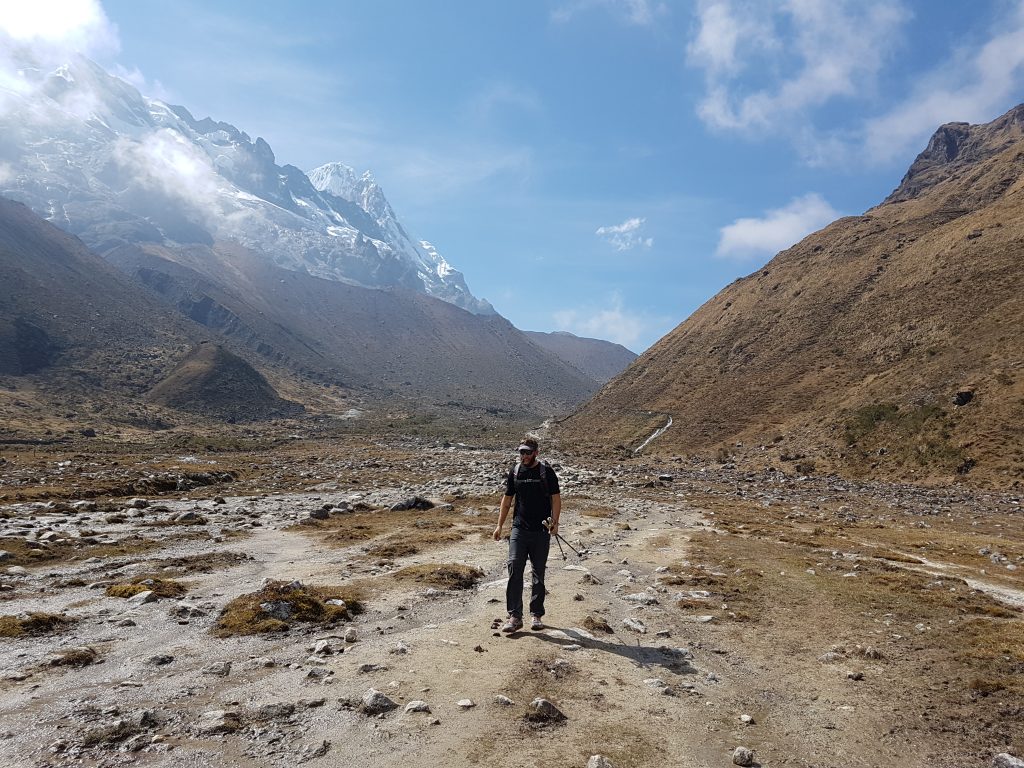
DM descending the Quebrada Humantay.
How does the Salkantay differ from the Inca Trail? The primary differences are as follows: it’s longer, slightly more challenging, less crowded, boasts a greater variation of ecozones, but doesn’t have the multiple archeological sites that you can visit on the Inca Trail. It’s also cheaper, irrespective of whether you go with an organized group or independently; significantly so if you choose the later option. In short, they are different treks that both happen to end at the same spectacular destination.
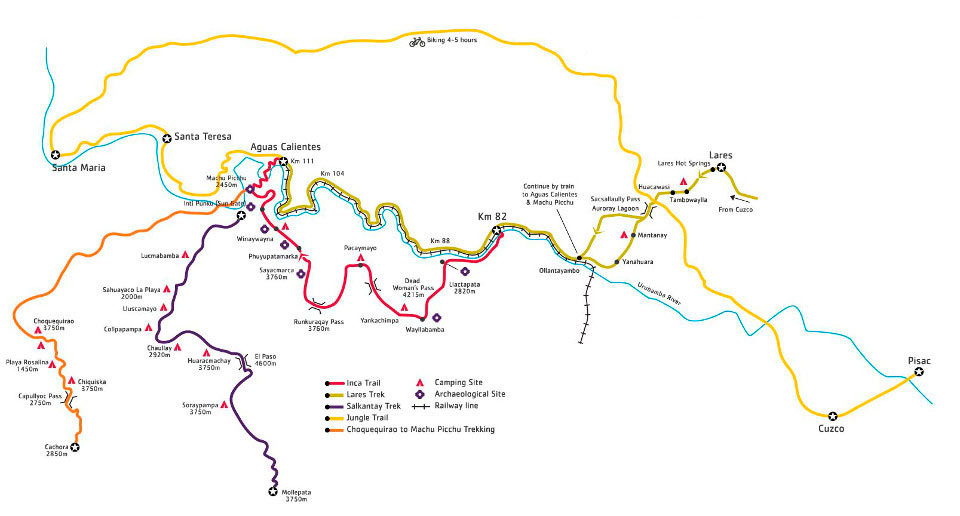
Overview map of different trails to Machu Picchu ( Terraquechuaperu.com )
Trekking Notes :
- Overall Character : The Salkantay is perhaps most notable for its ecological diversity. It traverses picturesque valleys, alpine meadows, goes up and over a dramatic mountain pass and meanders its way through a lush subtropical rainforest.
- The Pass : The high point both geographically as well as scenically is the 4630 m (15,190ft) Abra Salkantay . Upon reaching this spectacular pass, hikers are afforded jaw-dropping vistas of Mount Salkantay (6271 m), a peak that has long been considered sacred by the inhabitants of the Peruvian Andes.
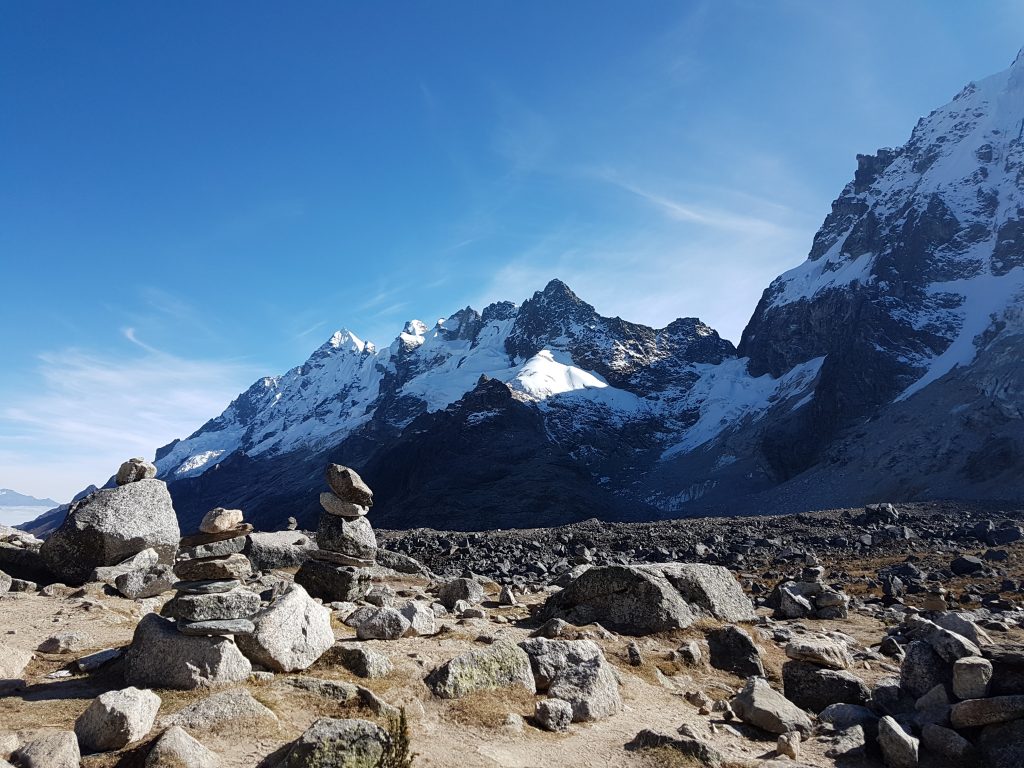
Views from Salkantay Pass.
- Transformation : From the pass, the trail descends more than 2000 meters (6562 ft) into cloud forest. The change in flora, as well as temperature is dramatic. Along the way there are various accommodation/camping options where it is possible to break up the descent (i.e. Huayracmachay, Collpapampa and Challway).
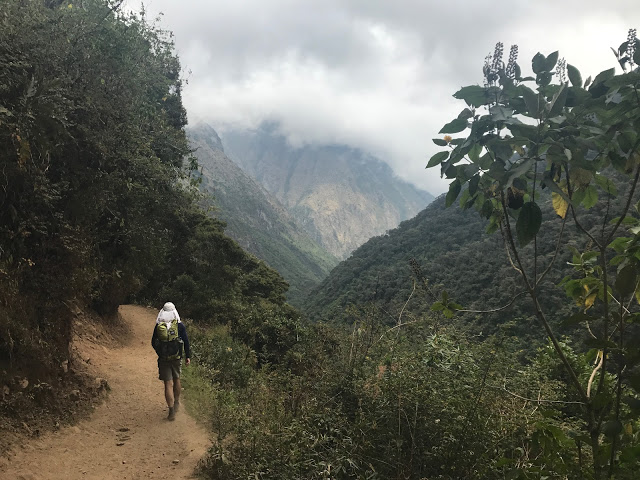
- Ascend to Llactapata : Not long after leaving the friendly village of La Playa, the pathway ascends again via banana and coffee plantations (be sure to stop for a cup or two) to the recently rediscovered ruins of Llactapata. There is a campsite close to the archeological site with impressive views towards Machu Picchu.
- Along the Tracks : From Llactapata the trail goes steeply downhill to the hydroelectric plant. Soon after you pass the railway station where provisions can be purchased. From this point it is a flat and easy 11 km to the town of Aguas Calientes following the railway tracks.
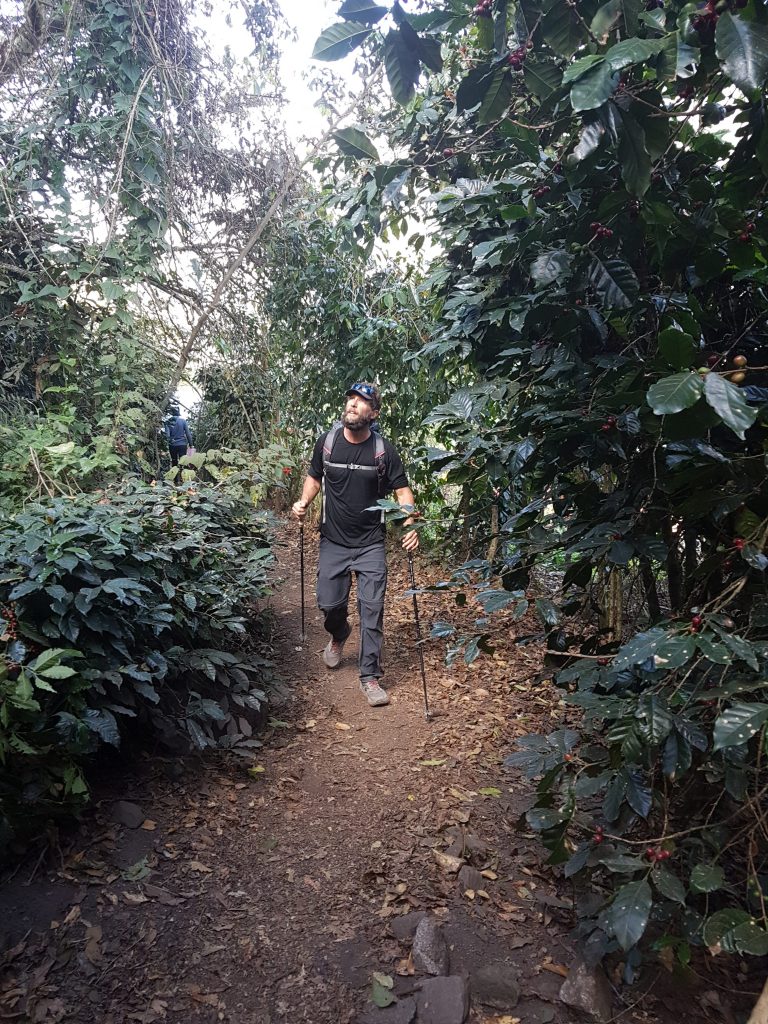
DM walking through a coffee plantation on the way to Llactapata.
- Day 1 : Mollepata to Soraypampa : 20 Km (12.4 miles);
- Day 2 : Soraypampa to Collpapampa : 22 Km (13.7 miles);
- Day 3 : Collpapampa to La Playa : 16 Km (9.9 miles) (** Update – March 13, 2018: According to report, trail between Collpapampa and La Playa is closed due to landslides. No information as to when it will be cleared; in the meantime take road instead. See comments below – Calvin Benson – for details).
- Day 4 : La Playa to Aguas Calientes : 25 Km (15.5 miles) – via Llactapata;
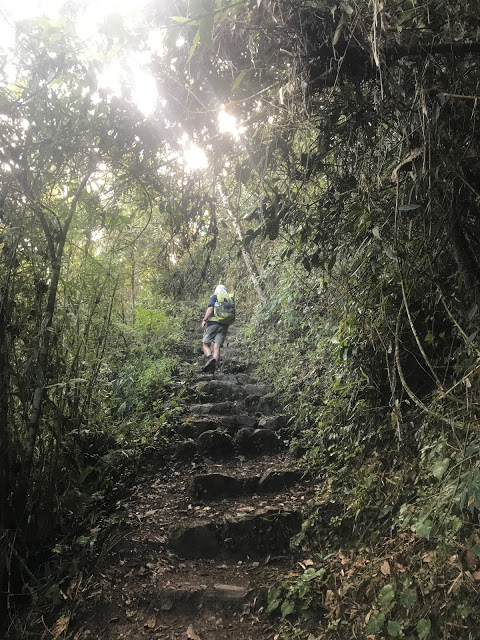
Ascending the steps to Machu Picchu Peak (photo courtesy of Ryan Sylva).
Final Thoughts :
- Go Independent : By any criteria, the Salkantay is not a difficult trek. If you have the gear, are reasonably fit, well acclimatized and know how to follow a trail, I’d highly recommend going independently. It’s a lot cheaper, a bigger sense of accomplishment, more opportunities to interact with locals, and you gift yourself the element of freedom; the freedom to choose where you camp, what you eat, whom you hike with (if anyone), when you take a break, how fast or slow you walk, etc.
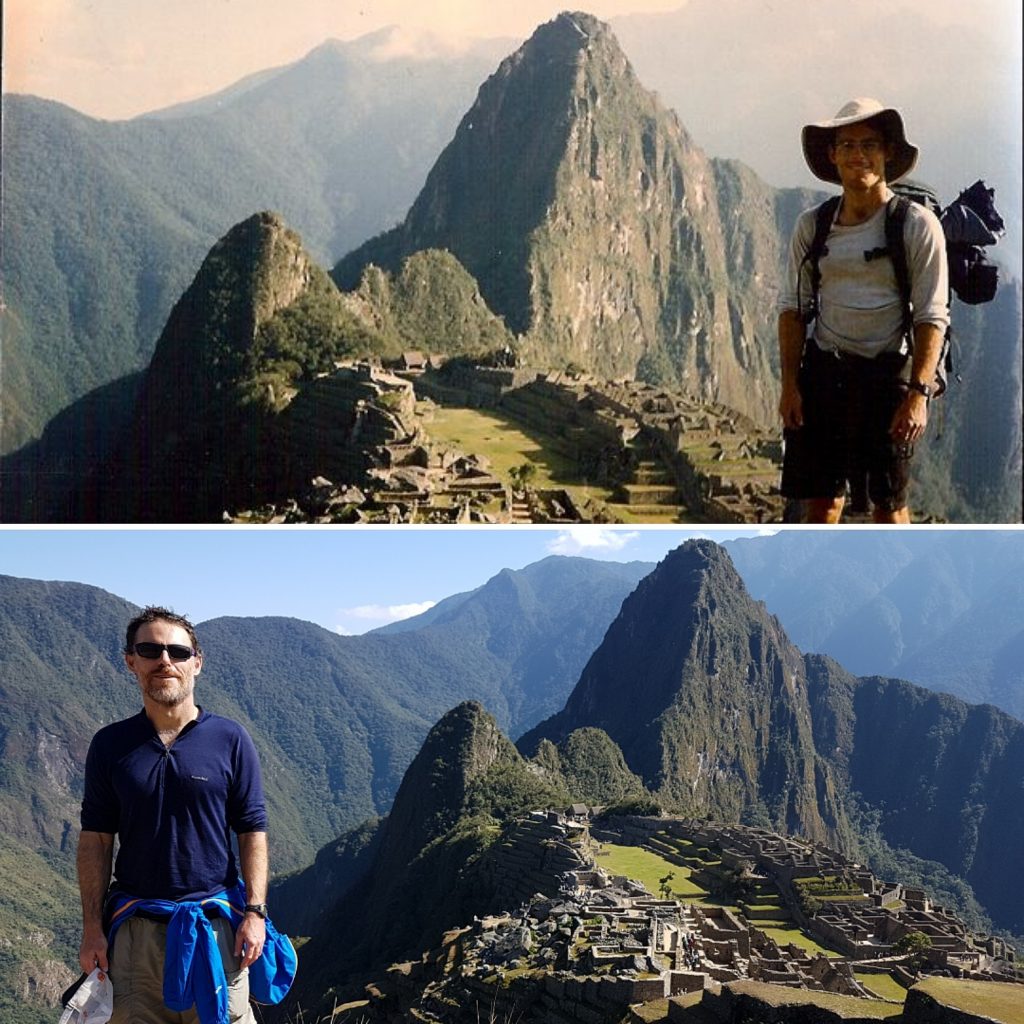
Yours truly at the end of the Inca Trail in 1996, and 21 years later at the end of the Salkantay Trek.

Discover more from The Hiking Life
Subscribe to get the latest posts sent to your email.
Type your email…
177 Replies to “Salkantay Trek: Independent Hiker’s Guide”
My husband and I hiked the Salkantay Trek in February of this year. In many years of backpacking, we had never opted to go on a guided hike, but the complexity of transportation logistics and the lack of readily available topo maps led us to book a guided trek last-minute. On our hike we saw a few intrepid, independent hikers — my hats off to you and to them!
Though I was skeptical about going with a guide, I ultimately enjoyed it tremendously. We had local guides who opened the door for us to interact with other locals beyond what I believe I would have been able to do, even as a Spanish speaker; the food provided was unbelievably good; we got to sleep in a glass igloo the first night; and traveling for five days with others in our group had the benefit of letting us become more connected with fellow hikers than the more casual connections I’m used to making on the trail.
That said, there are plenty of trekking companies ready to take travelers’ money — and not all are reputable. We did our research and were ultimately happy with Salkantay Trekking Company ( http://www.salkantaytrekking.com ). We were able to reduce the trek price because we had already bought train tickets and permits for Machu Picchu, which brought the cost for 5 days including all food, transportation and lodging about $180.
Travelogue, including GPS track, at http://dearantler.com/askantler/hooves-on-the-ground-peru .
Thanks for the detailed message. It’s always good to have folks that have enjoyed different experiences chime in. I remember seeing those glass igloos you mentioned!
hi guys, i just read your blog after this comment…. how did you manage to get this amazing prize??? i wrote to Salkantay Trekking, and they didn’t allow me to do the same, and offered me a pack of $420, very far from your prize…. can you help me with this? thanks in advance!
Hello Cam! Thank you for this insightful post. I do hope I’ll get a chance to hike in Peruwian mountains once I’m done with Europe 😉
Great post,
Did the Inca trail twenty years ago with a guided group. Although I’ve enjoyed the guided tour it was the beginning of many years of independent hikes all over the world. Great to see this alternative track, maybe I will go back one day.
Greets from Belgium, Bart
Must have been a great feeling getting back to Machu Picchu after all those years, particularly getting there under your own steam.
Thanks for sharing an independent approach to Machu Picchu and opening the door for me. I have put this on the list and look forward to some hiking in Peru.
Thanks for all the helpful information, thinking of making this trek without a guide next September. What about campsites along the trail? Do these need to be booked in advance? Thanks again.
Plenty of camping options along the way. No need to book in advance if you are hiking independently. All the best on your trip!
Hey Cam, thanks for the info. I read that the ticketing guidelines at Machu Picchu may have changed last July and you now have to enter with a guide, among other limitations. Was that your experience in August? Any issues there? Thanks again.
It wasn’t obligatory to have a guide at Machu Picchu last August. That said, you do need to organise your permits for the peaks and site beforehand. Be sure to bring a paper copy of your reservation/s to the site if you are going independently.
I’m just wondering how this trek stacks up against the Inca trail in your opinion? Did you find one more enjoyable then the other? Did one have better views then the other? Was one more challenging? Thanks in advance!
Regards, Vaughn
Hey Vaughan,
They are different treks that both end up at the same spectacular destination. I can’t say that one is better than the other. I did the Inca Trail back in 1996. At that time it could still be done independently; these days it is obligatory to go with a guide/group and is quite expensive. The Salkantay can still be done without an agency if you so choose.
In regards to other differences, Inca Trail has some great archeological sites along the way, whereas the standout feature of the Salkantay (at least from my perspective) is the ecological diversity encountered during its course. Perhaps the Salkantay is slightly more challenging from a physical standpoint. The views are amazing on both hikes.
Thank you for such a quick reply! Your article has convinced me to hike the Salkantay trail sometime in the near future. I hope to follow a similar itnerary to you starting at Molletapa and finishing at one of the peaks. I’m unsure whether I would rather finish at the Machu Picchu peak or hike up to the busier Huayna Picchu peak. What made you guys choose the Machu Picchu peak over the Huayna Picchu?
No worries. I had been up Huayna Picchu in 1996, so I thought it would be good to check out the view from the other peak this last time around.
Thank you for the great advice. I’m doing this trek independently with my son (26) in August. Can you tell me whether there are lodges/teahouses on the route as we do not want to carry food or camping equipment. Thank you.
There are some lodges along the way, which depending on availability, you might be able to book in advance. I suspect they are mostly filled up with trekking agency groups.
In regards to food, as I mentioned in the article, you can purchase meals and/or pick up supplies at Soraypampa, Colpapampa and La Playa.
Hi! Thank you for the great information. I will be doing the trek in March. You noted permits are not required, but I read in Alexander Stewart’s book that a permit needs to be purchased for the section from Soray Pampa to Lucmabamba. Did you have to by a permit for this checkpoint or bypass it? Thanks!!
To the best of my knowledge you do not need a permit to hike any part of the Salkantay Trek, with the exception of the finish at Machu Picchu. Best of luck on your hike!
Hi Emily. Are you camping or planning to stay in lodges en route? I’ve been trying to work out accom other than carrying my own and would be grateful for post trip advice/tips.
Hi Andrew, I will be camping the whole time with three other people. I’ve read there can be lodging options along the route. I found a company that you can book through Airbnb that organizes accommodations for you along the trek. It seemed to have good lodging options and to be reliable, but more money than we wanted to spend.
Hey Emily, I am planning to do this trek within the next week and would also like to walk the same route as you mentioned, did you ever find out if extra permits are needed? Any help would be greatly appreciated thanks in advance!
This report and comment section is great, since I am also planning my trip (together with two others) in April! We actually plan on doing the hike ourselves and we were just not sure about water and food supply. But seems that there is plenty of chances to by things along the way, right?
I heard from someone who is currently there, that it is not allowed to go without a guide anymore??She apparently talked to different companies and they told her so. Has anyone information on this? I can’t seem to find anything about this in the web.
Best wishes, Barbara
Hi Barbara,
I’d take that information about not being able to do the Salkantay independently with a large grain of salt. As of the end of last year, it was definitely possible.
I know you’ve said that Salkantay Trek requires no permits. The book you suggest though, “The Inca Trail Cusco & Machu Picchu”, states that you need a INC permit in order to pass through Soraypampa. I was curious on your take on this, and if you guys went through without needing one?
Thanks! And your site is amazing! Derrick
Hey Derrick,
Thanks for the kind words.
We did the Salkantay with basic GPS info we found on Gaia. I haven’t personally seen the guidebook, and I list it because it seems to be the most recent text on hiking in the region. That said, from the information we obtained in Cusco prior to departure, there didn’t seem to be any permit requirements for Soraypampa. Indeed, we overnighted there and no one we spoke to asked us for anything, nor did we see any permit checking booth upon arrival or departure.
Thanks! – I also read that and was wondering if permit is required 🙂 Kathy
Hi there! Thank you for the information. My partner and I will be hiking Salkantay without a guide during the last week of April. For the areas that we overnight in (Soraypampa or Salkantaypampa, Colpapampa, La Playa), do you have to book your campsite in advance? Or can you just show up and pitch a tent? Is there a cost?
Hi Elizabeth,
To the best of my knowledge, independent hikers don’t have to book campsites in advance. Yes, there will be a cost at the places you mention. All the best on your hike!
Hi again! When you say there will be a cost in the places mentioned above, what do you mean? I assumed all dispersed camping on the trail was free. Do you mean if you pay to sleep in a hotel of some kind in those locations?
If you camp at the main sites or in the villages such as La Playa, there will generally be a small fee.
Hey there, me my boyfriend and my mom are planning to do this trek independently in August 2018. The thing that my mom is most worried about is the weather. Did you bring a heavy duty sleeping bag and if not, we’re you cold during the night? She only has a 0 degree Celcius sleeping bag so we’re wondering if she will be fine. Thanks a lot!!
Chances are for a couple of the higher altitude campsites on either side of the pass, your mom may need a slightly warmer bag. Something around -5 to -10°C should do the trick.
All the best on your hike!
My daughter and I plan to do this trek in August as well. I am in excellent shape but have not done a lot of backpacking. My daughter however has and thinks I should have no problem. Once I get there, are there tours we can purchase if I don’t feel I can do the trail over 5 days without a guide?
Hi! Can you provide more info on where you camped/lodged each night? Is camping in augas calientes easy and safe? Did you stay at any unique hotels/hostels on the trail or did you just disperse camp each night?
We are trying to coordinate our camping and lodging for our trek!
Thank you so much!
I generally list an “average time” on these guides, rather than the time I actually took, as I tend to hike a bit quicker than most folks. In regards to our Salkantay itinerary: Day 1 – My friend and I started from Mollepata after lunch, and camped that night at Soraypampa in a designated camping area. We arranged to eat dinner that night with the family who ran the campsite; Day 2 – We hiked from Soraypampa to La Playa where we stayed with some locals; Day 3 – We reached Aguas Calientes at lunch time, and stayed the night at a hotel in town. Hope this helps. Best of luck with your hike.
Thanks, Cam! Did you just find a place the same day you arrived in aguas calientes or did you have it booked ahead of time?
Also, on day 1 and day 2 did you just find those designated spots as you went along or did you already know where you needed to get to those nights?
Trying to gauge how much planning I need to do ahead of time for camping.
No worries. We didn’t book anything in advance and had no problems finding places. There are so few independent hikers, I don’t think it’s much of an issue. On day 2, we actually slept on a big open terrace over a shop. The family who ran the place were very nice, and they offered us a place to sleep, in addition to a dinner/breakfast combo.
Wonderful! How did you find them?
Also, do you know anything about those places that are giant glass domes or the “hotels” that are on the suspended on the cliff sides? Are those along the Salkantay?
You’re awesome. Thank you so much for your help!
It was late in the day when we arrived in the village of La Playa, and we just asked the folks in the shop about accommodation. I saw the glass domes you mention at Soraypampa, but I don’t know much about them. All the best on your trip!
These glass domes are on AirBnb! They look pretty neat, but not the cheapest!
Thanks, Derrick! What do I search for to find them on Airbnb? Any chance you have the link?
Yup, Skylodge Adventure Suites!
https://www.airbnb.com/rooms/2177913?location=Skylodge%20Adventure%20Suites%2C%20Cusco%2C%20Peru
Hi Cam, I’m organizing this trek for september. You say “Day 2 – We hiked from Soraypampa to La Playa” – Really? Is it doable? Soraypampa (3.880 m) to Salkantay Pass (4.630 m) should be around 3h30m-4h00m, uphill for 7 km. Salkantay Pass (4.630 m) to La Playa 82.060 m) should be around 6h-7h, downhill for 30 km.
Those times are general estimates. For hikers that are very fit, acclimatised and experienced, it is obviously possible to cover more ground if you choose to do so. That doesn’t mean I am recommending such a schedule to others; I only mentioned it because Kayley asked specifically where I camped. As I said in the post, the average time to do the trek is five days, and everyone should walk at their own pace.
All the best for your September hike!
I still didn’t thank you for your post and comments!
I normally can hike that long in the Alps, but never tried over 3.300 meters. My only doubt is about the acclimatisation. Before the Salkantay trek, I’m doing 3 days in Arequipa and the Colca Valley (trekking 1.5 days), 2 days in Puno and the Titicaca Lake, 2 days in Cusco. Do you think it’s enough to get acclimatised, according to your experience? I’m 36, in excellent health conditions and quite fit, I normally train 3-4 times a week (both cardio and strength) and can run for 10-20 km (10 km 45 mins).
There is often a big discrepancy between the way different people react to hiking at high altitude, so it is difficult for me to give you the definitive answer you are looking for. That said, it sounds like you will be well acclimatised by the time you start the Salkantay. Here is an article I wrote on the subject some years ago which may be of help: https://www.thehikinglife.com/2015/08/tips-for-high-altitude-hiking-2/
The only way to find out what is the right pace for you is your own experiences. The one thing I would suggest is to err on the side of caution at first, and don’t try to do too much too soon. Listen to your body, and don’t be too wedded to a preset schedule.
Thanks for the great information. I plan to hike the Salkantay independently in May. I would like to climb both Machu Picchu and Huayna Picchu (over two days). Does it make sense to find lodging in Aguas Calientes or are there campsites closer to these two climbs?
You will need to obtain permits for both peaks. Huayna Picchu usually needs to be booked well in advance. The climbs are actually just steep hikes, and both can be done in less than an hour. Aguas Calientes is very close to Machu Picchu; you can walk there from town via a dirt road and a steep staircase.
Hi Cam, at the end of the Salkantay, do you have both options of ascending Huayna Picchu or Machu Picchu?
Are the best views at the top of those peaks?
Is this entire hike worth doing if I cannot obtain permits in time for either peak?
Both peaks require permits. Huayna Picchu is the more popular of the two, so you would usually need to book that one further in advance. If you can’t get permits, I still think the hike is worth doing. The diversity of natural scenery is amazing, and it should still be possible to visit Machu Picchu at the end.
Hi again, Cam.
Just a couple more questions.
How did you get from MP to Cusco? Train or bus? Where did you book your tickets? Also, did you make it to the Rainbow mountains? If so, how did you go about getting there? It sounds like you did it on the cheap, which I love and would like to follow suit.
In answer to your questions: 1-3. A combination of train and bus. Train to Ollantaytambo, then collectivo minibus from there back to Cusco. We booked the train tickets online; 4. We hiked the Ausangate circuit close by to Rainbow mountain, but didn’t visit Rainbow mountain itself ( https://www.thehikinglife.com/2017/10/ausangate-circuit-independent-hikers-guide/ ).
Cam, Thanks for the excellent post. Plan to independent hike the trail in May. Question for you. I noticed on the Peru Rail site there are luggage restrictions on the Cusco – Aguas Calenties line; it says that you can take nothing more than a backpack. If that is true, then how to you get your all your gear back to Cusco. Any thoughts or pointers would be appreciated. Thank You, Chuck
Thanks for the kind words. My friend and I took the train from Aguas Calientes to Ollantaytambo, and then after grabbing an ice cream in town (there’s a really good place just up the street from the station), caught a collectivo taxi the rest of the way back to Cusco. Not too sure about the luggage restrictions; we just had our backpacks from the hike and there seemed to be no issues in regards to size. I should note that we did leave some of our extra gear for upcoming hikes at our hotel in Cusco during the Salkantay. Most of the hotels/hostels there offer luggage storage facilities. Hope this helps.
Best of luck on your hike!
hey Cam, amazing post, lot of useful info! well, i’m thinking about doing this trail first week of may, free & solo and no previous bookings… do you think is crazy? afordable? two more questions: 1. i woudn’t like to take with me a tent to camp, so, is there enough “hostels” on the way to sleep in? 2. you say there is lot of places to take water, but maybe is not really safe to drink it directly without any treatment… what do you reccomend to take? thanks in advance, and congrats again for a great post!
In answer to your questions: 1. The villages have places where you can sleep inside, but I don’t think some of the campsites do (not 100% sure about this point). I would recommend taking a tent if you are hiking independently; 2. Yes, you should take along some sort of water treatment, whether it be filter or chemical. Best of luck on your trip.
I would recommend the Sawyer Mini for filtering water. It always works for me. I’ve been using it for years.
Thank you very much for your tips, Cam & Kaley!! I have one more question: I’m looking for maps, looks like there is not detailed ones… (do you know where to get in internet an accurate one?) My question is: where do the two tracks, Inca and Salkantay, join? I mean: if you choose the Salkantay, you go finally to Aguas Calientes and then you “climb” up to Machu Picchu, but if you come from Inca trail you cross IntiPunku (Sun Gate). The final section of Salkantay arrives to Sun Gate too, where you “join” Inca trail? thanks again!
I used the Gaia map I reference in the article. Both trails finish at Machu Picchu, however, the Salkantay Trek doesn’t go to the Sun Gate. Best of luck on your hike!
The information you have provided is so helpful. Thank you! Do you mind telling me how you got to Mollepata?
Sorry, I see you already provided this information. Thanks! I’ll probably be taking a bus from Lima so will look into bus options from there to Mollepata.
Cam, Do recall how long it took you to hike from Mollepata to Soraypampa? Thanks, CJ
Around four or five hours.
I’d like to mention that as of March 13th 2018, the trail to the left of the river after Chaulley/Collpapampa is not passable and one must take the road if they wish to get to La Playa.
I found out the hard way by hiking about 2 hours in and finding a massive, impassable landslide that had destroyed the path. I backtracked and took the road to La Playa (right side of the river) to find that there were even more landslides further up the trail that destroyed the path (left of the river). I spoke with some locals and they said that during December of 2017, landslides destroyed the path. The bridge to La Playa had also been destroyed.
Just thought I’d mention it. To be clear, to hike the Salkantray Trek, you must take the road that is right of the river once you pass Chaulley and Collpapampa. You may want to update your post to inform future readers, as I used your post as a guide.
Thanks for taking the time to send that through. I updated the post.
YES! Thank you so MUCH! Great for you to pass this on -MUCH Appreciated!! Kathy
Thank you for the update Calvin and Cam! very useful.
Calvin, Thank you for the update on the trail. We are going to hike the Santa Teresa in May. Do you have any maps or description of the road to from Collpapampa to La Playa? Any info would be appreciated. Thanks, Chuck
Calvin, Thanks for the update on the trail. Do you have additional details on the road from Ccolpapampa to La Playa. Any info would be appreciated. Thank You, Chuck
The road is actually very straightforward and easy to follow. As you leave Collpapampa, you are technically on the road already. It is wide and flat and follows the right side of the river. The original trail, which I mentioned has been washed away, was actually a little tricky to find. So you should easily be able to follow the road. It will take you all the way to La Playa and further on.
How was the stretch from La Playa to Aguas Calientes? Was Collpapampa > LP the only section of the trail that had landslides?
Hi Calvin (or anyone who has the info!),
Do you know approximately how many kilometers or how long it took from Collpampa to La Playa using the road? I am planning to do the trek solo and trying to plan my route, but all the tour companies are telling me I should take a bus and the road isn’t pleasant so I can’t figure out how far it is. Thanks!
UPDATE: here Danilovic, live from Salkantay trek, alone-free&wild! this trail Chaullay to La Playa is just REOPENED, i just crossed it. They told me, they opened it only 10 days ago. Still is easy to see those landslides: I must say that, in some places, they made only few footprints to walk across the landslides, so it is a bit dangerous… but is possible to cross. In few days i will write my personal experience in this amazing trek! 🙂
Hey Danilovic – my husband and I hiked half of the Salkantay trek after joining from Choquequirao independently (I’m currently writing a blog post about our experience :)) and I think we must have hiked around about the same time (from my calculations we were hiking between Chaullay-La Playa on 30 April 2018).. from where I was across the river the hiking trail looked pretty landslidey! I wonder whether anyone has more up-to-date information/photographs of that part, for everyone’s benefit?
What a great feed thank you!! If only i had this kind of info before my hike to Collpapampa, I was lost for over two hours! I regress it was still a pleasurable time and i wouldn’t be hiking if it were not a challenge. I must use this information for future hikes with family and friends.As part of our trip to the U.S we were thinking of exploring new trails, any ideas?
Thanks for the helpful feed!
Jack Djondric-Powell
Hola! Great write-up on your trek. Thank you for sharing. I am set on doing the salkant ay trek solo, but haven’t been able to find any info on hammock camping. From your pictures, there appears to be plenty of trees to hang minus the extreme elevation of the pass (Which I would not be camping on). Any thoughts on hammock camping on this trail?
Thanks, Kevin
Using a hammock would be fine during the latter stages of the hike, but it could be a bit tricky between Soraypampa and Colpapampa.
If you could do that stretch in a day, you might be able to make it work.
p.s. Thinking back, I’m not too sure there would be anywhere to hang at Soraypampa either. Perhaps you could strike a deal with one of the locals that offers accommodation there.
Hi again Cam,
Okay I’m going to be really high maintenance. If my group is going to start it’s trek on a Tuesday morning and arrive in Aguas Calientes by Friday evening (before dark), where should we plan to get to/camp each night? We all have tickets to enter MP on Saturday.
Thank you so much! You’ve been amazing!
Due to the large quantity of messages I receive from folks essentially wanting me to help plan their hiking vacations, I began a trip consulting service a couple of years ago ( https://www.thehikinglife.com/trip-consulting/ ). Detailed enquiries such as yours take a fair amount of time to put together, and I’d like to think my knowledge and experience are valuable. If you’re interested, by all means drop me a line at [email protected] .
Thanks for all the info, super helpful. When you say “carrying a light pack” how light are we taking? What would you recommend to take and/or leave behind to lighten the load. I’m gearing up to do the Salkantay in the next couple weeks and would like to make sure I can do it on 3/4 days.
For the Salkantay Trek, where you don’t need to carry more than a day or two’s food, somewhere in the neighbourhood of 4 to 7 kg total weight.
Are there lakes to view along the Salktantay? If we started at Soraypampa rather than Mollepata would we miss anything spectacular?
Humantay lake is beautiful. There are some nice valley views on the path between Mollepata and Soraypampa, but that section isn’t as impressive as the following stages.
Thanks for all the great info! Just completed our salkantay trek without a guide. Well, this post was our guide. I think the thing most people should be aware of is that this hike is totally accessible. If you show up for the combi for Mollepata with a backpack, the driver knows where you’re going. The towns along the way know what you’re doing. Everyone is making changes to accommodate the tourist industry. There is really no need to worry. Also, they are charging 7-10 sols for campsites and, I guess what would be an entrance fee. We paid as soon as we arrived in Mollepata. And, have no fear, if you’re overwhelmed there are plenty of combis along the road from collpapampa to santa teresa where you can bail out. Thanks again for the info!
Hi. Thanks. Really useful. My Son and I are doing it in August. We really don’t want to take tents but we also want to go independently. Is there anyway that we could stay at hostels or tea houses along the route for the three or four nights?
Thanks for the amazing post! I’m going with a few friends in a week and this article has been one of the main sources of info we’ve used to plan the hike (we are doing it independently). One question though…I’ve read several articles that state the train back to Cusco has a very small luggage allowance. Do trekkers usually take their bags on? If not, what is the best way to get back to Cusco? Also, I would love suggestions on where to store our packs the day of exploring Machu Picchu.
Oh, and last question: for those who’ve done the trail independently, how heavy were your packs? I’m worried about it being too much on the day we hike over the pass. That being said, I’m also from Colorado and have done quite a few 14,000ft peaks with heavy packs, so I probably can handle slightly more than the average person.
Thanks again!
We took out packs on the train and had no issues. That said both our packs were quite small. I can’t speak for other trekkers.
On the day we headed up to Machu Picchu, we stored our bags at the hotel we stayed at in Aguas Calientes. We then picked them up again in the early afternoon before catching the train.
Here’s a gear list for a trek I did in Bolivia soon after the Salkantay. My gear was quite similar for both hikes (the weight was slightly less for the Salkantay): https://www.thehikinglife.com/2017/11/gear-list-cordillera-real-traverse/
All the best on your hike.
UPDATE: Path to the left between Collcapampa and Playa is again through. I did it few days ago 😉
We are in Cusco. Question for you, day 1 did you go through Marqocasa? The guy at speedy Gonzalez said that you hike through Cruzpata? Thanks
No, Cruzpata no. Look in and use app “maps.me”, there is right map of the trek, according to which I went 😉
Does anyone have a solid recommendation on vaccines? I’ve read conflicting recommendations. Some sites say if your hiking to Machu via the Inca, you don’t need Yellow Fever, etc., but then others say you need them. I know this trek spends some time in the jungle, so assuming its better to get them all?
Hi there I wonder if someone could help me? I am planning on doing Salkantay to Machu Picchu early August. I am very keen to go solo. Although the igloo accommodation looks exquisite, I am excited to “rough” and take the challenge of accomplishing this without a guide. I am not an experienced hiker and would like to know how easy the trails are to follow. Are they well marked? Can you see the paths? Would it be handy to travel with a Garmin (GPS tracker)? Also, does anyone know where the best place to rent equipment is? Many thanks Linds
My boyfriend and I just did Salkantay solo at the end of April. Here’s some stuff that I learned: – gear rental: I rented a sleeping bag and backpack and bought rain pants from a place that I think was just called Salkantay Trekking (it had Salkantay in the name) on Calle Suecia in Cusco. The street’s kind of behind and to the NW of the Plaza Mayor. Their gear was great and way less expensive than any other place; you pay a ~100 soles deposit and the rest of the stuff was like 10 soles a day, may have even been cheaper. – Once you get on the trails, they’re very easy to follow. It’s pretty much one main route from the trailhead around Mollepata to Aguas Calientes. For detailed trail writeups, get the recommended book mentioned in this post by Alexander Stewart. – A note on that book: I discovered that those hiking time estimates are either optimistic or for people who get out and do trail hiking A LOT. I’m an average in-shape person — I exercise regularly but hadn’t done a ton of multi-day hiking before (like, one trip), and I particularly have trouble with my knees on descents which slows me down. But even the ascents (which I don’t have trouble with) were WAY faster estimates than we did. I recommend hitching a ride from Mollepata to like halfway to Soray Pampa… that will get you a good day. We camped at Salkantay Pampa and it was lovely, 10 soles. Day two is the roughest with a lot of descent. Note that on day 4, the hiking time from La Playa to Llactapata is around 3.5 hours, not 2 like the townspeople will tell you.
I don’t think a GPS is necessary on the hike — what with all of the other groups going out and the straightforward nature of the trail, it’s pretty much impossible to get lost.
Hi Elizabeth Thank you for your in depth reply, much appreciated. Going on your experience and advice, I think I shall attempt this solo! 🙂 I can Always change my mind I guess. Great, I will get the book and get planning! So exciting. Thank you! Linds
Hi. Your reply has been the most helpful to me as a novice independent traveller. Please could I ask more! The fitness side is ok for my son and I but not the logistics. We desperately want to do this trek independently but have only done treks where tea rooms/hostels were available en route previously. We have never camped, have no tent, never cooked our own food etc. Question is, if there are no hostels/tea rooms just how difficult would it be for us to carry a tent/food and do it ourselves. Our only alternative seems to be going on a guided four day trip which will be around $250-300 each and probs not as much fun. Thanks.
Glad some of my experience can be helpful. So, my first question is why do you want to do this trek solo? If the reasons are financial, and you currently have no gear, you will probably (most likely) spend more money getting all of your gear together than you would spend by going with a group. If you guys like trekking and you plan to do more of this in the future, it pays to buy your own gear, and to invest in good quality tents/sleeping bags/cookware — it’s possible to get this stuff on discount (REI garage sales and eBay all the way!) but even still I would be very impressed if you got *everything* for the cost of both of you going with a group.
If you’re planning on renting all gear: based on our experience, I would be hesitant to again count on getting *everything* from local Cusco shops. Going Salkantay solo is comparatively uncommon and most of the gear shops do not cater to DIY hikers. So you can definitely get some good gear but it takes time. (Also one of you should be able to speak Spanish.) It took us the better part of a full day in Cusco just to get a good deal for my backpack and sleeping bag and then to arrange transportation to Mollepata, so if you don’t want to drive yourselves crazy I would arrange several days in Cusco to get your rental gear together. The shop that we eventually settled on was the only one that even had a backpack that was relatively large enough — most of them rent bags that are more like day packs. My boyfriend owns an enormous Osprey (I think it’s 100L?) pack and took around 65% of our gear in that — if we’d had to rent both of our packs, we wouldn’t have had enough space.
On the experience side: if you guys want to do this solo I would definitely recommend doing another multi-day trek before you head down to Salkantay so that you have an idea of what it’s like to cook your own food, set up, break down, etc. My bf was an outdoor educator for 10 years and I speak Spanish so we made a good team — we would have survived if we lacked both of those things, but I think the trip would have been way more stressful. A way to counteract that would be to plan more time on the hike.
There are definitely places to stop and camp along the way. Night one: Soraypampa is basically a little village that exists for hikers. You can camp there/possibly arrange food. Night two: Collepampa is the same setup. Night three: same with La Playa. Or you could hop on one of the busses with the tour groups and spend the night at Santa Theresa if you want to skip Llactapata on Day 4. If you’re going DIY though I would definitely bring your own food and tent/tarp as a backup.
Another note on the trip: if we were to do this again, I would add another day at the end. (So trek for 5 days and do Macchu Pichu on the 6th.) I would keep Days 1-3 as recommended in the guide book. On day 3 (we did this), we kept pace with the trekking groups and hopped on a bus to go to the hot springs at Santa Theresa. Then we arranged a ride back in the evening to La Playa.
Day 4 was actually pretty brutal for me because my arches had collapsed by midday, and the final trek from Hidroelectrica to Aguas Calientes — which is literally the easiest part of the trek (and super pretty) was absolute agony for me. Like, I was weeping from pain for the last 6 miles! (Should have taken the train.) What I would have done if we’d known:
End of Day 3, get dropped off at the trailhead to Llactapata coming back from the hotsprings. This town is called Lucmabamba and it’s actually a collection of tiny coffee farms/hostels all the way up the mountain towards Llactapata. All of them look incredibly inviting and it doesn’t look like a lot of trekking outfits spend the night there so I think you’d be good arranging lodging the day or evening of.
Day 4: hike to Llactapata, get there midday, and spend the rest of the day/night at another lodge that is kind of on the other side of the trail past Llactapata. (I forget the name.) There are clearings, beautiful wooden houses where it looked like you could stay, and seemed like you could buy food there too. Spend the rest of the day lazing.
Day 5: Continue on down the mountain and make your way to Aguas Calientes.
I think you can do this DIY, and the benefit of it is not a lot of guided tours take the above itinerary. Most do not go to Llactapata. You will run into/be walking alongside a *lot* of people until you get to this part of the trek. However, I would recommend buying some major gear before you head down (at least one pack, tent, clothes, cookware at least) and getting in another multi-day trek first.
I hope this helps!
Thank you v v much for the time and effort you have put into your response. All the info will be really useful. I think that you have convinced me to go with a group but to try and keep it small and as authentic as possible.
Thank you again.
Your post is very helpful for me in a similar situation (actually worse since I don’t have any companion).
After Elizabeth’s response above I more unsure on what to do… My situation: No companion, no experience with overnight trekking; just guided 2-3 day tours in Thailand, Philippines with village homestays. I do not own a tent or sleeping bag and don’t intend to buy one (just too much gear for the rest of travel). Thus entirely solo trek might not be advisable.
Considerations against guided tours: Cost, less interaction with local, too much talking.
My guide book indicates that hiring a donkey plus driver is 80-100S/d. Would that be an alternative to a guided tour and would he be able to help me? Would I be able to sleep in hostels, homestays, … all along the way?
Thanks in advance!
Regards, Marcus
I don’t know anything about hiring a donkey and driver so can’t comment on that approach to Salkantay. I do want to say this about Salkantay: it is GORGEOUS! It was one of the most amazing things I’ve done in my life. It’s totally worth it. However, no one is going to be avoiding crowds on this route. You’re going to be running into them or keeping pace with them for most of the days of your trek. I also don’t know if there’s necessarily more or less interaction with “locals” based on whether you go with a group or DIY. Guides are also locals and can tell you a lot about the area and introduce you to people if you don’t speak Spanish. The level of your interaction with other people mostly depends on you and how many conversations you want to strike up. The homestay/donkey experience definitely sounds cool but more than likely you’re going to be keeping pace with dozens of other trekkers for most of the route regardless of your travel method. (The only place other trekkers really seemed to thin out was through Lucmabamba/Llactapata.)
Thanks a lot Elizabeth!
Actually I was not sure if I go to Southern Peru at all due to all the crowds. Sometimes the second best sights are actually more worth it because they are far less crowded. Your description does sound good!
Happy travels!
Anyone who’s gone recently, how has the weather/temps been??
Hi Cam, is it relatively easy to find food at every campsite or you can get something just at Soraypampa, Collpapampa and La Playa? I mean simple dishes such as boiled/scrambled eggs, some meat, bread, milk, beans, quinoa, veggies and fruits.
Thanks, Alessandro
Hi Alessandro,
We got meals at all the places you mentioned – Soraypampa (dinner day 1), Collpapampa (lunch Day 2) and La Playa (dinner day 2/breakfast day 3).
My wife and I would like to do this trek in July/August preferably independently. Can you recommend somewhere to hire tent and or sleeping bag? We did Annapurna in April but sent our sleeping bags and other gear home after 🙁 Much prefer to do these things independently to both save money and generally go at our own pace. Allan
I’m going to do the Salkantay track independently in July. But I did not want to take a tent. Are there simple and cheap places to stay on the way (local houses, for example)?
I have two more questions:
1- I will go to Peru on September and, besides one pair of trekking sandals, I will take with me one single pair of shoes. What do you suggest between Goretex low trekking shoes and Goretex mid trekking boots? I will visit both cities and towns (Lima, Paracas, Nasca, Arequipa, Puno and Titicaca, Cusco and Sacred Valley) and will do a couple of treks (Colca Valley and Salkantay). Is it OK to do the Salkantay in low trekking shoes?
2- I will do the Salkantay trek solo, without any organized tour. Will it be possible to recharge devices during the trek (phone, camera, etc.)?
In answer to your questions: 1. Yes, low trekking shoes are fine; 2. It depends on where you stay. You definitely can in La Playa and Collpapampa.
This is really useful information! Thanks so much for posting your advice/experiences!
I have a question about the map, or the lack of maps. Am I overestimating the wilderness aspect? The Gaia-map you linked to, is it really sufficient for the trek? Not worried about the trek, used to being outside.
It is a very well trodden path. The Gaia map should suffice. The basic map in the Stewart guidebook or even the old Lonely Planet “Trekking in the Central Andes” could also help.
I did the Salkantay Trek in August 2017 as well. I was part of guided group, and we started at Soraypampa, but I didn’t feel like I missed out not doing it independently.
I do think in a few years time I would like to do the trek again, but next time will do it independently.
Cam, I’ll be taking Salkantay unguided with 65L pack. Can you confirm from your most recent experience the likelihood park officials deny bag entry? And the presence of lockers/storage nearby entrance if bag denied? As for trekking poles, do you recall their making an exception if ascending MP Mountain? Thank you
I’m sorry but I can’t help on this one. We stayed in Aguas Calientes before heading up to MP at dawn the following morning. We left our packs at the hotel. Neither my friend or myself were using trekking poles.
Hi. Just completed it in August. You can leave your pack with the guys in the bottom hut before you ascend to MP main entrance. The hut is like a check point at the very bottom right hand side bridge. To the right of the hit is a cafe, they will also take your pack and hold it until you descend if you discretely ask them. Both charge an unofficial 5 Soles (£1.25). I also climbed MP Mountain (don’t underestimate it, 1.5 hours up, 1 hour down) but did not see any poles at all. Kind Regards.
Andrew, thank you for your detailed and timely answer. Most helpful!
You can bring poles up as far as the bag check (I had to check my own photos to be sure…yep I had em) but not past that point. I think the authorities will make an exception for the physically challenged or elderly…so if you could convince them you’re an infirm long distance trekker you might get in with a pole. 🙂 Good luck!
Thanks, Brian!
Thank you for all your information. My goal is to hike this trail in May by myself. I was wondering how many other hikers or groups did you see during your 4 day hike?
We saw a bunch of groups at Sorayapampa, and then a handful after that. In regards to independent hikers, I’d say they represented roughly five percent of the total folks we saw hiking the Salkantay trek.
All the best on your trip!
Thank you Cam for this website! I did this hike unguided in August of 2018 with my two boys and their girlfriends, and I read and reread this site before we left. Hardest, yet most rewarding thing I’ve ever done in my life. I’m 64 years old with an artificial hip. I’d say 95% of the trekkers were guided. It gave me a lot of satisfaction to be carrying a fully loaded pack while constantly seeing much younger people with their day packs. 🙂 Campsites are fairly obvious. Take the altitude medicine. Chew the coca leaves! The app, maps.me allowed us to have an offline map that REALLY helped. I wish I had brought little souvenirs to hand out to the amazing people that helped us along the way!
I’ve been following this thread for a few months as I plan to hike this trail alone next September. Thanks for the tips about the app and other comments. I can hardly wait!
Good for you Kimberly! I really wish my Spanish was better when I did the trek. Expect rain, usually late in the day and at night! Jerky and Snickers were soooo good on the trail, and I’m not much of a candy bar guy. You can buy Gatorade along the way too, which are delicious in the middle of a long day’s hike. If you bring cash from the US to exchange in Peru, make sure the bills are pristine, no folds or tears, they won’t take them. Have fun!
Those are great tips, thanks! This trek will be the first thing I do when I get to South America, so I will bring lots of Snickers from home. 🙂 My Spanish isn’t great, but generally enough to get by. I’m very excited!
Hi! I’m in Lima right now and headed to Cusco in the next few days. I am going to do the 4 day trek but am trying to figure out whether to do it independently or with a guide. How safe is the trail? I have a lot of backpacking experience but speak minimal Spanish and am a young female traveling alone. Additionally, I do not have a lot of experience with elevations quite that high. Otherwise I have all the gear and wouldn’t hesitate to do this alone in the states. Any thoughts?
Wow! Congrats to you Caroline. The Salkantay trail is safe enough to travel alone… We didn’t see any solo backpackers when we did it. 95% of the trekkers are guided and there are quite a few of them. One option would be to stay relatively close to a group, they can travel fairly fast since the trekkers only carry daypacks (horses and guides carry for them) vs your full backpack. Most of the places we slept at night, there were also the guided groups. Elevation. Definitely take a few days in Cusco to acclimate. If you can, I would suggest you get altitude medicine in one of the many pharmacies in Lima or Cusco. Also, definitely get a supply of coca leaves and chew them while trekking! Language barrier shouldn’t be too bad as long as you can ask for directions and ask how much. The locals on the trail were soooo nice, you’ll see! 🙂 Let me know how it goes for you please!
Sorry for the delayed reply. I ended up deciding to do the trek with a group and I was nervous (mostly of the elevation and how to figure out transportation) and found a good deal. However, you’re totally right that the trail is totally doable independently, even as a solo hiker. There are plenty of people and resources along the way. I found this to be very different than the backpacking I was used to in the PNW. Overall, I had a great time with the group I chose and met some really cool people. However, I would definitely do it solo if I were to do it again.
Caroline, congrats on completing this trek. It’s definitely different then our PNW! If you have details of your trek written somewhere on social media, I’d love to read!
Hey, great blog! So I’d just like to double check, I only need the 2 permits to be able to finish this trek? (Machu piccu mountain and huayna piccu)? Are these permits 100% necessary to complete the full salkantay hike? Thank you Cheers
Hi Jacob. We didn’t do Huayna Picchu (but in hindsite, I wish I had), so I’m not sure about a permit for that area, although I imagine you do. Machu Picchu you definitely need a permit, and be prepared to stand in line once you get there, to get in. The end of our Salkantay trek was at Aguas Calientes. From there we took a bus up to Machu Picchu. We’d already hiked around 60 miles to get there so we were quite happy to take the bus. It’s a steep ass hike from the town to Machu Picchu!
Awesome man thanks for the reply! I’m going to crush this trek in a couple weeks, as you mentioned it’s basically just a free for all with no permits needed along the way? Only some camp fees in the villages to camp? Also, when it comes to water, is there fresh water in these villages do you know? Thanks again Cheers
Yes, you will be charged a small fee to camp in the villages/designated areas. No issues with obtaining water.
Hi, where could I read about your experience? I’m also going in the rainy season and I’m a little bit afraid
Hi, I think I’ve red this blog 5 times already – great info! I’m planning on doing this next year first and then do the Ausangate and had just a handful of question. Didn’t know you can’t go into MP with your pack but read you left your gear in Agua Calientes. Did you have to reserve in advanced (how far in advanced) for a place to stay there? Also, last day you reach MP, did you go back to Cusco that same day? Was wondering time wise if you can hike up there from Agua Calientes, hike Machu Pichu peak, do the ruins and head back to Cusco. Thanks!! Cheers
Hi Claudio,
In answer to your questions: 1. We didn’t reserve a place in Aguas Calientes but were able to find a room without much difficulty upon arrival; 2. Yes, after visiting Machu Picchu from early morning until lunch time, we headed back to Cusco on the train that same afternoon. Chances are you will need to book the train in advance.
Best of luck on your journey!
Awesome!!! Thanks alot, super helpful honestly. I think I’ll do salkantay then stay the lastnight after hike in aguas then do Machu in the morning.
I’m trying to hike this solo but time is a little tight. Is it possible to get a ride from Mollepata to Soraypampa without being part of an organized group?
Thanks! Aaron
There is no public transport that I know of. You could try hitching or see if someone in the village will take you for a fee.
Hey! Where can I read about your trek?
I didn’t write a trip report per se, just the backpacking guide.
Is the hike still beautiful in the rain season? And as for going solo, it is an easy trail to follow all the way through? No need for a guide?
I haven’t been during the rainy season. Generally at that time of year it rains in the afternoon, so you probably want to make early starts if possible.
Yes, the route is easy to follow and no you don’t need a guide.
Hi all we are planning to do the salkantay trek on our own no guide.. do we need to take sleeping bag? Thanks
Thank you for all of the great info! I am planning a trip for this July and had a question. You state that there is a nice campsite at Llactapata and that got me thinking. Do you remember how far it is from La Playa to Llactapata? I am thinking of pushing on from Collpapampa straight to Llactapata to stay at that campsite you are describing. Do you think I should do this? Thank you Cody
No worries. In regards to your question, it can take anywhere between two and four hours from La Playa to Llactapata. Whether you should do it or not is up to you. As I mention in the article, most folks take five days to do the whole trek, but there are no issues doing it in three if you are fit and acclimatized.
All the best,
I’m trying to hike this solo but time is a little tight. Is it possible to get a ride from Mollepata to Soraypampa without being part of an organized group?
Hi Cam, thank you so much for your detailed guide! I plan to hike the Salkantay this April independently (with 1 friend).
Reading on internet about Salkantay vs Lares trek it looks like the Lares trek is more recommended if you want to meet locals, villages and the Andes culture in general. Unfortunately the Lares trek is also shorter and it ends quiete far from Machu Picchu.
Do you have any comment on this aspect? Will we have opportunities to interact with locals, or even to visit villages along the Salkantay? or it will be more of a naturalistic/only-hiking experience?
Thank you! Diego
Yes, the Salkantay passes through the villages of Colpapampa and La Playa. I haven’t hiked the Lares Trek so I can’t comment about that one.
Hi, i planned to do the salkantay in 5days but with a different schedule. The third day I would go straight to Llactapata and sleep there in a lodge. Do you think is to long to so this from Colcapampa/Chaullay? is the way up from La Playa steep? The fourth day would be easier from Llactapata to Aguas Calientes. Thanks!
No, it’s not too long from Colcapampa. Yes, the climb from La Playa is steep at times.
Best of luck!
Hi There! Great write-up here. My wife and I will be doing a self-guided Salkantay Trek in July, and we are trying to figure out if we can arrange a taxi/bus between Chullay and Lucmabamba in order to skip that section. Do you (or anyone who just went) remember if you saw busses/shuttles/colectivos in this area (Chullay)?
Thanks! Eric
Hi, Eric. I did Salkantay self-guided in September 2018 and don’t recall any vehicles waiting around, but there were roads and you might be able to arrange something by asking a local or shop owner to make a call for one. If it’s about time, and you and your wife are reasonably fit, the entiretrek is definitely doable in 4 days. This leg you’re seeking to skip is a nice transition from the more arduous incline/decline of the pass.
Hey there Matt, Thanks for the info! The reason we are seeking to skip this is because we plan to stay up at Llactapata the next day, so we’d be looking at a 14 mile day 3 if we don’t catch any kind of ride, oof! Eric
Hi Eric I know there are collectivos in the morning at around 7:30 going to Santa Teresa and passing by Lucmabamba. I slept at Salkantay Hostel in Chaullay and the manager (Manuel I think) told me about them.
Hi Giuseppe, Thanks for the info! We plan to spend the night in Chullay so I’ll be sure to stop by the Salkantay Hostel and ask about it the day before!
For those that have taken the train back to Cusco, which train did you use? I’m backpacking with one other person and we liked the price for Inca Rail but they have size restrictions on what to bring on the train
We used Peru Rail and it was great. Like Inca, there are size restrictions. Because we had full size packs, we emailed the Peru Rail inbox and asked for a waiver, which they granted. With that printed and supplied, they took care of everything without incident. Very accommodating! Can’t speak to Inca, but you might try the same if you want assurance ahead of time.
My husband and I took PeruRail which also had luggage size and weight restrictions. We pre-informed them by email of the size and weights of our backpacks – which they said was no problem. If you’re concerned I would email the provider in advance asking if that’s ok – there shouldn’t be a problem if you’re using a large backpack – it seemed like they were more concerned with large suitcases.
Does anyone know if you need to store your backpack somewhere before entering Machu Picchu?
Thank you ever so much for a fantastic blog and how well you kept it updated.
I will go this trail solo in early february next year, and there is not much left for me to ask now, but I know most seem to do this trail in five days. My question is, it that because of the distances between campsites and lodges? I will spend six weeks in Peru and I would not mind making it seven days, but not by staying two days in one spot, even though I can consider staying in one place for two days, if I feel my body is being beat.
Second question, I understand I can buy the permits on arrival in Aguas Calientes? I dont really want to buy the permits too early as I understand it is lowseason so Permits should not run out, and I belive I read the permits where for a specific day?
3rd question is related to internet. Did you have any internet while hiking, and if so, did you purchase a local cashcard or similar, or did you just use internet while lodging at wifi accesspoints?
Excellent post! Would you or someone know where to find information about dealing with emergencies? I assume a cell phone would not be useful. Satellite phone perhaps? Are there evacuation options? I understand altitude sickness can be very serious.
Great Post! What is the best place to camp the night before Machupicchu, I’ve heard Aguas Calientes is not worth to see and it’s a very touristic place. We would like to scape from the crowds and do some hiking around (if possible). Someone mentioned Mandor might be the place we are looking for. What is Mandor and where is it? How far is it from the entrance to Machupicchu?
I did the Salkantay Trail by myself in September, and I camped at the Municipal Camping Park, about 20 minutes outside of Aguas Calientes and much closer to the Machu Picchu entrance. My tent was one of two at the park – nearly vacant. It was very quiet, and only a 5-10 minute walk to the entrance of MP – which is key, because you want to be there before they open! My recommendation: Purchase your 6:00 am ticket months ahead of time. If you have a 6am ticket, get in line at the gate entrance at ~4:45 am, as that will give you enough time to climb to the park entrance and be first in line (assuming you can hike fast). By being first in line and first allowed into the park, I had the park to myself for several, luxurious minutes, and none of my photos contain any people. 🙂
Thanks for this info, Kim! I plan to do this hike by myself as well, did you feel safe the entire time? And how many days did it take you to reach Machu Picchu? I am trying to predetermine which day to book my ticket (crossing fingers that this will even be possible in the foreseeable future). Did you start at Mollepata or Soraypampa? Thanks again for any info!
Oh yes, very safe! I left from Mollepata, and spent four nights total (including the one near the MP entrance). Have fun!
Hi Kimberly! What route did you take between Collpampa and Aguas Calientes and approximately how far was it (inkm or hours)? Thanks so much!
Hmm…I can’t remember where Collpampa is exactly, but I went up and over Llactapata – a huge highlight of the trip!! Stayed the night way up there, with my tent perched on the edge of the mountain looking out over Machu Picchu. From there is was an easy walk to Aguas Calientes – impossible to get lost, very well traveled route.
Hey there! Great info! My gf and I are pondering either solo or guided salkantay trek in mid April. We were thinking of doing a hybrid where we would trek alone, but stay in hostels, allowing us to not bring tent and whatnot, but I find absolutely NO info on reserving nights at the hostels at any of the predetermined stop (soraypampa, collpapampa,etc). Are these only available to guided tours? Thanks
Hi there. You don’t need to make any reservations whatsoever. There are lots of hostels/places to lodge – more than could ever fill. I had a tent, but I remember being hawked at by at least 5 men in Soraypampa, trying to get me to rent a cabin. Even near Llactapata there are a couple of simple places where you can stay for very cheap (there is a “restaurant” at the stunning campsite 10 minutes below the ruins that looks down over Machu Picchu. You can sleep on their floor for a few soles). I would bring a sleeping bag though, just in case!
Thanks for the reply Kimberly! So just to be sure: there should be no problem finding some kind of accomodation in Soraypampa, Collpapampa, La Playa and Aguas Calientes, all with NO reservations, just showing up? We want to avoid bringing a tent along, but we dont want to be stuck sleeping outside either. We would surely bring a sleeping bag. We’re not looking for 5 star hotels, just a roof over our heads, 4 walls and a matress preferably.
Yep, you should have no problem! Plenty of people on the trail willing to sell you lodging and food (and beer!) too.
anyone has update on independently going salkantay trail and the permit requirement. It is now 2023, 3 yrs since the last blog entry. A call to the hotel staff claimed that it requires permit. Any info on how to get permit, in person or online?
Hi, we are going to Salkantay trek in October, without a guide. We don’t want to go directly to MP, do we have to buy a ticket?
For MP? Yes.
Your question is a bit confusing. But a ticket for MP? Yes, naturally. Or do you mean buy a ticket for the trail itself?? No – no fees, no permits, nada. Very easy to do on your own. I took a collectivo from Cusco to Mollepata and started there at the beginning.
Leave a Reply Cancel reply
Your email address will not be published. Required fields are marked *
Notify me of follow-up comments by email.
Notify me of new posts by email.
This site uses Akismet to reduce spam. Learn how your comment data is processed .
Subscribe now to keep reading and get access to the full archive.
Continue reading

The Salkantay Trek: How to Hike to Machu Picchu
By Author Steph Dyson
Posted on Last updated: 20th February 2024
Hiking to Machu Picchu is a bucket-list destination for many. But what many visitors to Peru don’t realize is that there are far more options than just the Inca trail for reaching this world-famous Inca city tucked high into the Andes – such as my new favorite, the Salkantay trek to Machu Picchu.
The Inca trail is the most famous of all the hikes to Machu Picchu and follows the route of the Qhapaq Ñan or Royal Road. This Inca stone pathway weaves through valleys and across mountains to arrive at the Sun Gate, a doorway into Machu Picchu that sits high above the city.
But, for me, a fan of beyond-the-beaten-path destinations , it is the Salkantay trek that I’ve been long waiting to experience.
I’d been bewitched by the idea of hiking to Machu Picchu via this alternative route ever since I first lived in Cusco back in 2015. However, life got in the way and I never stepped foot on the path.
But last year, when Alpaca Expeditions asked me to join them on the Salkantay trail, I jumped at the chance.
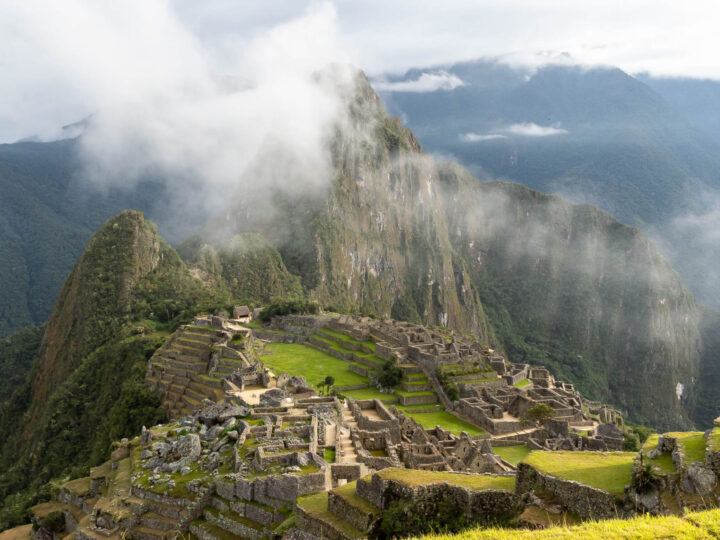
Whether you’ve been dreaming about reaching Machu Picchu via this lesser-known route or have had to switch up your plans because the Inca trail is fully booked, here’s everything you need to know about hiking the Salkantay trek.
Click to navigate this article:
Key facts about the Salkantay trek
How many miles is the salkantay trek.
The Salkantay is a roughly 66-kilometer (41-mile) hike that starts in the sleepy hamlet of Soraypampa and ends at Aguas Calientes, the town below Machu Picchu. There are various different routes that you can take, depending on how many days you want to walk and which company you’re hiking with. The most common route is the five-day, four-night route, whereby you leave Cusco around 4 am and start on the trail around 8 am, scaling the Salkantay Pass on day one and arrive in Aguas Calientes on the evening of day four to spend the final day at Machu Picchu. Alpaca Expeditions, like a handful of other companies, have their own glass-roofed huts at Soraypampa, where the trek begins. This means that they take their groups to the trailhead the day before (departing at 3 pm from Cusco) to allow you to start early and beat the other hikers to the trailhead. As a result, they advertise their trek as a five-day/five-night Salkantay hike. Their hikes also include the route up to Lago Humantay, which adds an extra three hundred meters of ascent and descent to the first day’s hike, plus the incredible scenery of this turquoise lake.
What is the elevation of the Salkantay trek?
The Salkantay trek starts at Soraypampa at an elevation of 3,900 meters above sea level. The elevation profile for the rest of the hike is as follows: Day One: Soraypampa (3,900 meters) – Humantay Lake (4,200 meters) – Soraypampa (3,900 meters) – Salkantay Pass (4,620 meters) – Wayramachay (3,800 meters) Distance covered: 20 kilometers (12.5 miles) Total elevation gain: 1,020 metres Total elevation loss: 1,120 metres Day Two: Wayramachay (3,800 metres) – Loreta (2,200 metres) Distance covered: 20 kilometers (12.5 miles) Total elevation gain: 200 metres Total elevation loss: 1,600 metres Day Three: Loreta (2,200 meters) – Llactapata (2,700 meters) Distance covered: 12 kilometers (8.7 miles) Total elevation gain: 600 meters Total elevation loss: 400 meters Day Four: Llactapata (2,700 meters) – Hidroelectrica (1,820 meters) – Aguas Calientes (2,000 meters) Distance covered: 15 kilometers (9.3 miles) Total elevation gain: 180 meters Total elevation loss: 880 metres The first night sleeping at altitude you’re inside a cabin, with a sleeping bag (either your own or rented) and it’s pretty cozy. The second night was also at altitude and despite the sleeping bag, extra blankets, two sleeping mats, and hot water bottle that Alpaca provided, I was still a bit cold and ended up sleeping in my down jacket. I highly recommend bringing a down jacket (mine is this one from Jack Wolfskin but you can find plenty of down jackets at REI ) plus a waterproof coat (mine is this one from Patagonia ; for men from Patagonia | REI | Backcountry ). They did give us rain ponchos but frankly, any sort of plastic coat is a recipe for sweaty hiking, so I much prefer to have a breathable, lightweight coat that’s great as a windproof layer at high elevations and also as protection against any downpours.
How fit do I need to be to hike the Salkantay trek?
The Salkantay trek is a moderate hike. The challenge comes from the amount of ascent and distance you’re required to cover on day one, as well as the altitude at which you’re hiking. The toughest day by far is day one. Not only do you gain 300 metres to reach the dazzling waters of Lago Humantay, but you lose them again as you drop back off the mountain and then climb a further 720 metres to reach the Salkantay Pass. Because you’re hiking at altitude, it won’t be long until you realise how thin the air feels (and how little of it seems to be going into your lungs). If you’re relatively fit and can cope with covering 20 kilometres (12.5 miles) in a day, you shouldn’t have any issues. Many of my group who had flown straight from home to Peru and hadn’t had time to acclimate beforehand in Cusco for a couple of days really struggled with the first day of the trek. Therefore I strongly recommend spending at least two days in Cusco before the hike for acclimatisation purposes and also speaking to your doctor to get a prescription for Diamox – tablets that help your body cope at high altitudes. You’ll want to take the tablets once per day, starting 24 hours before you start the trek and continuing until day three when you won’t need them anymore.
How can you prepare for the high-altitude Salkantay trek?
While being moderately fit and physically able to walk at least 20 kilometers (12.5 miles) at lower elevations is essential, preparing for high-altitude trekking is challenging. This is because you can’t predict how your body will react when it’s faced with these conditions – particularly as it’s not impacted by how fit, young, or healthy you are. In fact, even the fittest people can suffer horrible altitude sickness. As a result, the best preparation for hiking the Salkantay trek is to arrive in Cusco at least two days before the trek begins to give your body time to acclimate. Get plenty of sleep, stay hydrated, and be sure to get some Diamox to help your body adjust.
Do I need to book the Salkantay trek months in advance like the Inca trail?
Unlike the Inca trail, where there is a limit of 400 trekkers per day and so tickets can be sold out up to six months in advance, there are no limits for the Salkantay trek. This makes it an excellent alternative if you’ve been hoping to hike the Inca trail but have found that there isn’t any space. The only restriction you’ll face is on the availability of entry tickets to Machu Picchu, so it’s still worth trying to book at least a few weeks in advance, particularly if you’re traveling between June and August. As a result, you’ll find it a good idea to book your trek in advance before you arrive in Peru; you can also check out what we think are the best times to visit Machu Picchu before deciding when to travel. Better still, while an unlimited number of hikers allowed on the trailhead doesn’t sound fun, if you trek with Alpaca Expeditions, you’ll likely not see anyone else. This is because they schedule the trek to avoid all of the other tours leaving from Soraypampa. Through this wizardry, during the entirety of the five-day trek, we met only six other hikers.
The five-day Salkantay trek to Machu Picchu
The Inca trail is famous for taking you along a stretch of the Qhapaq Ñan or Royal Road, a path used by Inca royalty as well as pilgrims and other administrators to travel between Cusco and Machu Picchu.
However, what you probably didn’t know is that the Salkantay actually travels along a stretch of Inca road on day three, allowing you to have a little bit of the same experience, just without sharing it with anyone else.
Planning Your Trip to Peru?
Save time, stress & money with a customized travel itinerary planned for you by a Peru expert
The scenery is also spectacular and involves a little bit of each of the microclimates that are found surrounding Cusco, and which pay host to everything from spectacled bears (the inspiration for Paddington!) to llamas, alpacas, condors and vizcachas (chinchilla-like rodents).
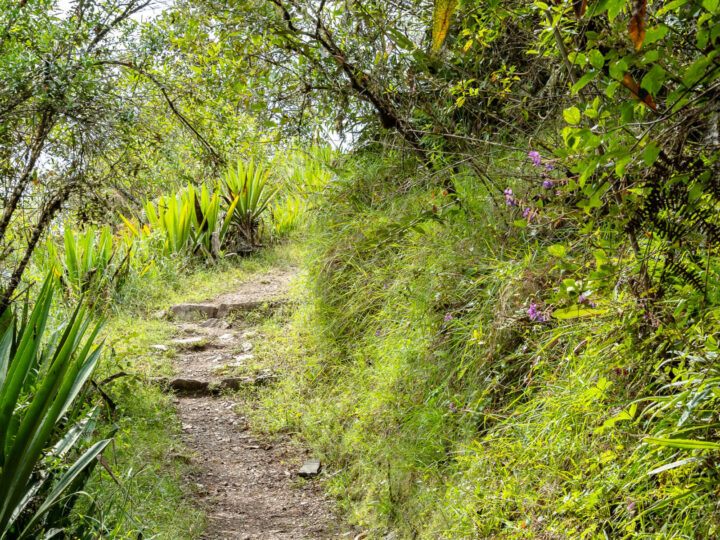
You travel from high mountain passes to lush cloud forest in just over a day, while you’re always far enough away from towns and villages to have gorgeous starry skies at night.
Best of all, unlike on the Inca trail, you don’t share campgrounds with other groups. In fact, we saw only six other hikers from when we started the hike to when we reached Hidroelectrica and began the final trek along the railway line.
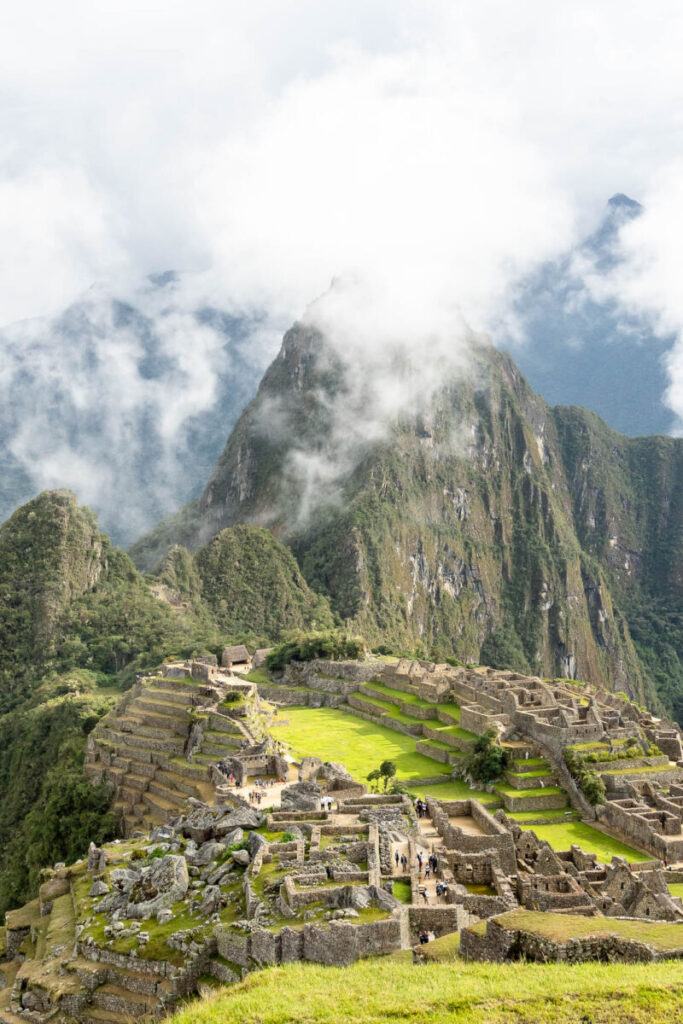
Want a cheeky 5% discount on the Salkantay trek?
Alpaca Expeditions are not only one of the most sustainable companies offering Salkantay and Inca trail treks to Machu Picchu, but their guides, porters and chefs are the ultimate hosts.
They’re now offering Worldly Adventurer readers a 5% discount on all of their hikes – use discount code WorldlyAdventurer when you enquire!
Therefore, if you’re like me and prefer hiking in destinations where you aren’t surrounded by others, this is the perfect route for you.
But what’s the hike like day by day? Here’s an itinerary of what you can expect on the Salkantay trek.
Day Minus One: Pre-trek information session
- Distance hiked: 0
- Total elevation gain: 0
- Total elevation loss: 0
- Time on the trail: 0
I started my Salkantay trek experience two days before we actually started hiking. This is because Alpaca Expeditions invited all of my group to their office in Cusco for a short information session to go over everything we needed to know before we started the hike.
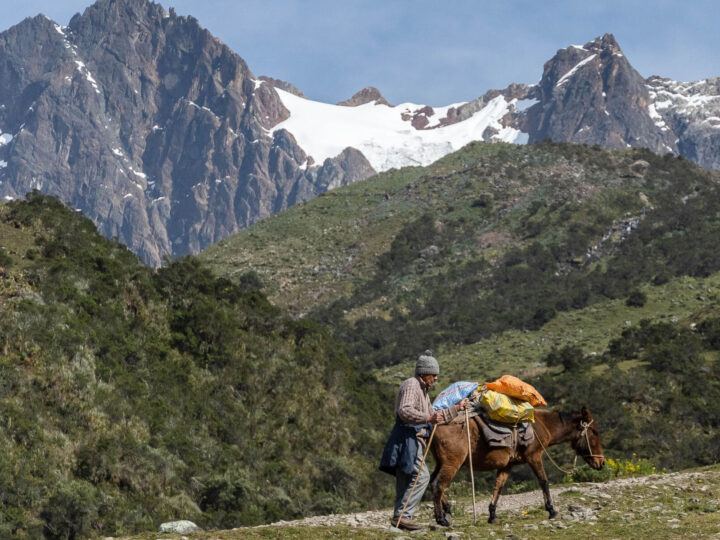
It was a quick, 15-minute meeting with our guide, Isao, where we were given our lime green duffel bags (for up to seven kilograms of clothes and other items for the hike that would be taken on mules), bright green rain ponchos and rucksack rain covers.
We were also able to reserve a sleeping bag, sleeping mat and trekking poles at this stage, while they made recommendations for essentials we needed to bring (bug spray – bring plenty!).
If I’d been sensible and brought some with me, I would have started taking Diamox this evening or on day zero to help prepare my body for the altitude. Don’t be like me: I highly recommend discussing Diamox or similar with your doctor if you’re planning a short trip to Peru to hike the Salkantay.
This is because going directly from sea level to an altitude of up to 4,620 meters (15,157 ft) can be extremely dangerous – trust me: you don’t want to feel as shit as those people in my group who did this.
Day Zero: Cusco to Soyrapampa
On day zero you’ll have time for a relaxed morning and lunch in Cusco, before you’re picked up at your hotel by the Alpaca Expeditions team around 3pm. The minibus will head directly out of Cusco for the spectacular drive through the Andes to the first night’s accommodation.
It’s three and a half hours of serpentine roads with sheer, vertiginous roadsides and lush valleys lined with avocado plants.
Keep your eyes peeled for the first glimpses of Nevada Salkantay; we saw it sink into darkness as the sun set behind its snow-laden peak before our van began gaining altitude quickly.

After about two and a half hours you’ll stop in Mollepata, a tiny town en route, to use the toilets and then stock up on any remaining items you might have forgotten, before an hour later reaching the first night’s accommodation: Soraypampa and its glass-roofed cabins.
If luck’s on your side, the stars should be bright and your chef, sous chef, and their merry band of porters will quickly rustle up a delicious two-course meal, giving you plenty of time to head to bed and sleep beneath the stars before an early wake-up call the next morning.
Day One: Soraypampa – Humantay Lake – Salkantay Pass – Wayracmachay
- Distance hiked: 20 kilometers (12.5 miles)
- Total elevation gain: 1,020 meters (3,346 feet)
- Total elevation loss: 1,120 meters (3,674 feet)
- Time on the trail: Around six hours, plus lunch and breaks
Day one starts early. At 4.30 am, you’ll be woken up by a knock at the door. For us, it was by Juan Carlos, our second guide, bearing coca tea (coca leaves infused in water) to help settle heads and stomachs from any potential altitude sickness.
While there are flushing toilets at this accommodation, showers there are not, but your guides will ensure you have hot water for washing hands and faces at every mealtime along the trek.
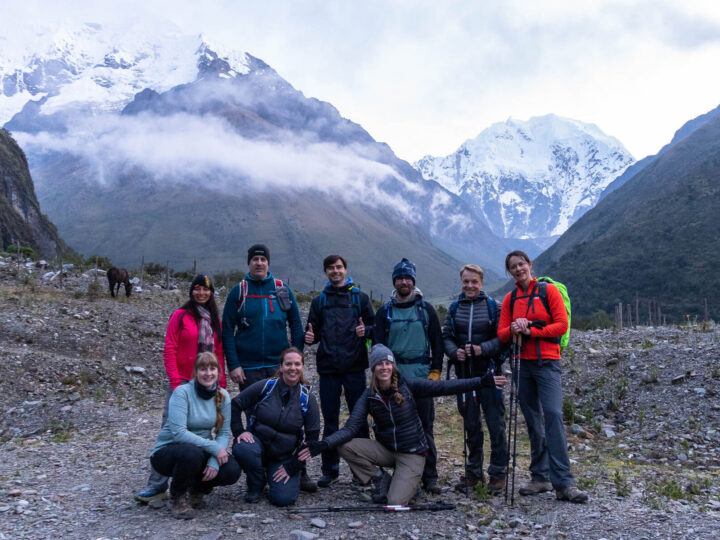
There will be time for a filling breakfast – omelets, pancakes, cereal, and bread – and to pick up snacks and water ready for the day. Today will be the hardest of the entire trek – there’s no gentle first day to ease you into it – so eat plenty and stay hydrated. You’ll need all the energy you can get.
At this stage, your body, with the help of Diamox, should be starting to acclimatize to the altitude and be ready for the two-hour climb up to Lago Humantay.
Mine felt ok, but as we began the trek, climbing a gentle gravel road that became a steep trail as it emerged out of the valley and up to the shores of Lago Humantay, my lungs were burning and the effort of hiking was already beginning to feel like a challenge.
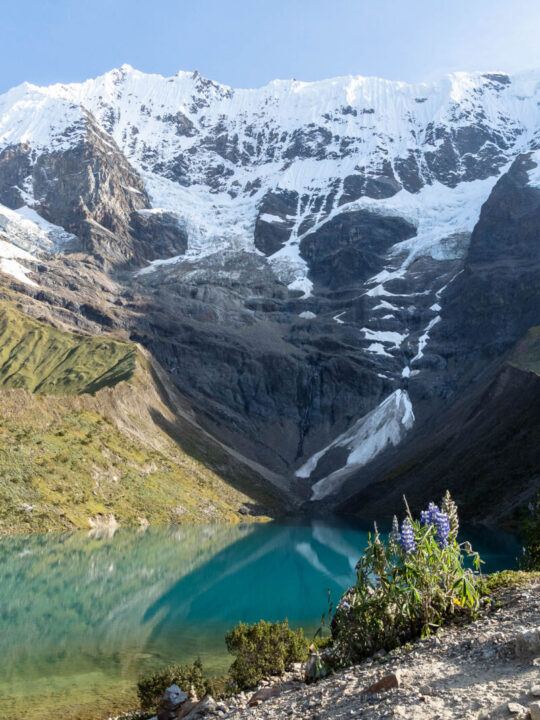
At the top, there’s time to relax, take copious photos, and dive into your snacks, before you head back down the way you came, joining the main Salkantay trail back at the bottom of the valley.
For us, we began the ascent to the Salkantay Pass around 10 am, relieved to discover that the other groups of hikers for that day’s walk were long gone, leaving us the trail to ourselves as we passed meadows filled with llamas and then the barren slopes of Nevada Salkantay.
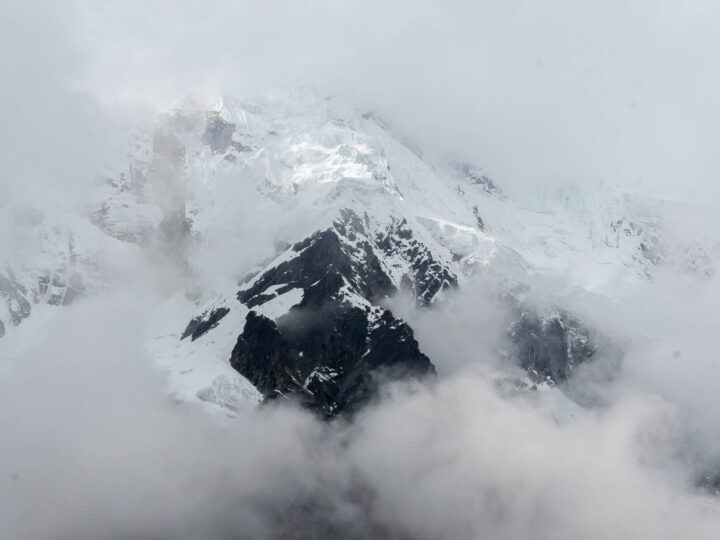
Keep your eyes peeled for stone-colored vizcachas hiding in the rocks alongside the trail; these chinchilla-like rodents live in this otherwise empty landscape.
After a further 4.5 hours, and about an hour from the top, you should arrive at your first lunch: prepare to be amazed by what your chef and porters can put together, despite being miles from civilization.
Our chef, Sergio, his sous chef, and porters had prepared us an extensive lunch of roast chicken, salads, rice, and plenty of vegetables to help give us enough energy to get over the pass. If you’re lucky and well acclimatized, you’ll be feeling extremely hungry right now, so fill your boots and also have a good few cups of coca tea – they’ll help stave off any incoming headache.
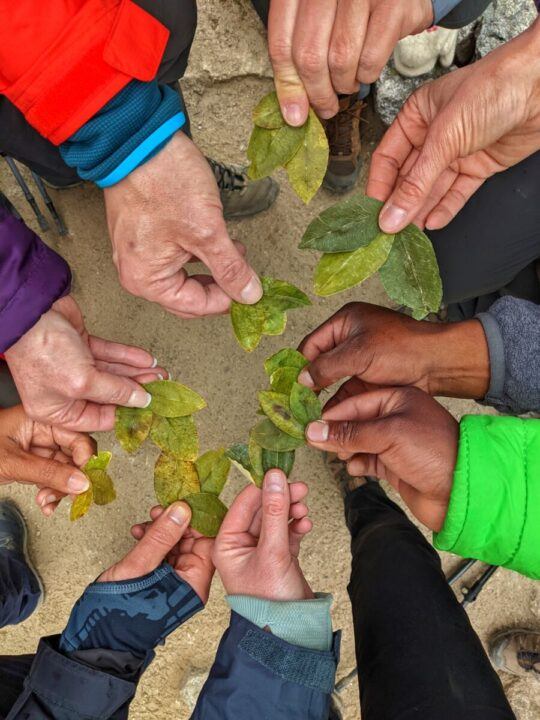
From lunch, it’s a thankfully short final hour to reach the Salkantay Pass. At 4,620 meters above sea level (15,157 feet) and in the shadows of snow-capped Salkantay, it’s the highest point on the trek and you deserve to celebrate here.
We followed Quechua traditions and made an offering to the Apus (the Gods of the mountains) of some coca leaves given to us by our guide, Isao, while making three wishes. I’m fairly certain at least a few members of the group were wishing to get out of there quickly!
After the pass, it’s a long, two-hour hike down the camp, through the quickly changing scenery that passes from barren rock to become a verdant river valley flushed with powder blue lupins. It’s a dramatic contrast between the hike up and the scenery as you come down.
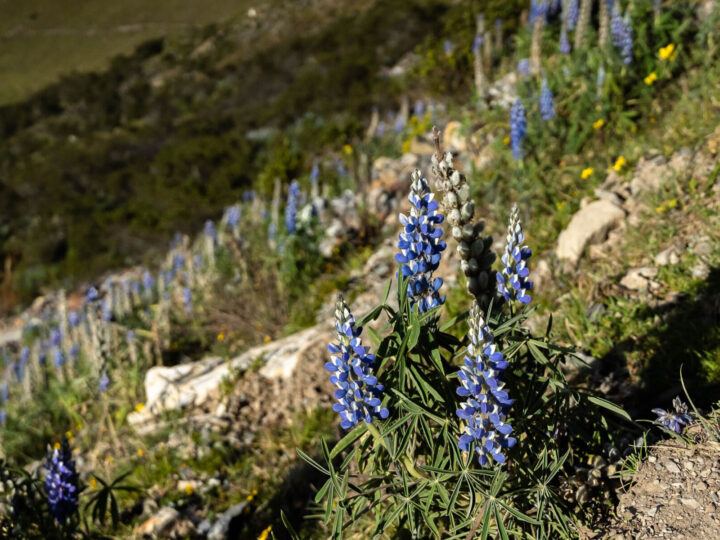
When you arrive, finally, at Wayracmachay, your first camp on the trek, your camp fairies (aka the porters, chef, and sous chef) will have been busy preparing the camp. Our tents had been filled with our mats and sleeping bags, plus the welcome addition of fluffy alpaca blankets and, when it was finally time for bed, some extremely welcome hot water bottles.
You’ll find flushing toilets, but no showers, here, too.
Dinner will be another feast of hearty, filling Peruvian food that’ll put you to sleep early, ready for another pre-dawn start.
Day Two: Wayracmachay – Colpapampa – Loreta
- Total elevation gain: 200 meters (656 feet)
- Total elevation loss: 1,600 meters (5,249 feet)
- Time on the trail: Around seven hours, plus lunch and breaks
Today, you’ll rise before dawn again, ready for a big breakfast of pancakes, omelets, bread, and the obligatory coca tea to help you start the day.
While day two of the Salkantay trek is as long as day one, the vast majority of the trail is downhill, so you’ll find it much less taxing.
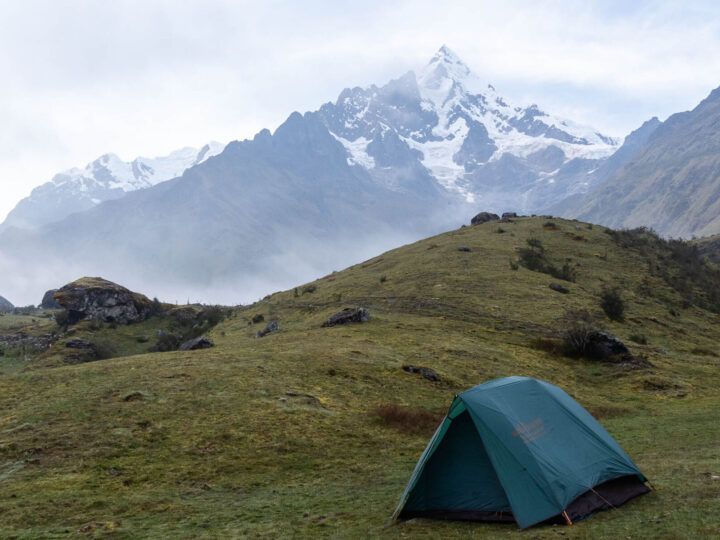
From Wayracmachay, it’s a gentle downhill hike along a gravel path. As a group, we had decided that downhill sounded too boring for the day (!) so Isao and Juan Carlos took us off-piste to climb another hill (just 100 meters of ascent this time).
By this stage, the scenery had changed dramatically, and we’d dropped far enough down to find ourselves in thick, lush cloud forest, filled with butterflies and bromeliads suspended from the trees.
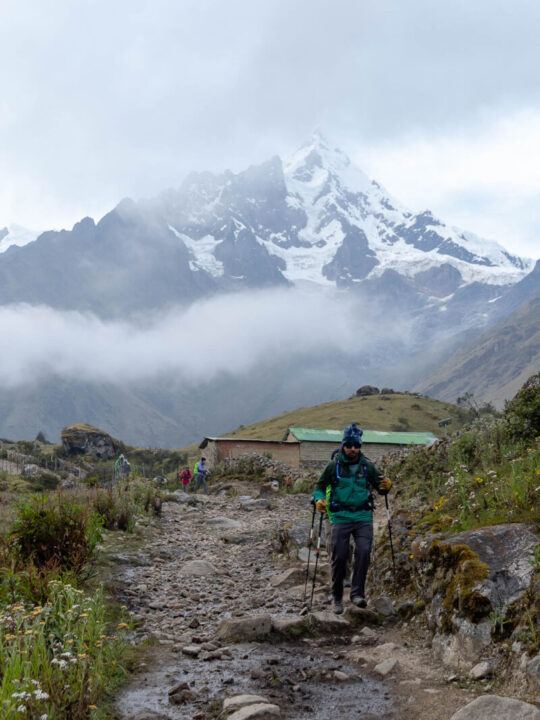
If your guides offer you this detour, I strongly suggest taking it. The payoff for climbing this extra hill is some seriously incredible views back across the valley towards Salkantay and then down into the next valley, where lunch and your accommodation for the night are located.
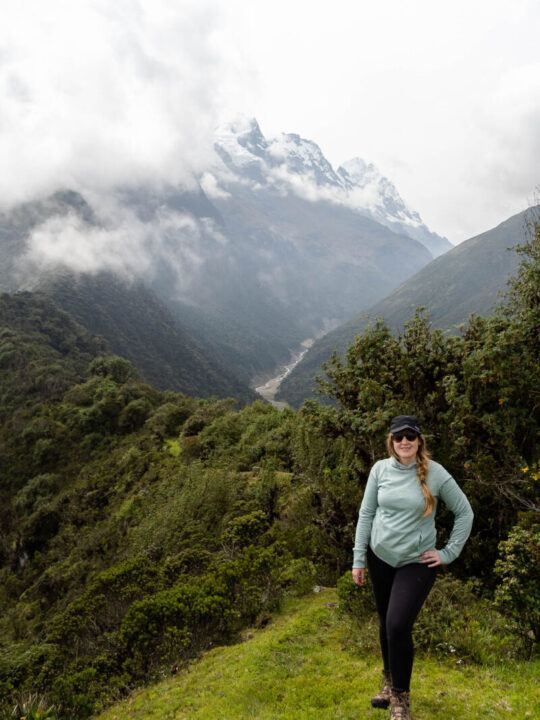
The views change by the second; the clouds move rapidly as the valley and the mountains beyond appear and disappear in turn.
From this incredible vantage point, it’s a steep downhill – through cloud forest thick with orchids and hummingbirds to finally hit the road beneath and lunch at Colpapampa. For us, it was mango ceviche followed by mountains of lomo saltado , vegetables, salads and rice.
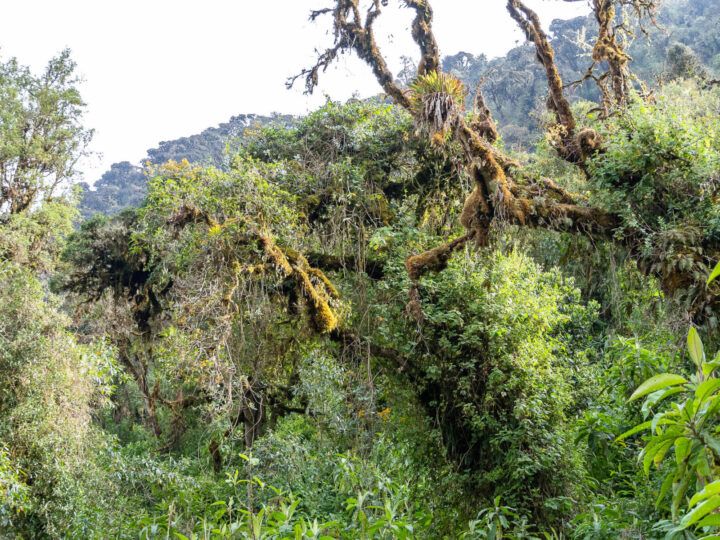
The final few hours to reach your accommodation are along a flat gravel road that follows the Rio Salkantay as it weaves through the valley.
Finally, you’ll descend down an incredibly steep path to reach your home for the night: Alpaca Expeditions’ very own hobbit holes, complete with lime green, round front doors, and comfy beds. There are even hot showers available and, the pièce de résistance : jacuzzis.
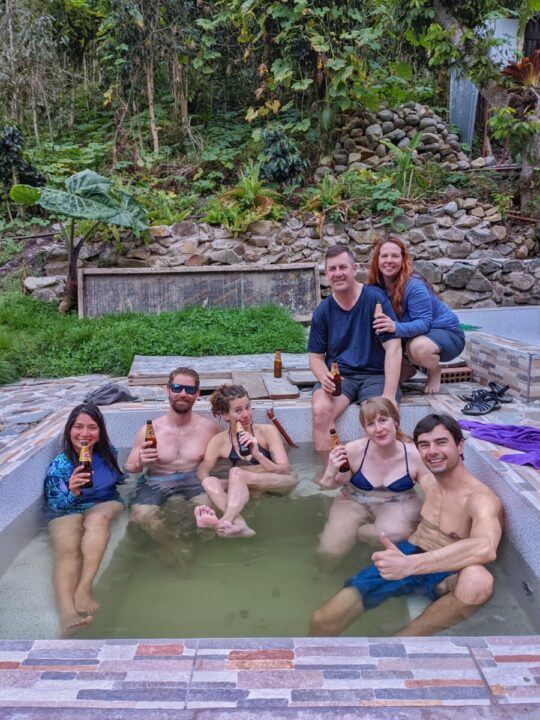
We saluted a long but incredible day with some cervezas (beers) and even a small pisco sour prepared unexpectedly for us by our chef, Sergio. It’s fair to say we slept like babies – you will too.
Day Three: Loreta – Lucmabamba – Llactapata
- Distance hiked: 14 kilometers (8.7 miles)
- Total elevation gain: 600 meters (1,968 feet)
- Total elevation loss: 400 meters (1,312 feet)
- Time on the trail: Around five and a half hours, plus lunch and breaks
Day three starts with a gentle walk through a clutch of villages tucked into the cloud forest, where you’ll meet the resident dogs, chickens, and any other livestock that’s wandering around.
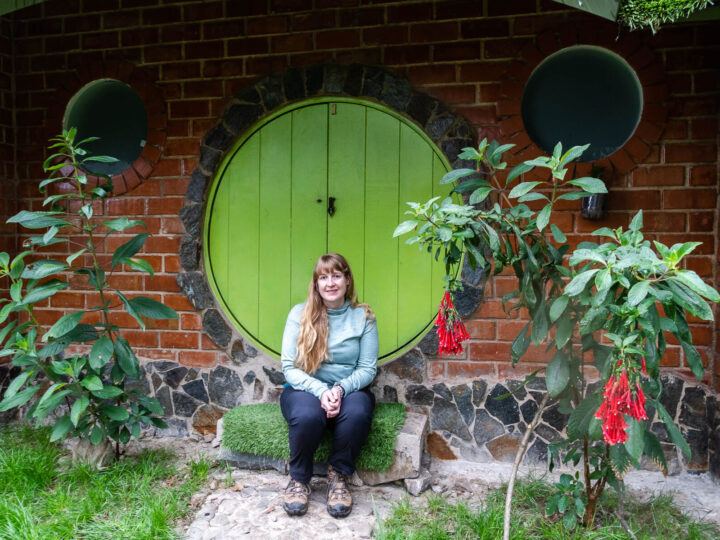
Today will be a fairly relaxed day and give you the opportunity to hike a stretch of the Inca trail that clambers up through lush forest and coffee plantations and, for some parts, still consists of worn stone steps.
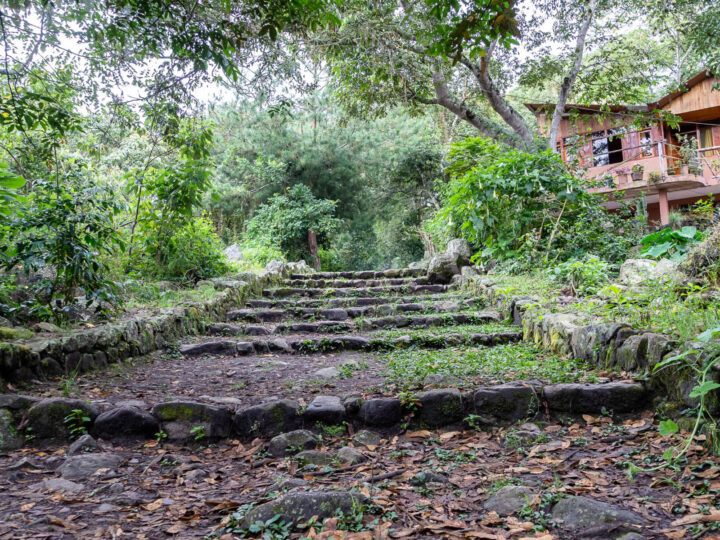
As you climb this five-hundred-year-old stone staircase into the mountains, you’ll realize quite how relieved you are that you didn’t do the Inca trail. It’s tough going on your thighs (perhaps even more so than the climb up to the Salkantay Pass), but a fairly gentle incline up to lunch at a coffee farm, where you’ll also have the chance to pick, toast, and grind your own steaming cup of Joe alongside the owner, Paulina.
Support sustainable tourism, porters’ rights and female empowerment by booking the Salkantay trek with Alpaca Expeditions and get a 5% discount on the cost of the hike by using discount code WorldlyAdventurer!
Your chef will also give a demonstration about cooking a traditional Peruvian dish (in our case lomo saltado , with fake meat for the vegetarians), before you dine again like kings, with incredible views across the valley.
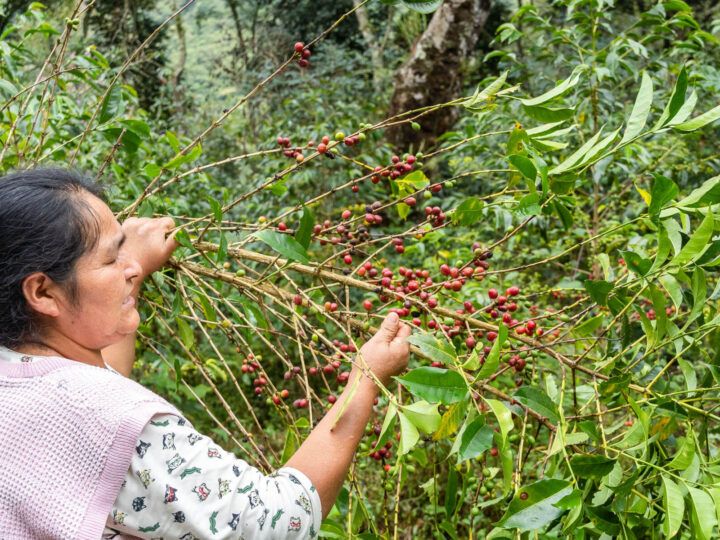
In the afternoon, it’s a tough, sweaty climb up, up and up, although you’ll take plenty of breaks and have the chance to enjoy the pretty flowers and picturesque valley views that characterise this part of the hike.
After around three and a half hours of walking, you’ll finally reach the brow of the hill, from where it’s a short hike down to Llactapata.
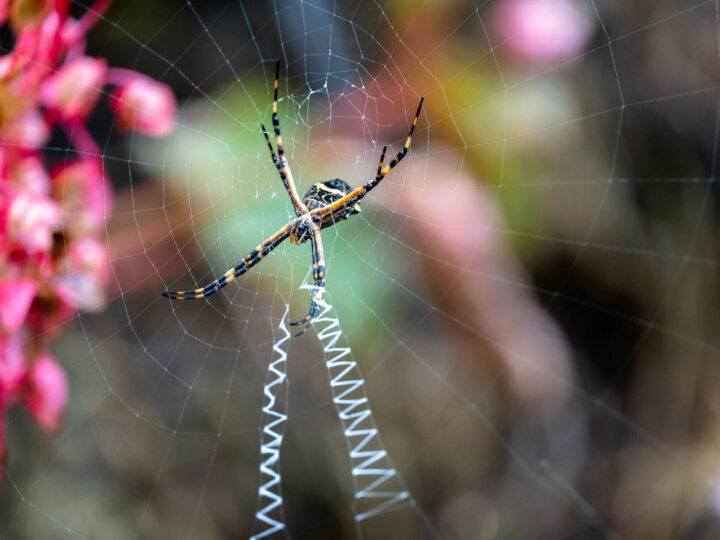
An Inca site, it sits across the valley from Machu Picchu – the Inca liked to be able to see this city from other parts of their Empire – which you can see in the distance. It’s here that you’ll suddenly realize just how far you’ve come and how close you are to the end of the hike.
After half an hour learning a little about this site, which would have acted as a waystation for the chaskis (the messengers of the Inca, who ran along the Inca roads delivering messages across the Empire), it’s a 20-minute hike down the mountain to reach perhaps the most surreal of you campsites.
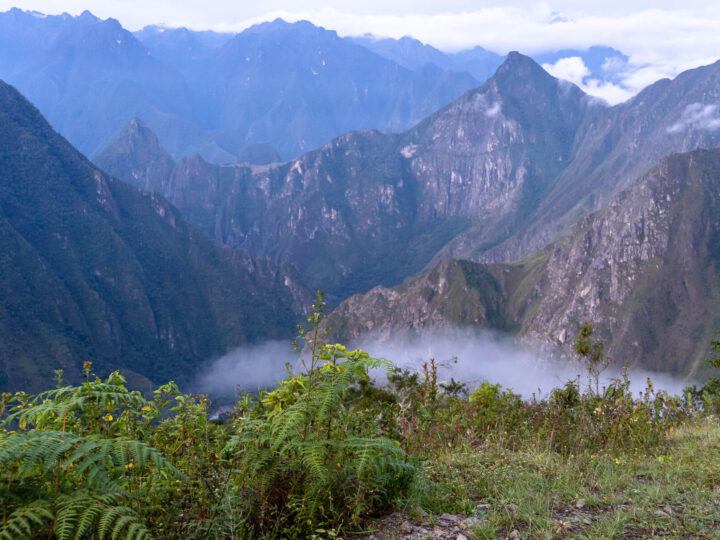
Offering even closer views of Machu Picchu from its lofty position, the campground below Llactapata is the most remarkable of the whole trip. It’s possible to spend hours here, watching as the sun slips away past the mountains in the west and bathes the Cordillera de Vilcabamba in which Machu Picchu lies in gentle evening light.
If you can tear yourself away from the view, you’ll be delighted to learn that after a sweaty day’s hike there are hot showers at this campsite (costing around S/10), and mountains of food to help you sleep soundly.
Because you’re still far away from any towns, there’s very little light pollution, so if the skies are clear, you can expect a sensational view of the Milky Way and the night sky.
Day Four: Llactapata – Hidroeléctrica – Aguas Calientes
- Distance covered: 15 kilometers (9.3 miles)
- Total elevation gain: 180 meters (590 feet)
- Total elevation loss: 880 meters (2,887 feet)
You’ll wake early again today in time to eat breakfast as the sun’s rays climb above Machu Picchu and bathe you in their glorious light.
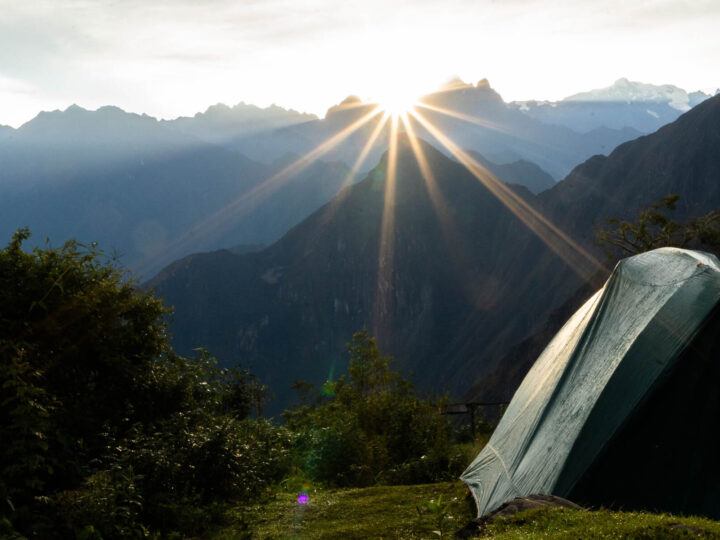
There will be time to enjoy the views while your team packs up camp and you should be on the trail by about 7 am, for a snaking, tough-on-the-knees, steep climb down the mountain and along the Río Ahobamba to reach Hidraelectrica, the hydropower station that produces electricity for Aguas Calientes and Machu Picchu itself.
Here you stop for a final leisurely lunch with your porters and cooking team, before it’s time to bid them farewell and continue along the side of the railway line that connects Hidroeléctrica with Aguas Calientes and beyond, Ollantaytambo.
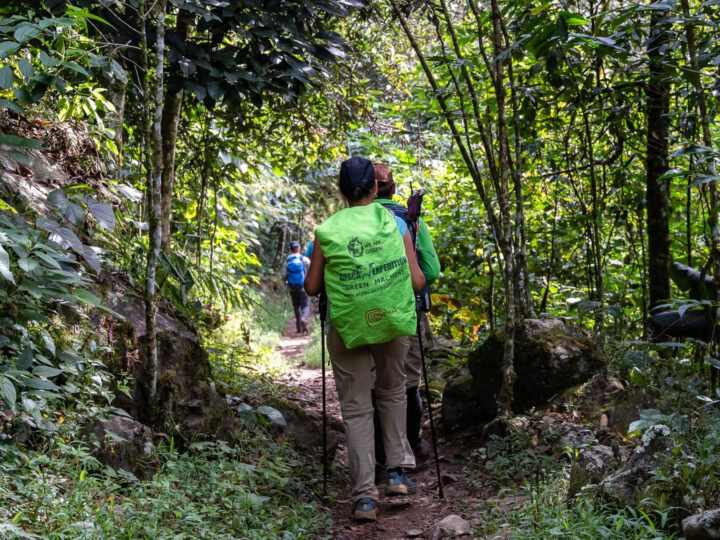
While the hike itself is hot and sweaty and feels like you’re starring in the film Stand By Me (yes, you do need to keep an eye out for trains as it’s a functioning railway line – although they do tend to make an awful lot of noise on the approach to allow you to get out of the way), it takes you through the deep mountain canyon that is the Urubamba Valley, with the dramatic steep valley sides rising high above you.
Along the way, you’ll find the occasional shops operated by those who live in houses dotted along the railway line, where you can pick up snacks of fresh watermelon or ice-cold drinks.
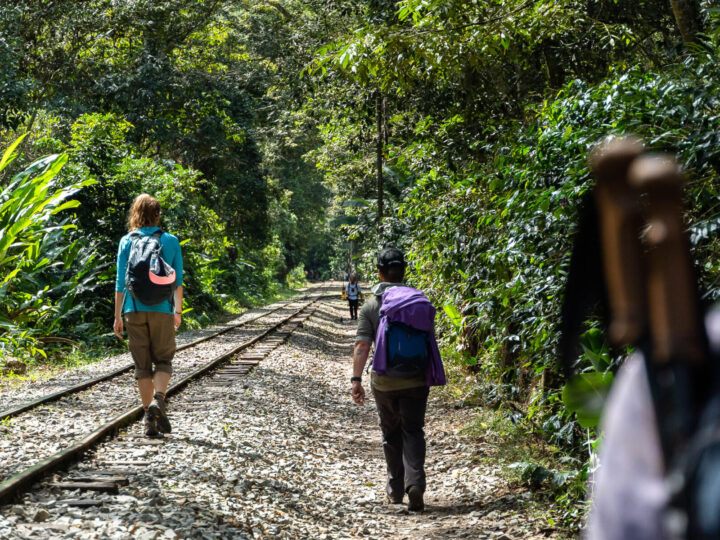
It’s around 10 kilometers (six miles) along the railway line and a three-hour hike. Finally, you’ll reach the edges of Aguas Calientes, the small but picturesque town that sits beneath the Inca city.
Here, you’ll be checked into your hotel and have some downtime to explore the town or just take a long, hot shower, before heading out for dinner with your group.
Day Five: Machu Picchu
- Distance hiked: Depends; the path around Machu Picchu is a couple of miles
- Total elevation gain: Roughly 10-20 meters (32-65 feet)
- Total elevation loss: Roughly 10-20 meters (32-65 feet)
- Time on the trail: Depends; around three hours if just exploring the site. Add a further two hours if hiking to Huyana Picchu.
Today’s the day you’ve been waiting for: Machu Picchu. To get on the first bus up to Machu Picchu, you’ll wake around 4.30 am and aim to be at the bus stop by 5.30 am, read when it leaves.
It’s a 30-minute drive up to the entrance and definitely worth taking the bus (the tickets are included in the cost of your tour): the walk looked exhausting and takes at least two hours.
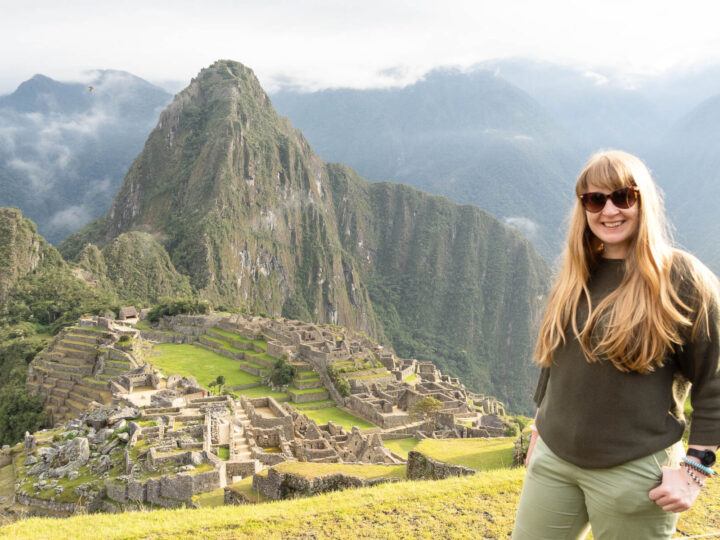
At the top, your guide will show your tickets and you’ll climb the final few steps of Inca stone up into Machu Picchu, a former summer retreat for the Inca emperor and a remarkable example of Inca architecture.
At the viewpoint at the top of the site, if the weather’s clear, you can watch as the sun rises over the mountains, showering the stone buildings and Huayna Picchu, the mountain that sits behind, with morning light.
If it’s not clear, don’t worry: when we arrived, it was cloudy, but the weather came and went quickly, giving us good opportunities for capturing photographs and absorbing the surreal feeling of standing above Machu Picchu.
In total, you will have around three or four hours in Machu Picchu, which will involve a guided tour by your guide to learn more about life in Machu Picchu, the architecture, and the key buildings dotted around.
Since the pandemic, they’ve introduced a very strict route around the site, so you don’t have as much opportunity to explore as you once had. However, it definitely felt like plenty of time for visiting and learning more about the Inca Empire.
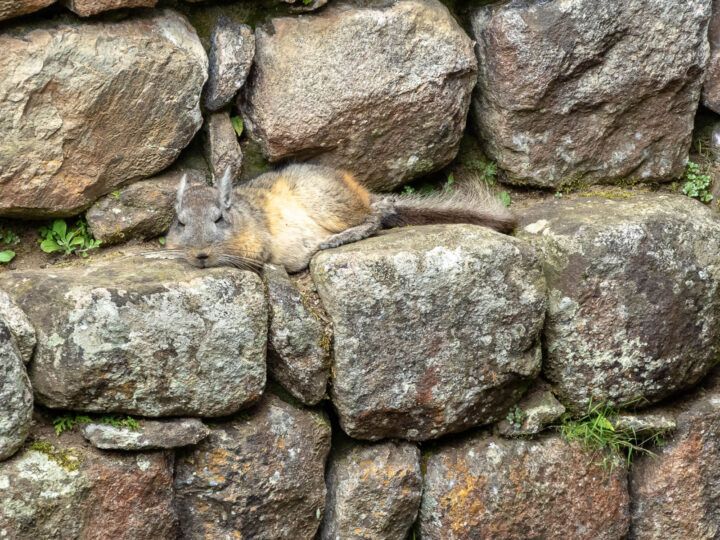
If you want to hike up Huayna Picchu, this will take around two hours and you can expect an alternative view of the site from the top.
As my tour was booked quite last-minute, I didn’t manage to get these tickets (it’s recommended to buy them at least a couple of months in advance as they sell out; book them here selecting “Circuito 4 + Waynapicchu”), but other members of my group highly recommended it. The path up is very steep, so definitely not for the faint of heart.
Around noon, you’ll catch the bus back down to Aguas Calientes for a final lunch. This wasn’t included in our tour, but there are plenty of restaurants within the town. I recommend Chullos Craft Beer & Homemade Food for great local food and beautiful views of the river.
Early afternoon, you’ll board the train to Ollantaytambo, a stunning, two-hour journey that takes you along the Urubamba Valley and, thanks to the train’s large windows, gives you dazzling views of the surroundings.
At the station in Ollantaytambo, a bus will be waiting to take you back to Cusco, a final two-hour journey through the mountains. Be sure to have your accommodation booked ready for you when you in the town. You’ll be exhausted but still reeling from an incredible six days!
Preparing for the Salkantay trek
When to travel to cusco and machu picchu.
Unlike the Inca trail, which needs to be booked at least six months in advance, the Salkantay is a trek that can be organised with a lot less advance notice. This is because permits are not required to hike along this trail; instead, you’ll just need to make sure you’ve got a ticket for Machu Picchu (read our really detailed Machu Picchu guide to help you prepare for your trip).
That said, if you’re planning on visiting between the peak months of May and September, you’ll likely need to reserve this trek at least a few weeks in advance to ensure that there’s time for the company to book Machu Picchu tickets for your dates.
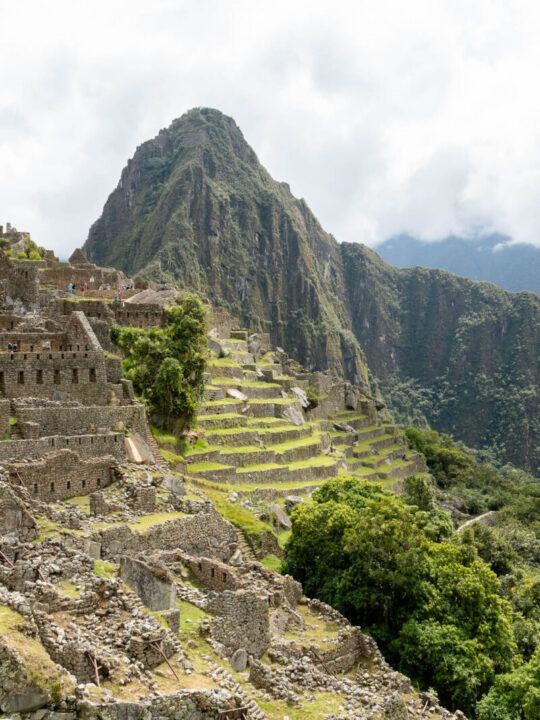
It’s possible to hike the Salkantay trek all year round, but for the best conditions (and to get those iconic views at Machu Picchu on the final day), try to avoid the rainy season, which is between November and February.
Alpaca Expeditions do run this trek from the start of March through the middle of January, but as someone who has lived in Cusco and knows how hard it can rain here, I imagine trekking during the rainy months would be a very soggy experience.
Choosing a sustainable and ethical tour company
One of the main reasons I chose to hike with Alpaca Expeditions is because of their attitude towards their staff. They pay some of the highest wages for porters and guides; the minimum wage for porters by law is S/44 per day, while Alpaca pays them S/180 per day.
As many of their staff come from indigenous and often poor Andean villages scattered across the region, Alpaca Expeditions have also built a house in Ollantaytambo where their staff can stay the night before or after a trek, with its own resident doctor offering them healthcare.
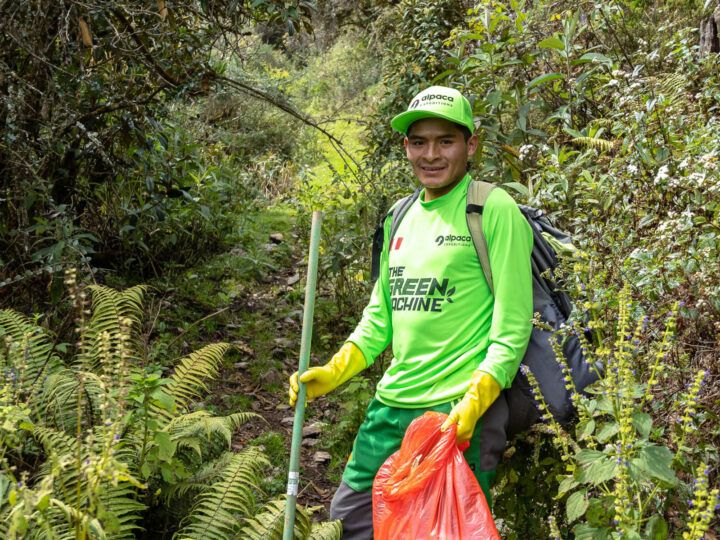
What’s more, due to limits on entering Machu Picchu, porters who accompany groups of hikers aren’t allowed to enter the site, and many can’t afford the expense of visiting Machu Picchu on their own dime. This means many have spent years hiking to Machu Picchu but have never actually gone in.
To address this injustice, Alpaca Expeditions take groups of their porters, chefs, guides and their families to Machu Picchu twice a year, ensuring that all of their staff can experience the culture of their ancestors and learn about their own history.
Alpaca Expeditions are also leading the way when it comes to female employment. They were the first tour company to introduce female guides (2017) and then porters (2018) onto the Inca trail and now have women working in every role on the trek and in their office, with an aim to employ an equal number of men and women in the future.
They’re also doing some amazing work to allow local communities to visit sites such as Machu Picchu, as well as the archaeological sites of Pisac, Ollantaytambo and others in the Sacred Valley .
To achieve this, every Sunday they pay to take a group of 15-17 local children from Cusco or surrounding villages to visit some of these sites and learn more about their heritage, ensuring that they have the same access to their history as the thousands of tourists who explore the region each day.
I followed along for one of these days and it was wonderful to see the kids soaking everything in and even getting to experience the incredible Alpaca Expeditions outdoors lunch, too!
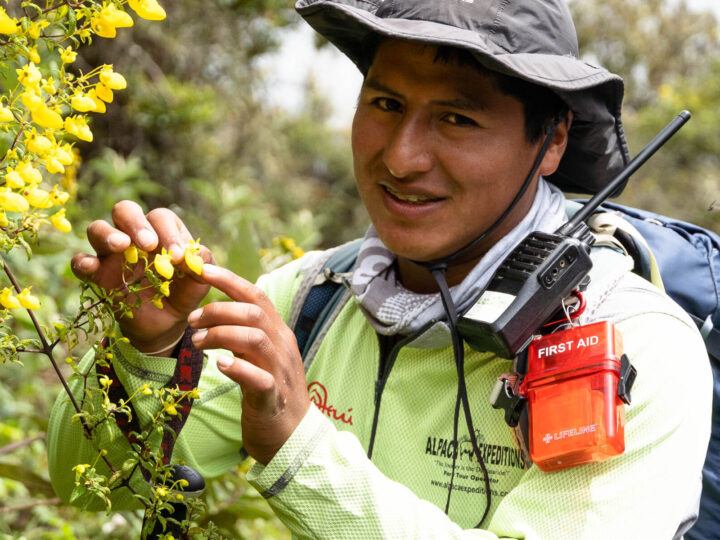
All in all, I found the experience on the trail with Alpaca Expeditions to be even better than I had expected. Their staff are absolute heroes: our guides were good-humoured and extremely supportive when the going got tough on the first day and the rest of our team of chefs and porters ensured that every single meal and camp felt like we’d stepped into our own private resort, no matter how remote the location.
The cost of hiking the Salkantay trek
The cost of the trek varies depending on the company with whom you go. Alpaca Expeditions isn’t the cheapest and nor is it the most expensive. They offer the five-day/five-night tour that I did at a cost of just $650 USD per person and you can potentially have a group size of up to 16 people. We had nine in ours and it felt like a really comfortable size.
They also commit to running a hike even if they just have two people signed up, which means you’re less likely to get your tour cancelled if they don’t manage to sell other tickets.
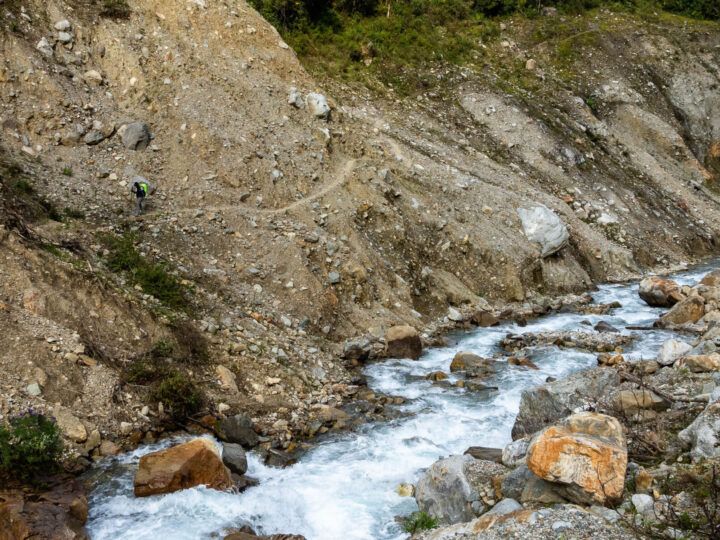
To secure your place on the trek, you will need to make a deposit of $400 USD per person either through PayPal (who’ll charge a 5.5% PayPal fee) or by wire to Bank of America or Citibank (free if you bank with either of these companies). Therefore, it’s worth being aware that the trek may well cost a little more when you’ve factored in the transfer cost.
Alcohol isn’t included in the cost of the hike but there are places en route where you can buy beers, ranging from a cheap S/5 to a more eye-watering S/20. If you think you’ll want a cold cerveza to celebrate a long day’s hiking, then bring extra soles (small notes preferably as change can be an issue) with you.
Tipping on the Salkantay trek
Before departing for the trek, it’s important to budget into your trip the cost of tipping. While it’s certainly not obligatory, tipping was brought up quite a few times during the hike and our guide made recommendations for the amount of money we should consider tipping per person.
This worked out around S/50 soles per porter (we had four for a group of nine people), $20 USD for both the chef and sous chef, and $40 USD each for our guides.
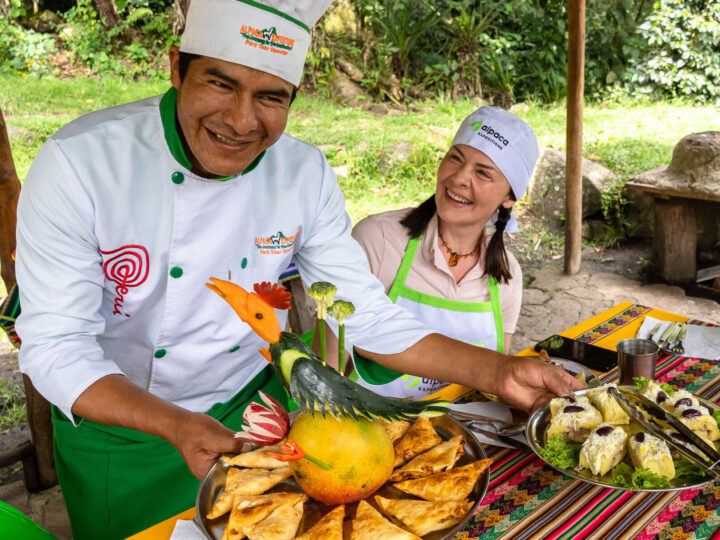
It’s worth bearing in mind that there’s often a limit of around S/750 soles (around $200 USD) per day that you can withdraw from ATMs in Cusco, so it might be sensible to bring dollars with you for tipping purposes if you also need to withdraw cash to pay for your tour when you arrive.
Another area to consider when it comes to hiking costs is whether your travel insurance covers hiking up to 4,600 metres.
My travel insurance with World Nomads * required me to pay for additional coverage up to their level three (camping up to 4,500 metres and hiking up to 6,000 metres), which cost an additional $75.33 for my two-week trip to Peru.
Packing for the Salkantay trek
If you book before you arrive in Cusco, you should get sent a packing list covering what they recommend you bring. In short, it includes:
- Your passport. You will need to show the original document to get into Machu Picchu. Don’t forget it, otherwise the hiking will have been in vain!
- A day pack. I brought my Osprey 40-litre pack ( REI | Amazon | Osprey ), which comfortably fitted my camera, down jacket, waterproof coat and a couple of other bits and pieces for the day. You could comfortably get away with carrying a 25-litre or 30-litre pack, as the majority of your belongings go into your duffel bag that’s carried by mule.
- A cosy sleeping bag. You can actually hire one of these for $25 USD for the duration of the trek, so unless you’re particularly attached to your own, then it’s probably easier to just pay this cost. I found the one I rented to be warm and comfortable. I generally recommend the Nemo Disco 15 for women ( REI ) and men ( REI ) if you want to buy one.
- Air mattress. Again, this can be rented for $25 USD. If you want to buy your own, I recommend this one from Therm-a-Rest ( REI | Amazon | Backcountry )
- Trekking poles. I made the mistake of turning these down when I was offered to rent them. Don’t be like me. They’re really helpful for the first day in getting you up the Salkantay Pass and absolutely ESSENTIAL in helping you get back down. Rent them for $25 USD or buy these lightweight ones ( REI | Amazon | Backcountry ).
- Well-broken-in hiking boots. I can’t stress enough how important it is that you wear hiking shoes that you’ve used before on this trek. Days are long and there’s absolutely nothing worse than getting a bad blister on the first day. All of the downhill can also wreak havoc with your toenails, so they need to be comfortable. I’m a convert of Salomon (women’s: REI | Amazon | Backcountry ; men’s: REI | Amazon | Backcountry )
- Five pairs of walking socks. Seriously, you need a clean pair for each day. I recommend Darn Tough socks (women’s: REI | Amazon | Darn Tough ; men’s: REI | Amazon | Darn Tough )
- Sandals. These are for the evenings when you’ll want to allow your feet to breathe. I love my Teva sandals (women’s: REI | Amazon | Backcountry ; men’s: REI | Amazon | Backcountry )
- Warm clothing. A down jacket (I wear this one from Jack Wolfskin; you can find plenty of others at REI ) and a lightweight waterproof coat (mine is this one from Patagonia ; for men from Patagonia | REI | Backcountry ) are essentials for this trek. I also had a midweight walking jumper and a fleece jumper (women’s: REI | Amazon | Backcountry ; men’s: REI | Amazon | Backcountry ).
- Two or three pairs of hiking trousers. You want lightweight trousers that won’t be too hot for the warmer days. I like these ones from prAna ( REI | Amazon | Backcountry )
- Long-sleeved hiking tops. I didn’t bring any of these and it was a mistake. Not only do they protect you from the sun (which is fierce at this altitude) but they can protect you from the mosquitos, too. We only really encountered these a little bit in the evening at Loreta (day three) and during the hike through the cloud forest on day four.
- Headlamp. This is essential for the camps, as many of them don’t have electricity. You don’t want to trip over and injure yourself when going to the bathroom in the middle of the night. I recommend this one .
- Camera. This hike is incredibly photogenic, so make sure you’ve got a couple of spare batteries for your camera. I travel with the Sony A7iii , an 18-135 lens and a spare battery.
- Phone charger and adapter plug. There is electricity on days zero, three and five. I use this universal adapter plug .
- A sunhat and sunglasses. Don’t burn your head or hurt your eyes.
- Mosquito repellent. You will want this for evenings on days three onwards and at Machu Picchu. I use Sawyer insect repellent ( REI | Amazon )
- Dry sacks. While Alpaca did give us plastic bags that we could put our clothes into to protect them from the rain in transit, I prefer to travel with a couple of dry sacks ( REI | Amazon ), as they’re reusable and more environmentally friendly!
Other options for hiking to Machu Picchu
Still not sure which is the right hike for you? Here’s a round-up of the other treks that can get you to Machu Picchu.
The Inca trail
- Length: 48 kilometers (29.8 miles)
- Hiking time: Four days/three nights
- Cost: From $695 USD
The best-known trek of all, the classic Inca trail is a four-day, three-night trek up and down the stone pathway of the Inca, stopping at a handful of other Inca sites before arriving at Machu Picchu at dawn on the fourth and final day through the Sun Gate.
This is the only trek that allows you to approach the site through this entrance and have the first dawn views of Machu Picchu.
Read all about the Inca trail to Machu Picchu for more information about this trek and this comparison of the Inca Trail and the Salkantay to learn the key differences.
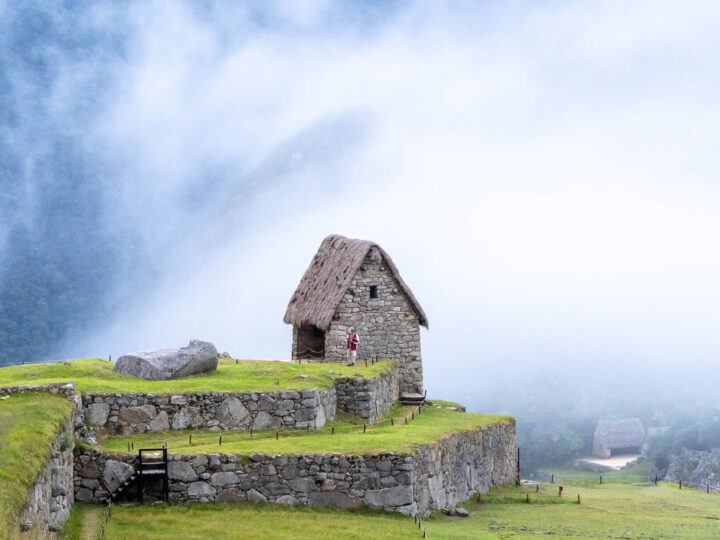
It’s also possible to extend this trip to five days/four nights to allow you to take a slower approach to the hike (perfect if you’re traveling with your kids), or do a shortened version of the Inca trail if you’ve got less time but still want to hike this fabled road.
You can even combine a bit of Salkantay with the Inca trail for a seven-day/six-night adventure .
The Inca Jungle trek
- Length: 89 kilometers (55.30 miles)
- Cost: From $450 USD
Keen to visit Machu Picchu but want to get your adrenaline pumping even more? The Inca Jungle trek is a route that combines mountain biking, rafting, hiking along sections of the Inca trail, and even ziplining.
It’s not a trip organised by Alpaca Expeditions but there are other companies based out of Cusco who do.
The Lares trek
- Length: 33 kilometers (20.5 miles)
- Cost: From $600 USD
Perhaps the least-known of the three main treks to Machu Picchu, the Lares is another alternative route that takes you through Andean villages around the Sacred Valley, where you’ll soak in natural hot springs and climb up into the mountains to a 4,680-metre (15,354-foot) pass.
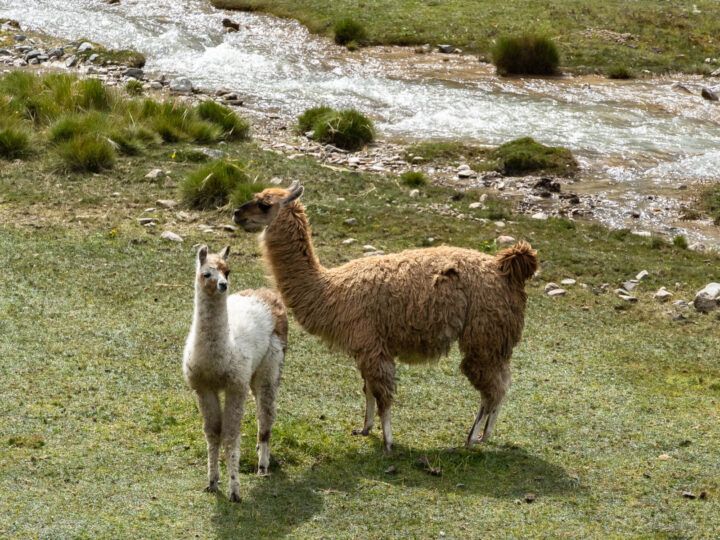
Considered a little easier, slower-paced, and much shorter than the Salkantay and the Inca trail, it’s a good option for families, as well as those who aren’t sure about their fitness levels! Alpaca Expeditions have a four-day/three-night itinerary .
The Choquequirao trek
- Length: 100 kilometers (62 miles)
- Hiking time: Nine days/eight nights
- Cost: From $1,250 USD
For the really adventurous, the trek to Machu Picchu via Choquequirao is a truly once-in-a-lifetime experience. Taking you first to the archeological site of Choquequirao, a mountaintop series of Inca buildings that is only visited by a handful of tourists and where you can camp just beneath, you then continue to Machu Picchu, combining two of the region’s finest Inca cities.
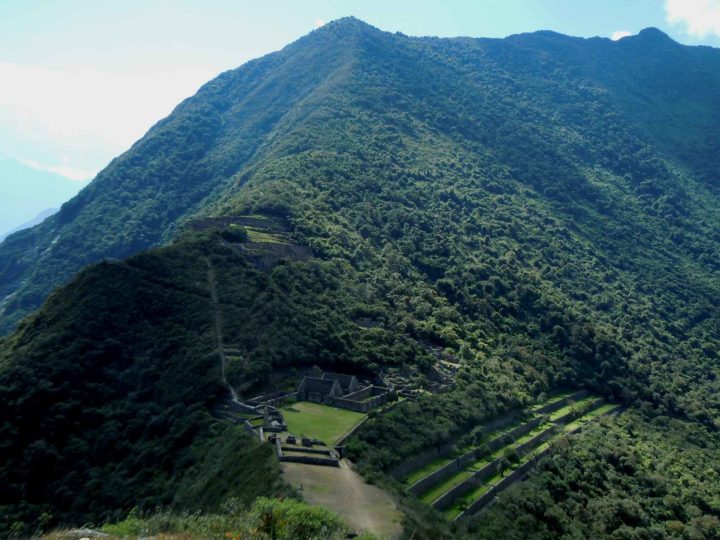
The hike has plenty of uphill to reach Choquequirao and is a long slog: 100 kilometres (62 miles) in total.
We’ve got information about hiking it independently in this guide to hiking to Choquequirao , while Alpaca Expeditions offer a shortened six days/five nights version of the trek .
I was a guest of Alpaca Expeditions on this tour, but the experiences, opinions and unfettered enjoyment of the trip are my very own. I don’t promote tours or experiences that I don’t believe to be 100% sustainable, ethical or high-quality.
* World Nomads provides travel insurance for travelers in over 100 countries. As an affiliate, we receive a fee when you get a quote from World Nomads using this link. We do not represent World Nomads. This is information only and not a recommendation to buy travel insurance.
Wednesday 4th of October 2023
Thanks for the article Steph! I would like to give a tip to your readers. If you buy the 5-day Salkantay trek online you pay anywhere between $500 - $700. On the other hand, if you simply walk in to the many tour agencies around Cuzco's Central Plaza (Plaza de Armas), you can get the same trek for between $250 - $300. Everything included. I walked into a few agencies and they were all around the same price. Seriously. I'm not trying to be an A-hole, just trying to save your readers some money. And you don't even need to wait for a spot. I walked into the tour agency and I was on the trail two days later. So my advice is...don't buy it online. Wait until you get to Cuzco and buy it in the agency. Just saying :)
Steph Dyson
Thursday 23rd of November 2023
Hi Gabriel, yes that definitely is an option. However, there's no guarantee the quality of the company you're travelling with and there are some pretty rubbish companies in Cusco who go for low prices and high tourist numbers without any consideration towards quality. Steph
Taylor Nelson
Saturday 3rd of June 2023
Great article Steph! Stoked we were part of your group and you captured the experience magnificently. Arriba, abajo, al centro, sexy movimiento, ADENTRO!
Monday 5th of June 2023
Thanks so much Taylor! I think I captured a lot of photos of the pair of you in the distance as you marched on at incredible speed😉It was great to share the experience with you! Steph
Get a FREE Essential Travel Apps and Websites Checklist!

Hiking the Salkantay Trek, Peru – A Day by Day Itinerary
So, you’ve decided to book the Salkantay Trek to reach Machu Picchu and now you’re wondering what those 5 days will look like? If so, then you’ve found the right post, because below we’ll detail how you’ll be spending your days when hiking the Salkantay Trek (one of the best 25 treks in the world according to National Geographic Adventure Magazine).
In case you’re still deciding whether to book the Salkantay Trek or the Inca Trail, then make sure to read our detailed guide on everything you need to know before you book your trek . It’ll give you a good insight into what you can expect and if it’s really the right trek for you.
If you’d like to see our adventures, then check out the Salkantay Trek video on our YouTube Channel. For more Peru videos check out our Peru Playlist .
Disclosure: This post may contain affiliate links, which means we may receive a small commission if you click a link and purchase something. Clicking these links won’t cost you anything, but it will help us to keep this site up and running! Learn more about our affiliate policy.
Table of Contents
Hiking the Salkantay Trek – Day by Day
Below is a detailed day by day summary of the Salkantay Trek and a stats card at the end that you can always refer to.
Day 0 of the Salkantay Trek: Briefing in Cusco
The Salkantay Trek actually starts the evening before your first hiking day. Normally you’ll have to visit the company’s office in Cusco where you’ll meet with your fellow hikers and the guide you’ll be spending the next 5 days with.
During this briefing your guide will break the trek down day by day, tell you a bit more about the logistics and will ask if you have any dietary requirements (e.g. vegetarian, vegan). We suggest reaching out to the company about any special dietary restrictions, such as allergies, before booking.
This is also your chance to ask your guide any last minute questions. You’ll have to bring your passport and any remaining fee in cash to this meeting. At the end, you’ll be given a duffel bag each which you’ll have to pack according to the company’s weight restrictions. These will be carried by a horse or mule, so please don’t over pack them.
Lastly, you can also collect your sleeping bag and walking poles if you’ve rented those. Note that your sleeping bag will need to fit in the duffel bag!
After the meeting, we recommend you go back to your accommodation, pack your bags and have an early night. You’ll need to be up at the crack of dawn the next day, so try to rest.
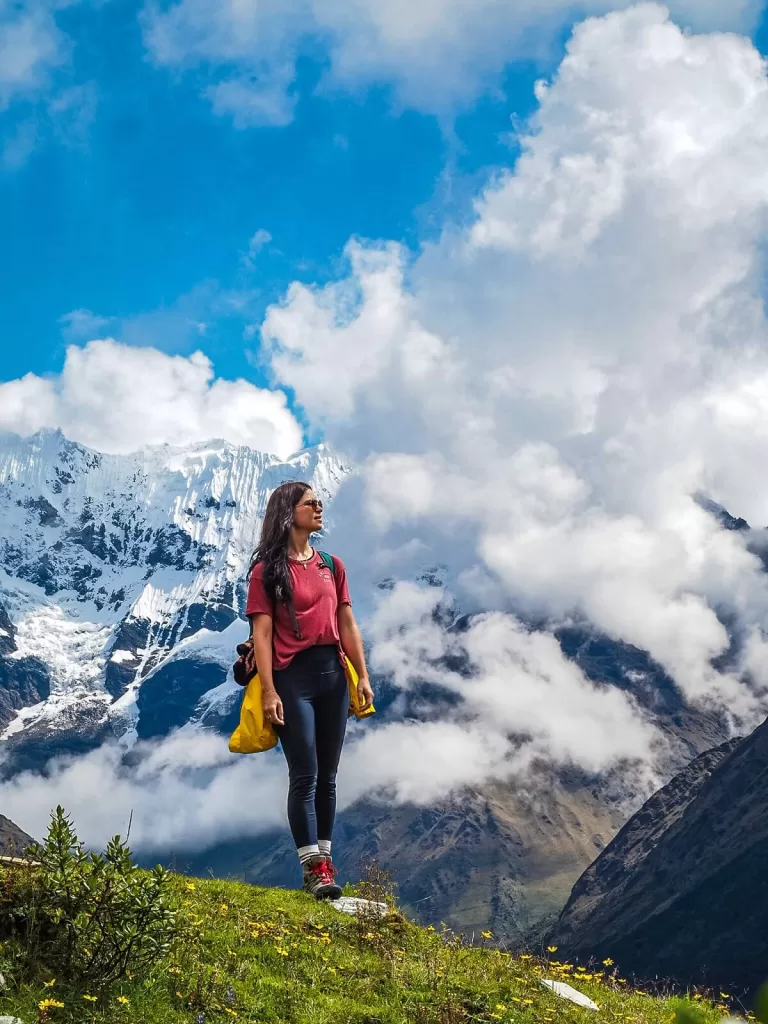
Day 1 of Hiking the Salkantay Trek: Lake Humantay
Morning: challacancha – soraypampa.
You’ll have a very early alarm and a 4AM pick up from your hotel or the closest main square in Cusco. A minivan will drive you to Mollepata , about two hours away from Cusco. There you’ll have an optional breakfast, which we recommend having unless you’ve packed your own food. The restaurant will have toilet facilities for free.
Then you’ll be driving to the trailhead in Challacancha (3,800 m / 12,467 ft). Here you’ll give your duffel bag to your horseman, may get given some snacks to keep you going until lunch and will normally have some group cheer to get you in good spirits after the early morning. You can also use the toilets for around S/.1 before you set off.
You’ll be hiking for around 3 hours (7 km / 4.3 mi) to Soraypampa located at 3,900m (12,795 ft). This is where you’ll be sleeping on the first night. Depending on the company you’ve booked with you may be sleeping in one of the Sky Domes, Sky Lodges or at one of the campsites. You’ll normally have lunch here and a little rest before the afternoon activity.
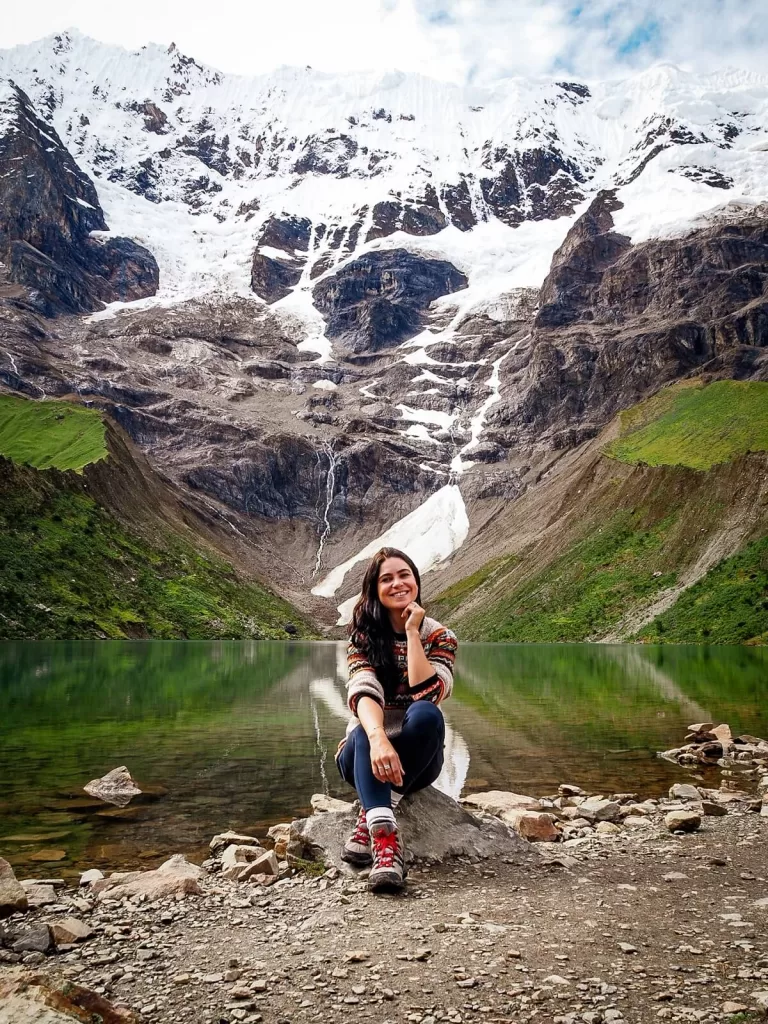
Afternoon: Soraypampa – Lake Humantay
After some food and rest, you’ll have the chance to hike up to Lake Humantay . This stunning emerald lagoon is one of the best day trips from Cusco , so you really can’t miss it. It’s only a 3 km (1.8 mi) roundtrip but it’s located at 4,200 m (13,780 ft) above sea level. This means that you’ll be gaining around 300 m (984 ft) of elevation. It normally takes about 3 hours to complete the loop including some time spent at the top. We got up to the lake in record time which allowed us to have it almost all to ourselves for a few minutes!
The emerald lagoon with the Humantay mountain towering above it, has to be one of the dreamiest places in the area. The lake gets its emerald colour from the minerals within the glacier that melt into the lake. Depending on the time of year you’re visiting, the shade of the colours can vary a bit.
It can get quite busy there, since most trekkers will go up around the same time. However, it’s still a beautiful place and one of the main reasons we wanted to sign up for the Salkantay Trek.
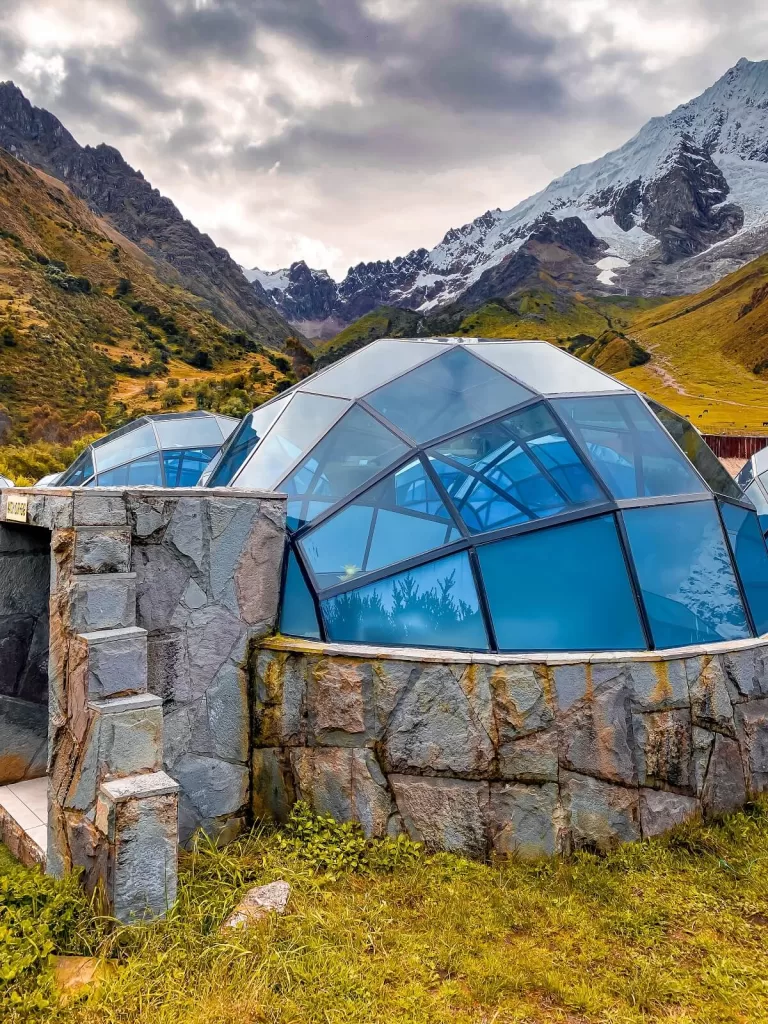
Evening: Lake Humantay – Soraypampa
Once you’re back at your accommodation, you’ll share a filling dinner prepared by the group’s cook. Your guide will tell you about the next day including wake up times and the rough itinerary. You can then socialise with others for a bit if you wish but we recommend getting to bed early.
We stayed at the Sky Dome accommodations, which are pretty cool, but they can get super cold during the night so prepare for that. Our campsite also switched off the electricity and running water quite early, so if you want to use the facilities and refresh yourself, then maybe get it done before dinner. Bringing a torch or headlamp will come in handy to move around the camp at night. Also, don’t be surprised if the toilets get a bit messy since there won’t be running water until early morning!
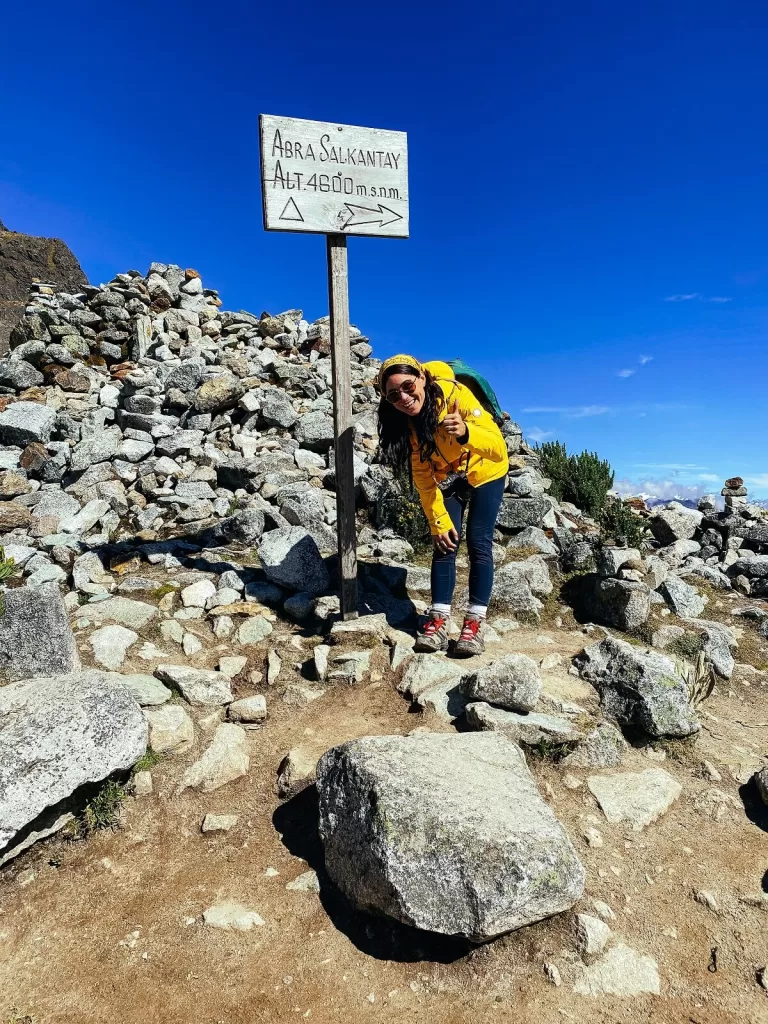
Day 2 of Hiking the Salkantay Trek: The Salkantay Pass
You’ll have another early wake up on your second day of hiking the Salkantay Trek. Normally the guides will bring you some coca tea in the morning to help with the altitude. Starting your day with a warm drink will also feel nice since it’ll be pretty cold. After a big breakfast you’ll start the toughest day on the Salkantay Trek.
Morning: Soraypampa – Salkantay Pass – Huayracmachay
You’ll have to make your way up to the Salkantay Pass which sits at 4,630 m (15,190 ft) above sea level. Guides normally say that if you survive the second day, you’ll be absolutely fine. This is kind of true since you’ll be in lower altitudes after the second day.
It’s about a 7 km (4.3 mi) route to the Salkantay Pass which is normally completed in about 3 hours. The hardest part is the ‘7 snakes’ section which is a steep ascent with many switchbacks. After a flatter part, you’ll have another short section to climb before you reach the Salkantay Pass. You’ll have gained over 730 m (2,395 ft) of elevation by this point.
The Salkantay Pass viewpoint is a really beautiful place where you’ll have some more coca tea and learn a bit more about the tales surrounding the Salkantay Mountain, the second highest peak in the Cusco region at 6,271 m (20,574 ft). Most trekkers will arrive here around the same time, so it can get quite busy.
From there, you’ll have another 7 km (4.3 mi) to go before lunch. It’ll be all downhill, which is fantastic but can also be a bit hard on the knees since the path is quite rocky. Hiking poles will come in handy here for sure.
Note. There won’t be any toilet facilities until your lunch spot. If you struggled on your first day with the ascent and altitude you can hire a mule to get you up to Salkantay Pass for an additional cost. You’ll still need to hike the downhill part on the other side though.
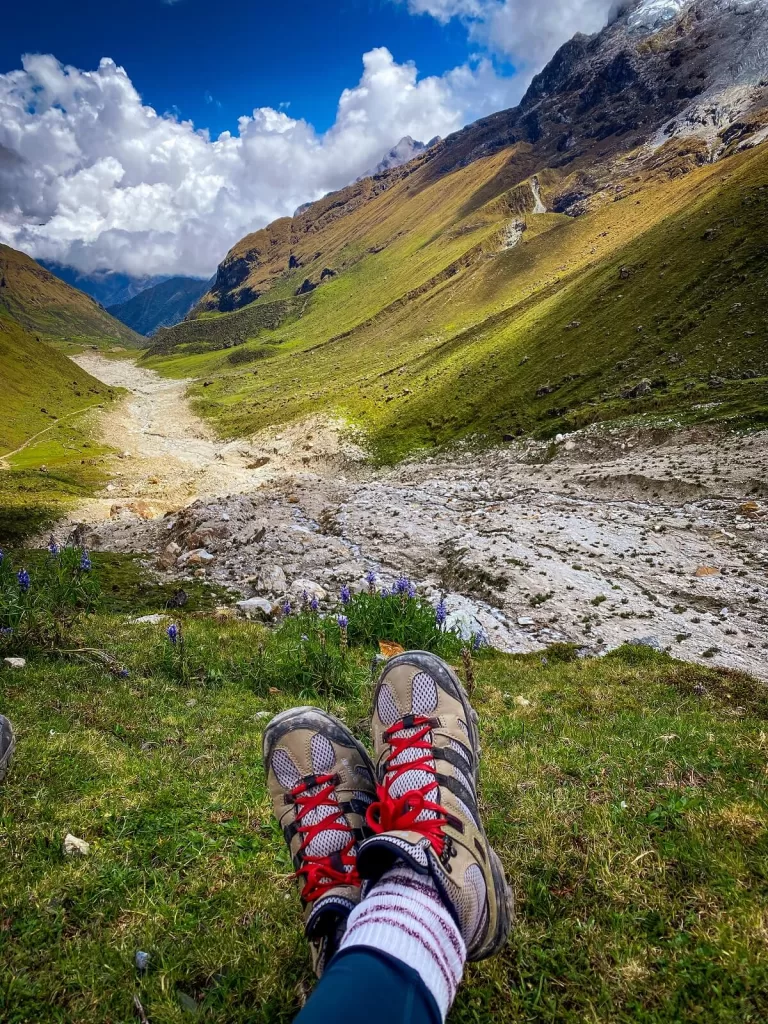
Afternoon: Huayracmachay – Chaullay
After your lunch in Huayracmachay (3,850 m / 12,631 ft) you’ll be entering the cloud forest part of the Amazon Jungle. This will feel like a crazy transition going so quickly from snowcapped mountain views to lush jungle.
It’s going to be an 8 km (4.9 mi) long hike before you reach your accommodation in Chaullay village at 2,900 m (9,514 ft). After leaving the Salkantay Pass, you’ll lose around 1,730 m (5,675 ft) of elevation, which will definitely make your breathing much easier.
Top Tip. It’ll be much warmer here too, so make sure to dress in layers because you’ll be going from gloves and hats to t-shirt and shorts. Before exposing any of your skin, make sure to put on sun-cream and bug repellent.
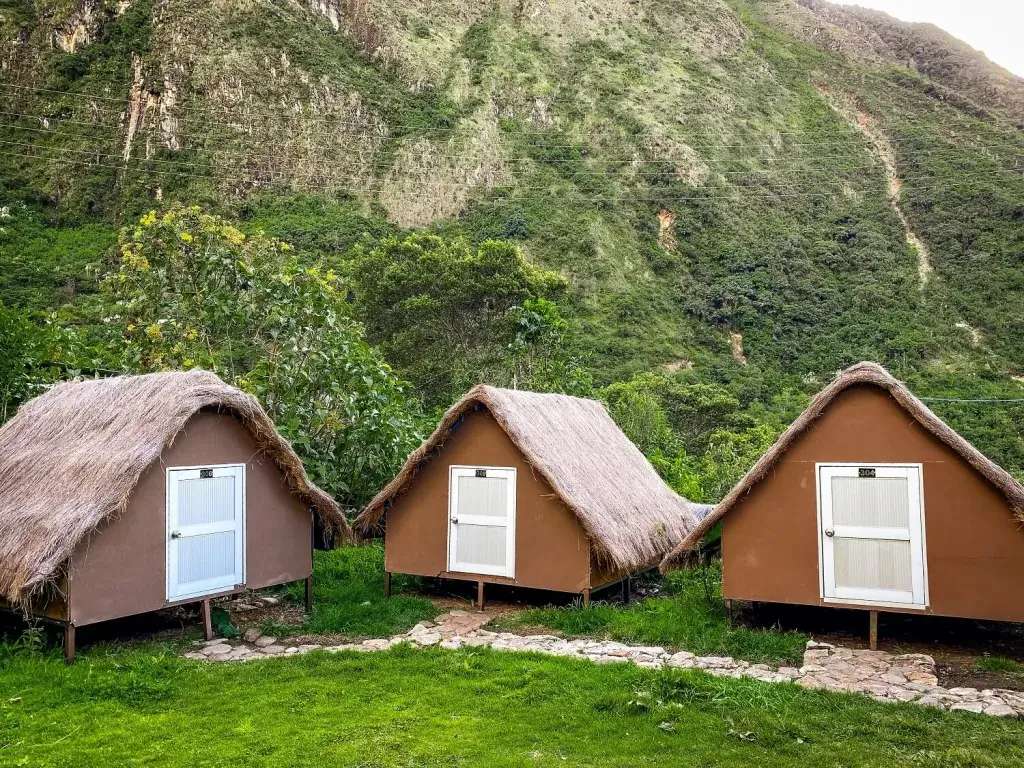
Evening: Chaullay
After arriving to your campsite somewhere in the village, you’ll have some free time in the evening. Our accommodation offered hot showers for an additional S/.10 per person. We recommend taking this offer as it’ll make you feel much more refreshed.
We slept in some cute looking Andean Huts that were tiny but much warmer than the Sky Domes on the first night. The combination of being warmer and at lower altitude will definitely guarantee you a better nights’ sleep.
As always you’ll have some snacks and dinner prepared by your cooks and you can hang out with your group or go to bed and relax. We recommend opting for an early night again, since you’ll have another early wake-up call the next day.

Day 3 of Hiking the Salkantay Trek: Amazon Jungle
You’ll be waking up to another early alarm, followed by some coca tea and breakfast prepared by your cook. After dropping off your duffel bags, you’ll start your 18km (11.18 mi) hike through the Amazon Jungle.
Morning: Chaullay – La Playa
After saying goodbye to Chaullay village , you’ll start your hike through the lush Santa Teresa Valley. You’ll pass Colcapampa , a village located close to Chaullay. Some hikers might be staying here on their trek. Luckily, the whole day you’ll be gradually losing elevation.
On the flip side, whilst the scenery is stunning, the trail itself will be rather boring as you’ll be following a dirt track pretty much the entire way. Although this sounds easy, walking that distance on the same path will be just as challenging both physically and mentally. However, trust us, it’s not the most boring part of the trek as we initially thought!
Luckily there are some random rest spots offering snacks and drinks along the way which do have toilet facilities.
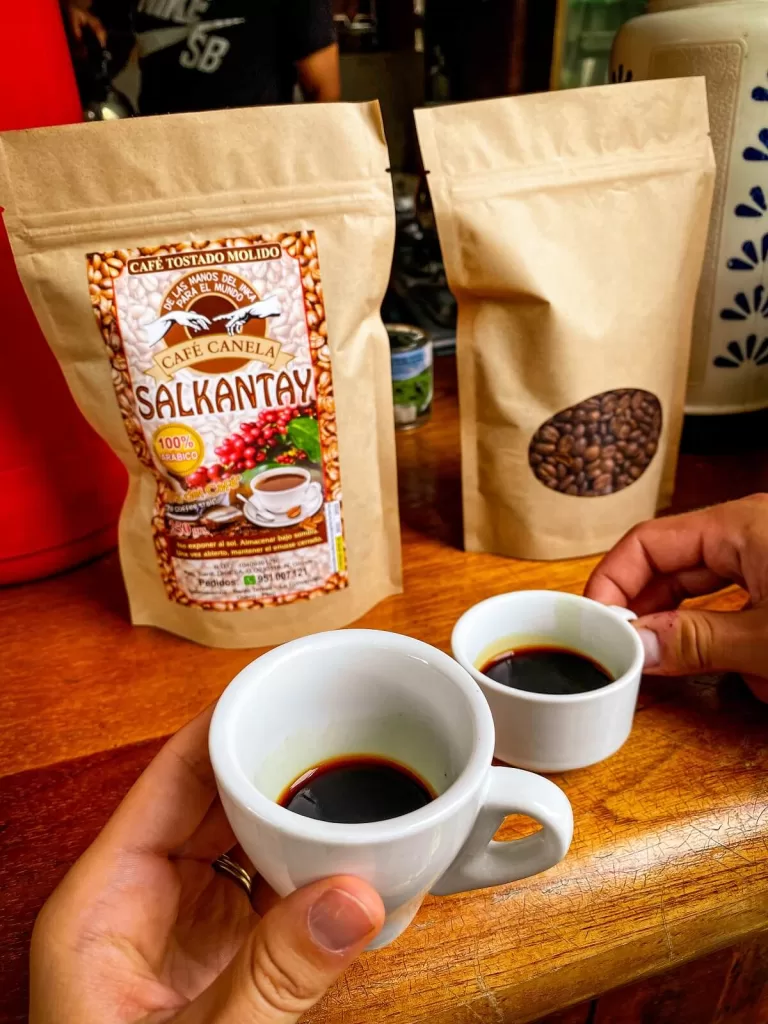
Afternoon: La Playa – Lucmabamba
Just before lunch, you’ll arrive at La Playa where you’ll get the chance to take a quick coffee tasting tour. We love coffee and attended a few of these tours in Mexico , Costa Rica and Colombia . So, having another coffee tour included in the Salkantay Trek was a lovely bonus.
Honestly, even if you’re not a coffee drinker, we think it’s interesting to learn about how coffee is made. You can even get hands on and help to roast the beans, then grind them and finally smell and taste the product of your ‘hard’ work. You couldn’t drink fresher coffee if you tried!
Once you’re caffeinated, you can either have lunch there or power walk the rest of the trail to your Jungle Dome accommodation in Lucmabamba (2,000 m / 6,562 ft) and have lunch there.

Evening: Lucmabamba (+ Cocalmayo Hot Spings)
After lunch you’ll have the chance to visit some hot springs called Aguas Termales Cocalmayo de Santa Teresa located in Santa Teresa. It’s an optional activity, so you don’t have to go. However, who wouldn’t want to soak their muscles in some beautiful hot springs after 3 days of hiking? Plus, you can have a shower there too, in case your accommodation doesn’t offer that.
Please note that the entry fee of S/.10 and a further S/.40 per person for the transport there is not included in your tour package. Make sure to bring enough cash to cover this.
It’s also worth noting that the drive there is rather bumpy and sketchy. You better not look out of the window when you cross the wooden plank bridge which is only about an inch wider than the minibus! It was still worth going though as the hot springs were really relaxing and the scenery was stunning too.
Upon returning from Santa Teresa, your evening will look very much like most evenings during the trek. You’ll have dinner together, then a quick briefing and some more free time with an early night.
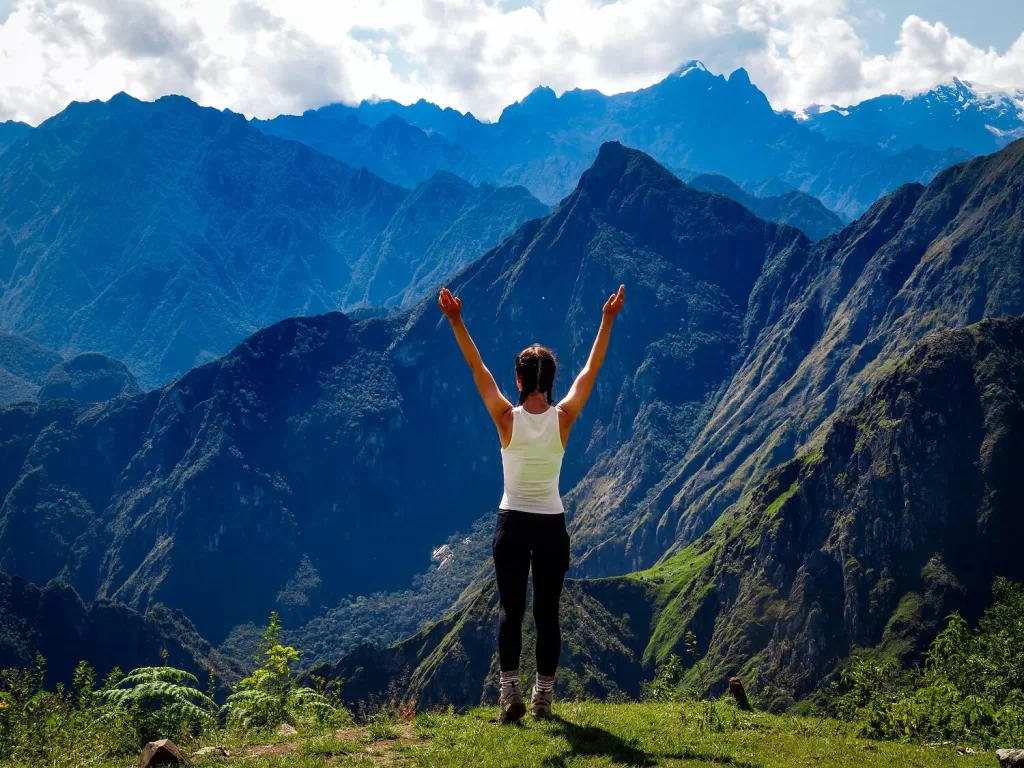
Day 4 of Hiking the Salkantay Trek: Aguas Calientes
Day 4 of the Salkantay Trek is special for multiple reasons. It’s the last day of hiking. Yippie! Day 4 is also going to be the longest distance you’ll have to walk, including some of the worst sections you’ll have to hike on the entire trek (25 km / 15.43 mi). Not so good! However, it’s also going to be the day where you’ll get your first glance of Machu Picchu and…drumroll please…you’ll be sleeping in a hotel or hostel room in a comfy bed. So all in all, a lot to look forward to.
Morning: Lucmabamba – Llaqtapata
Again, after an early wake-up call, some tea and a yummy breakfast you’ll actually say goodbye to both your cook and your horseman. So, it’s going to be the time where you can express your gratitude with some cheering and, of course, remember to tip them both.
Your stuff will be transported to Aguas Calientes by a vehicle and you’ll be having lunch and dinner at a restaurant. Trust us, although the food will still be delicious, you’ll miss your cook! Probably for the rest of your life for that matter…
Soon you’ll be going uphill to Llaqtapata Archaeological Site (2,700m / 8,858 ft). This section of the hike actually follows some of the original Inca Trail which is a little bonus in case you were hesitating between the two. You’ll be hiking for about 2 hours before reaching the Inca site, from where you get your first glimpse of Machu Picchu and Huayna Picchu.
This viewpoint is honestly an incredible highlight on the Salkantay Trek. After a bit more information on the Llaqtapata ruins, you’ll start your downhill walk to your lunch spot at Ahobamba. They will have toilet facilities for around S/.1 at Llaqtapata and for free at your lunch spot.
Note. Some trekking sites say that during the rainy season hiking up to Llaqtapata isn’t guaranteed due to the path becoming dangerous after heavy rain.
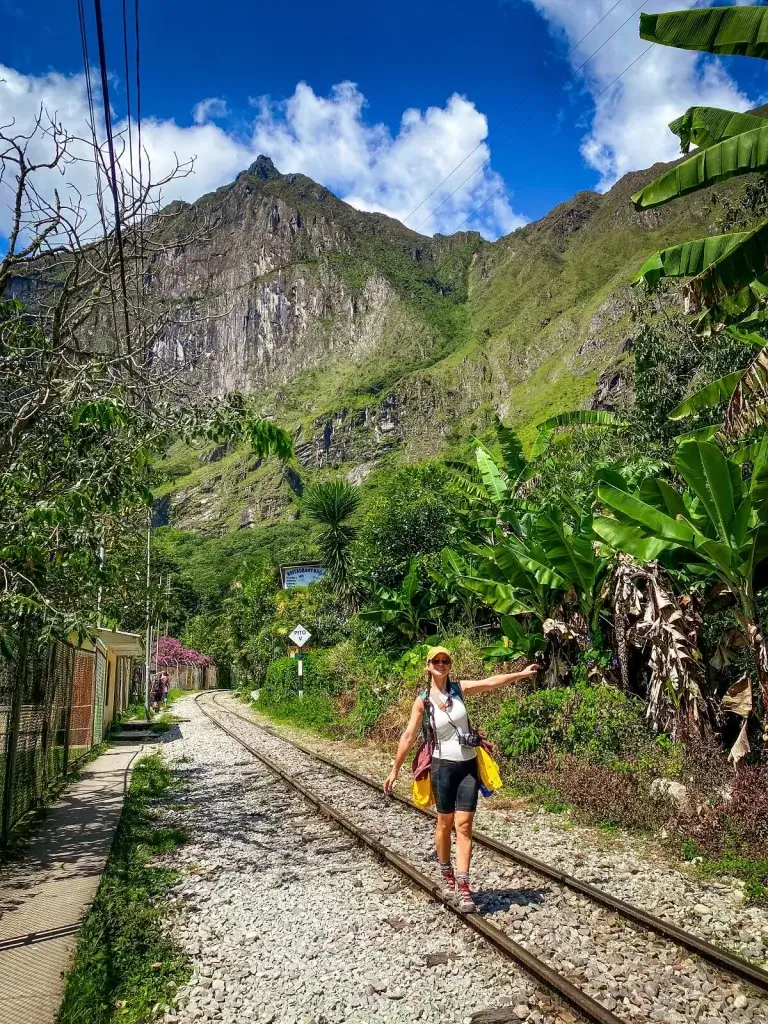
Afternoon: Llaqtapata – Hidroelectrica – Aguas Calientes
After lunch, you’ll have a short walk before you reach a place called Hidroelectrica (1,800 m / 5,906 ft). It is a 250m tall man-made waterfall that generates electricity for the whole of Cusco.
This is also the lowest altitude you’ll be at along the entire trek. From this point the next stop is going to be Aguas Calientes, which is the final stop in terms of trekking.
It’s probably worth noting that the Hidroelectrica to Aguas Calientes hike will be one of the most physically and mentally demanding sections of this entire Salkantay Trek. At least it was for us, for a few reasons. Firstly, you’ve already been trekking for 4 full days now, so you’re inevitably going to be tired. This is also the longest day of trekking at around 25 km (15.4 mi). You’re also more aware that this is the last leg, and your brain just wants to be in town and be finished. Whilst lower altitude is a gift for your lungs, it’s going to be quite hot, especially if you’re visiting in the dry season.
Lastly, this section of the trek is basically a 3-hour long hike along train tracks. Whilst it’s fun at first, at the end of the day it’s a rather flat and rocky path, so soon the fun feeling will wear off and you’ll be just dragging your feet to Aguas Calientes.
Luckily there are some shops along the path so you can fuel up on some drinks and ice cream. In case you don’t want to hike this section, you can actually take the train from Hidroelectrica to Aguas Calientes for an additional cost.
Note. Be careful walking along the train tracks as trains do go through here!

Evening: Aguas Calientes
Just when you’re thinking the train tracks will never end, you’ll get your first glimpse of Aguas Calientes (2,040m / 6,693 mi). Your guide will lead you to your hotel or hostel for the evening. This also means that you’ve officially completed the Salkantay Trek!
Once you’ve checked in and collected your duffel bag, you’ll have a free evening. The groups will normally go out for a final meal together, which is a lot of fun. Make sure to treat yourself with a Pisco Sour; you’ve definitely earned it!
Once dinner is over, you can just relax and look forward to finally seeing Machu Picchu in the morning.
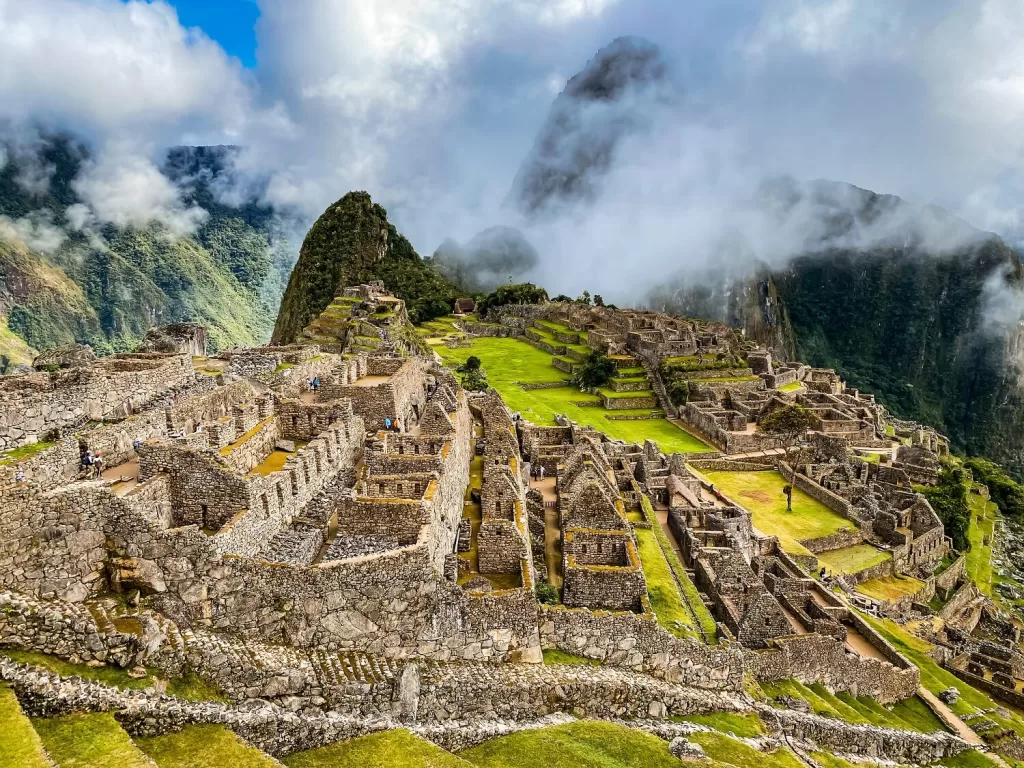
Day 5 of Hiking the Salkantay Trek: Macchu Picchu
The day you’ve been waiting for has finally arrived. You’re about to see one of the new Seven Wonders of the World: Machu Picchu.
Morning: Machu Picchu
After a final early morning alarm, you’ll have a quick breakfast and then head to the bus stop. The bus ticket is normally included in your tour, but it’s worth checking this detail before booking. It’ll be a short, but scenic drive up to the entrance of Machu Picchu (2,430 m / 7,972 ft).
First, you’ll head to the viewing platform where you’ll get that iconic view of this incredible Inca site. Now, it’s worth noting here that you may or may not get to see Machu Picchu straight away. This is because it can be pretty foggy in the mornings and the site can become pretty much invisible. Guides will say that in about half an hour the fog will disappear. Well, we waited 2 hours before Machu Picchu decided to reveal its beauty to us!!
We were honestly giving up by this point, but once the fog cleared, the energy and the cheering of other tourists was definitely an incredible moment we’ll never forget. I think we appreciate the beauty of Machu Picchu even more, having had to wait for the fog to clear before we could see it.
Once you’ve taken about 100 photos of the same thing, you’ll start a 2-hour guided tour around the site. This is very interesting because you’ll learn a lot about the different buildings and what the Inca used them for. It’ll be very similar to other Inca Ruins you may visit in the Sacred Valley.
For those wanting some extra hiking, you can hike up to either Huayna Picchu or Machu Picchu Mountain. Note that the tickets are very limited per day, so you need to book this way in advance!
Once the tour is over, you can either buy a bus ticket back to Aguas Calientes or walk back. This ticket is normally not included in your package. We decided to take the stairs and it was a relatively quick hike.
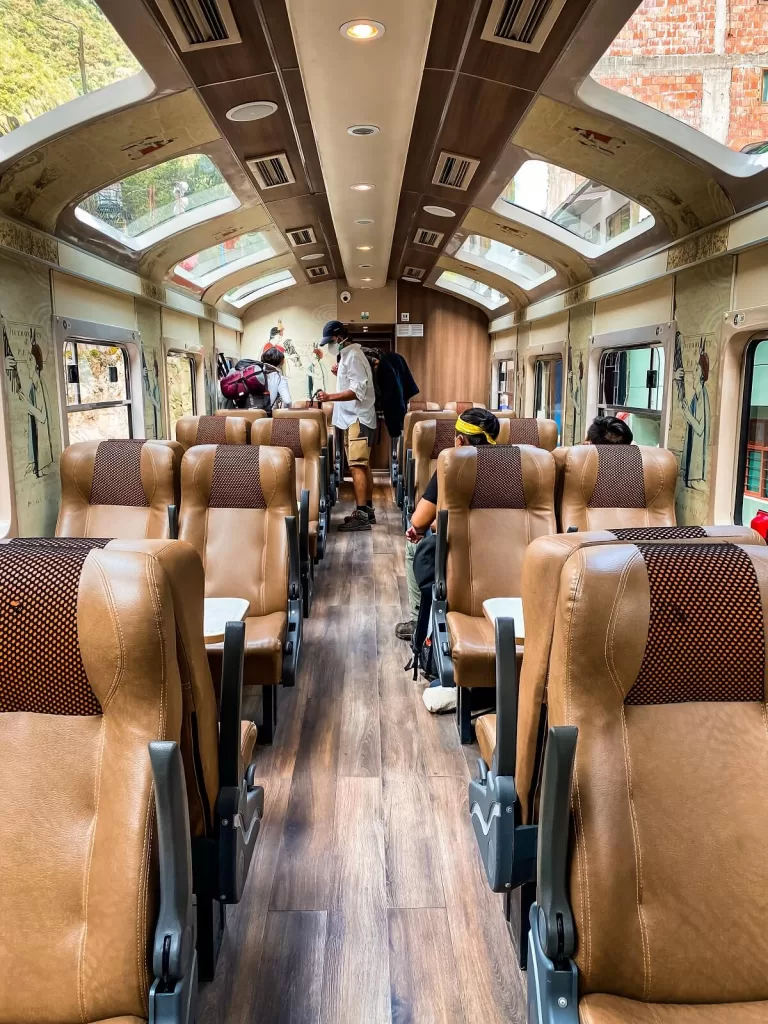
Afternoon: Aguas Calientes – Ollantaytambo
You’ll spend the afternoon in Aguas Calientes before boarding a scenic train back to Ollantaytambo. Lunch and dinner aren’t normally included on this day, but there are plenty of restaurants and ‘Menu del Dia’s’ in town.
If you want to, you can head over to the Ministry of Culture at the Main Plaza where you can get a Macchu Picchu ‘passport’ stamp. This is the place where people buy their Machu Picchu ticket, so it can be pretty busy. However, if you just want a stamp they will let you go through. Please make sure that you DO NOT stamp your actual passport! This isn’t an official border stamp and would make your passport invalid. Bring a notebook or travel journal instead.
In the early afternoon, you’ll board your train to Ollantaytambo. Depending on the tour company, you’ll either be travelling with PeruRail or the Vistadome train which is a more expensive option. It normally costs at least an extra 60USD if it isn’t included in your trek cost. This train journey is a pretty scenic one thanks to the panoramic design that allows you to see through the roof of the carriages as well as through the huge side windows.
Evening: Ollantaytambo – Cusco
After a nearly 2-hour long train journey, you’ll arrive in Ollantaytambo. From here, you’ll board a minivan that will take you back to Cusco.
This means that you’ll have completed the 5-day Salkantay Trek and also visited one of the New Seven Wonders of the World.
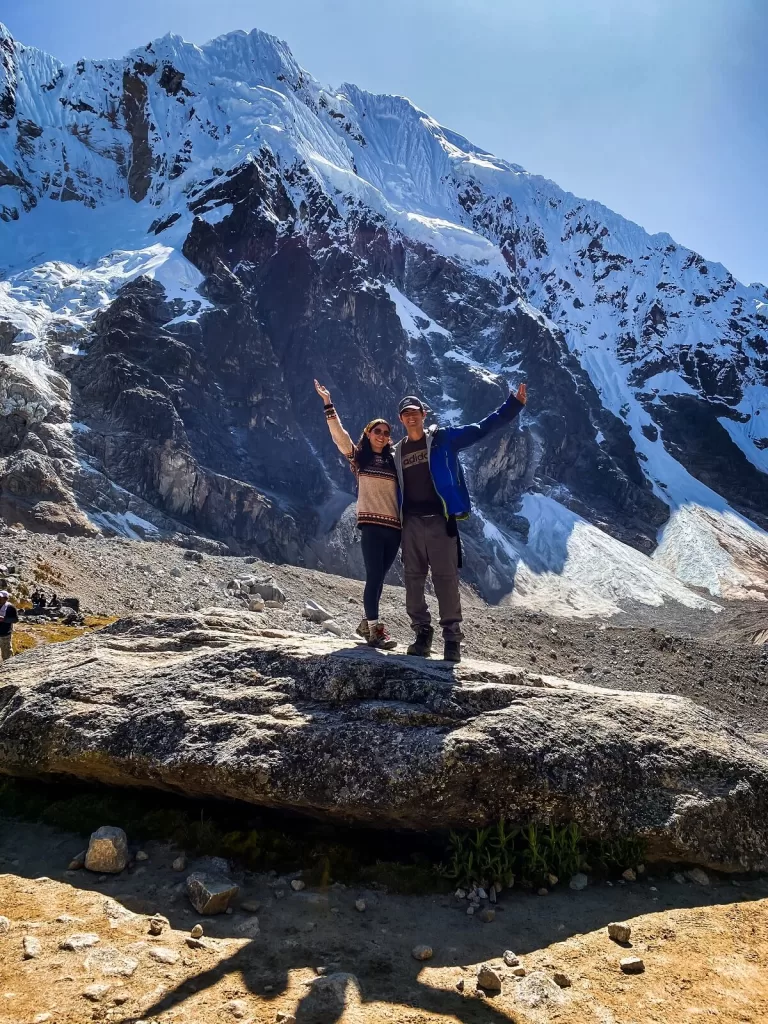
Final Thoughts on Hiking the Salkantay Trek
I think it’s safe to say that we absolutely loved hiking the Salkantay Trek, and are very happy that we decided to book it instead of the Inca Trail. We loved that we could visit Lake Humantay, challenge our bodies with high altitude hiking at the Salkantay Pass, taste some coffee in the jungle and relax our tired bodies halfway through in some picturesque hot springs.
For us, seeing Machu Picchu after hiking for 4 full days was a much deeper and memorable experience than a simple day-trip would’ve been.
We also realised a few things while hiking the Salkantay Trek. By the end of your trek you’ll have become a morning person even if you hate mornings. (Luckily, we didn’t have an issue with that). You’ll also realise that you really don’t need much stuff and won’t even care or notice if you don’t take a shower every day. But most importantly, you’ll see that your body can walk many miles every day and can repeat the same thing the next day even if you feel like you’re about to collapse in the evenings.
Have you ever hiked the Salkantay Trek? If so, what was your experience? Which were your most and least favourite days? If not, would you consider hiking the Salkantay Trek over the Inca Trail? Let us know in the comments below.
Now, let your adventure begin,

Our Top Travel Resources
Accommodation: For hotels we always use Booking.com and Hostelworld for hostels. We also book longer stays on Airbnb or Vrbo.
Flights: To find the best flight prices we always check Skyscanner , Google Flights or WayAway. Then we also check the airlines’ websites too for comparison.
Car Rentals: We use Discover Cars when we want to rent a car as it compares local, national and international companies.
Activities: If we book organised tours we always check either GetYourGuide or Viator.
Foreign Currency: Whenever we can we prefer to pay in local currency and for that we always use our Wise card. We can easily withdraw money from the ATM or pay by card at most shops and restaurants.
Travel Insurance: We never go anywhere without travel insurance. You never know what will happen on your trip, so good travel insurance like SafetyWing can protect you in case of injury, illness, theft and cancellations.
eSIM and VPN: To get data abroad we use Airalo which is an app that allows you to download a prepaid eSIM to your phone in over 190 countries. Make sure to have a VPN to avoid hackers accessing your personal data when using public WIFI. We use Surfshark which is the only VPN that offers one account on unlimited devices.
Remember…It all starts with a Pin…
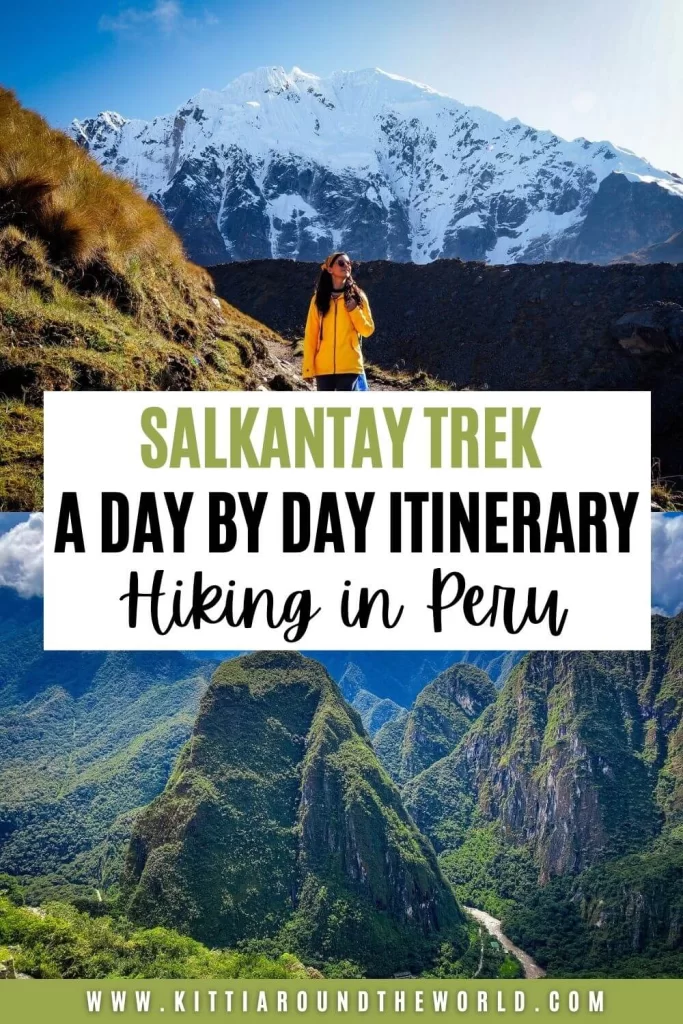
Similar Posts
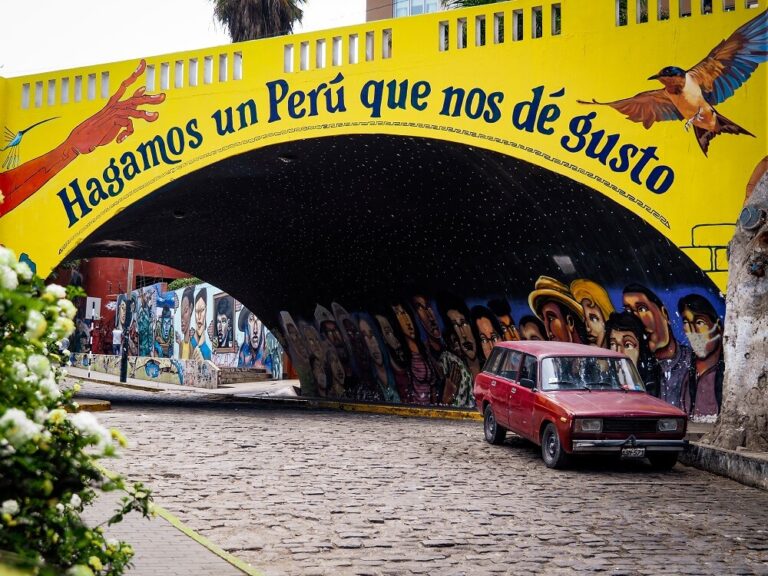
Best Things to Do in the Barranco District of Lima, Peru
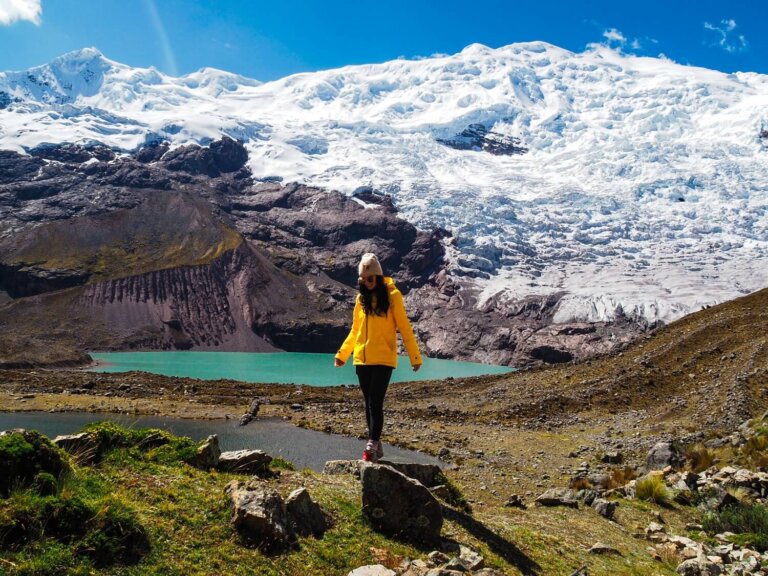
2-Day Ausangate Trek to Rainbow Mountain, Peru – A Complete Hiking Guide

6 Day and Multi-Day Trips from Arequipa, Peru
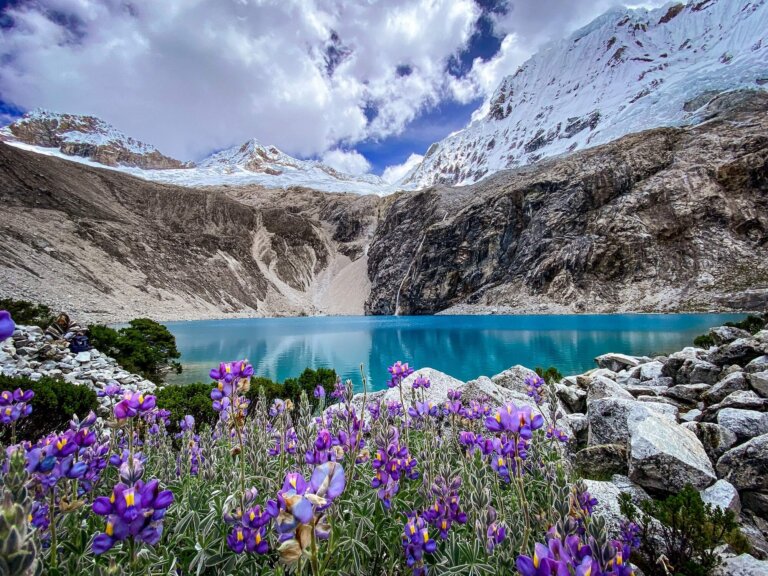
A Guide to Hiking Laguna 69 in Huaraz, Peru
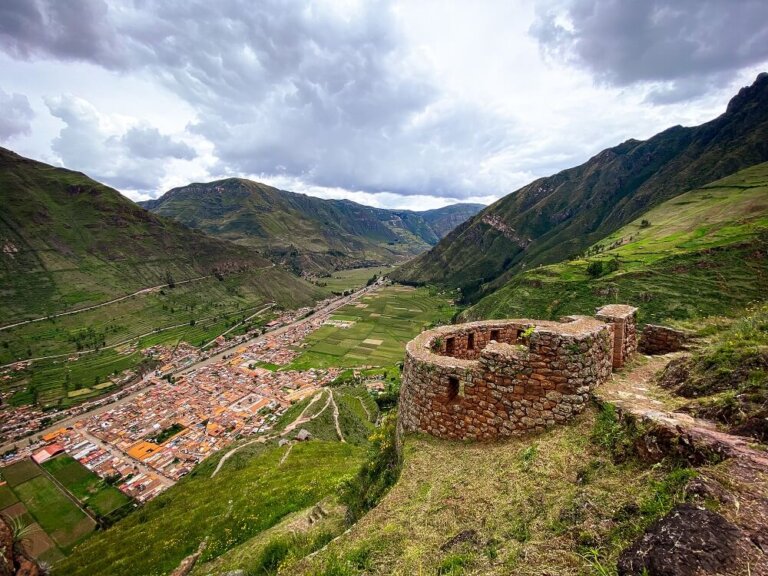
A Guide to Visiting Pisac Ruins, Peru
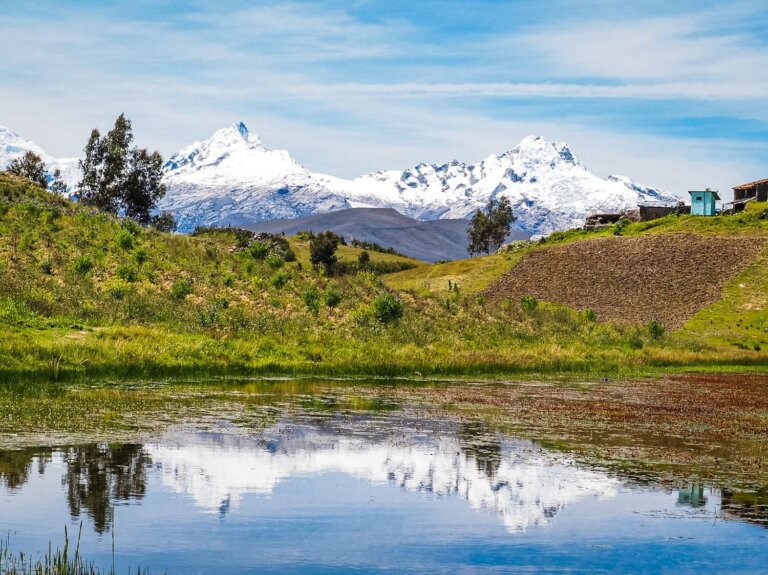
A Guide to Hiking Laguna Wilcacocha in Huaraz, Peru
16 comments.
Wow! I would have loved to have done this hike if I’d been younger when we went to Peru. Your photos are gorgeous! What camera did you carry?
Thank you for your comment Amy, we’re so happy that we picked this hike. We had our Olympus camera, iPhones, drones and GoPros with us on this trek.
Thanks for all of the detailed information. I feel as though I could do this hike and be totally prepared from your post.
Thank you so much Jolayne, we’re happy that you find our post helpful.
Thanks for this detailed guide on Salkantay Trek. Pinning this for future reference as I can see myself taking this trek someday.
Thank you so much for the positive feedback. Hope you can complete this trek in the near future.
Wow, all these places look stunning! The photos also turned out amazing from your trip! Thanks for sharing all your recommendations. I’ll be saving them for a future trip here!
Thank you so much Kelly, we’re happy that you liked our photos.
This hike is at the very top of my bucket list! Thanks for sharing – very helpful information and beautiful pictures!
Thank you Chanelle, hope our post will come in handy before your trip.
Great post, and what an unforgettable experience 🤩 Love your pictures as well! Keep up the good work 👍
Thanks Joey we absolutely loved hiking the Salkantay Trek. It was definitely an adventure we’ll never forget.
Brilliant Blog!! This trek looks and sounds spectacular. Congratulations on completing it and for sharing all the hints and tips! One day!🤞xx
Thank you so much Karan. We absolutely loved hiking this trek. It was an unforgettable adventure and a fantastic way to get to Machu Picchu.
What a brilliant blog Kitti! I really enjoyed reading it. So well written and full of really useful details. Great pictures as well and what stood out was that everything you wrote seemed to answer all the questions that I had been thinking about. Thanks for writing it and sharing . Looking forward to your 📖 😜.
Thank you so much for the positive feedback, I’m happy that the post answered all of your questions. Have a great trip to Peru and enjoy the Salkantay Trek!
Leave a Reply Cancel reply
Your email address will not be published. Required fields are marked *

- Salkantay Trek to Machu Picchu 4 Days
- Salkantay Trek + Original Inka Trail to Machu Picchu 5 Days
Salkantay Trek + Humantay Lake 2 Days
Private service salkantay trek to machu picchu (4 days).
- Inka Trail Original To Machu Picchu 2 Days
- Inka Trail Original to Machu Picchu 4 Days
- Tours Machu Picchu by Train Full Day
- Travel Sacred Valley to Machu Picchu 2 Days
- Travel Machu Picchu by Train 2 Days
- Tours Machupicchu by Bus 2 Days
- Inka Jungle Trek to Machu Picchu 4 Days
- Inka Jungle Trek to Machu Picchu 3 Days
- Super Sacred Valley 1 day
- Maras Moray Salt mines
- Sacred Valley of the Incas
- City Tours Cusco
- The Classic Humantay Lake in Group 20 paxs
- The Classic Rainbow Mountain in Group 20 Paxs
- The Humantay Lake in Private Service
- Humantay Lake Tour 2 Days
- The Rainbow Mountain in Private Service
- Choquequirao Trek 4 Days
- Choquequirao Trek 5 Days
- Choquequirao Trek 7 Days
Salkantay Trek
An adventure to machu picchu.
Embark on the Salkantay Trek , one of the most outstanding routes to Machu Picchu. During this 5-day trek, you will experience a variety of breathtaking landscapes, from majestic mountains to lush jungles.
Reasons to Choose the Salkantay Trek
Natural connection.
Enjoy the biodiversity and scenic beauty of the Andes.
Quiet Routes
Escape the crowds and live an authentic experience.
Visits to Machu Picchu
Access the iconic site on two occasions to enjoy its magic Machupicchu .
Book your Adventure
Don’t miss this unique opportunity! Book your adventure on the Salkantay Trek and start planning your trip to Machu Picchu today.

Salkantay Trek + Original Inka Trail to Machu Picchu 5days

Salkantay Trek to Machu Picchu 4 days

5 Day - Salkantay Trek
TICKET PRICES STARTING FROM
Taxes and fees will be calculated at checkout
Salkantay trek is a high altitude 74km / 46 miles hike in the Cusco region, Peru. The route starts at Mollepata, a small town 100km from Cusco. Trekking includes a visit to Inca site; Machu Picchu both history and nature lovers will enjoy Salkantay trek
Ticket Options
1 Option Available
5 Day - Salkantay Trek: $350
Pickup included
Ticket Information
- Mobile or paper ticket accepted
- One per booking
What's Included
- Transport from Cusco to Challacancha
- 01 night’s stay at a hostel in Aguas Calientes.
- Transport Ollantaytambo - Cusco
- Horses (equipment, food)
- Horse for carrying a maximum of 8 kilograms of baggage per person
- Professional guide
- Pick up from your hotel
- Entrance to Machu Picchu
- Camping equipment (tents and sleeping mats)
- Return train ticket in expeditions class Aguas Calientes –Ollantaytambo
- Briefing at your hotel, the night before the tour
What's not Included
- Breakfast on the first day
- Lunch on the final day
- Bottled water or snacks during the tour
- Entrance to Huayna Picchu
- Entrance to machupicchu mountain.
- Bus tickets to and from Machu Picchu
- Sleeping bag
- Train from hydroelectric station to Aguas Calientes
- Entrance to Salkantay (S / .10.00 Peruvian soles)
- Entrance to hot-spring (s /. 10.00 peruvian soles)
Cancellation Policy
- For a full refund, cancel at least 24 hours before the scheduled departure time.
Additional Info
- Not recommended for travelers with spinal injuries
- Not recommended for pregnant travelers
- Not recommended for travelers with poor cardiovascular health
- Travelers should have at least a moderate level of physical fitness
Travel Like an Expert with AAA and Trip Canvas
Get ideas from the pros.
As one of the largest travel agencies in North America, we have a wealth of recommendations to share! Browse our articles and videos for inspiration, or dive right in with preplanned AAA Road Trips, cruises and vacation tours.
Build and Research Your Options
Save and organize every aspect of your trip including cruises, hotels, activities, transportation and more. Book hotels confidently using our AAA Diamond Designations and verified reviews.
Book Everything in One Place
From cruises to day tours, buy all parts of your vacation in one transaction, or work with our nationwide network of AAA Travel Agents to secure the trip of your dreams!

IMAGES
VIDEO
COMMENTS
OkiDoki Salkantay trek The OkiDoki Salkantay trek was absolutely fantastic, I had an amazing time! There were only 6 of us in a group, much smaller than bigger companies, which was lovely. All the crew were amazing - the guide, cook, mule guy, and Alvaro the manager. I would 100% recommend this lovely small company.
Discover the Salkantay Trek with Oki Doki Travel Peru. Enjoy stunning landscapes and high-altitude adventures. WhatsApp: +51 984 657 022 | WhatsApp: +51 969 249 344 | [email protected] | Tripadvisor. Payment Online Contact Us About Us Blogs. Salkantay Trek ...
The famous Salkantay Trek was recently named among the 25 best treks in the world. It connects the city of Cusco with Machu Picchu, this being an ancient and remote trail located in the same region as the Inca Trail, where huge snow-capped peaks collide with lush tropical forests with flora and fauna in the mountains.
OkiDoki Travel: Salkantay trek - See 449 traveler reviews, 430 candid photos, and great deals for Cusco, Peru, at Tripadvisor.
The Salkantay trek (also known as the Salkantay trail) is the most popular alternative trek to Machu Picchu. And with good reason - it offers hikers an incredibly diverse trekking experience. National Geographic Adventure Magazine rated the Salkantay trek as one of the 25 Best Treks in the World. The trail is relatively easy to access from Cusco.
The Salkantay Trek is known to be harder than the Inca Trail. This is due to the higher elevation, the challenging mountain terrain, and the total walking distance, which is 74 km on the Salkantay Trail vs 42 km on the Inca Trail. 4. Arrival at Machu Picchu. The Salkantay Trek does not actually end at Machu Picchu.
Travel back in time to the 15th century on this epic 5-7 day Salkantay Trek across majestic landscapes and into perhaps the world's most spectacular man-made construction project, Machu Picchu. Created by the Inca tribe over 500 years ago, this incredible UNESCO world heritage site is a testament to the power and ingenuity of one of the world ...
This is one of the best okidoki options for the Salkantay trek because it has a diversity of landscapes such as glacier mountains, jungle, forest, fauna, and we complement it with the original Inka trail and beautiful archaeological sites, Chachabamba, Wiñayhuayna and the famous Sun Gate (Puerta del Sol) and the most important thing to be in Machupicchu 2 times that with this new government ...
However, as Machu Picchu's fame increased, so did the quantity of people wanting to experience the Inca Trail. In the early 2000's authorities installed a much needed quota on hiking numbers, a decision which led to the emergence of the Salkantay Trek on the world's backpacking radar. I hiked the Salkantay Trek in August, 2017.
Download our free Salkantay trek packing list. Salkantay trek cost. Independent trek, per person. Transport - 30 Sol/US$10 bus Cusco - Mollepata, bus Hidroelectrica - Cusco - 60 Sol/US$18; train Aguas Calientes - Hidroeléctrica (optional, you can walk) - 60 Sol/US$19 one way. Shopping (food, gas) - 100 Sol/US$30.
The Salkantay trek starts at Soraypampa at an elevation of 3,900 meters above sea level. The elevation profile for the rest of the hike is as follows: Day One: Soraypampa (3,900 meters) - Humantay Lake (4,200 meters) - Soraypampa (3,900 meters) - Salkantay Pass (4,620 meters) - Wayramachay (3,800 meters)
The Salkantay Trek to Machu Picchu is an alternative to the Inca Trail and considered by most to be the best alternative route (and maybe even better!). This magnificent trail is perfect for adventurers who wish to become personally integrated in changing ecosystems from one day to the next. You will walk through sweeping, magical landscapes of ...
Day 4 of Hiking the Salkantay Trek: Aguas Calientes. Day 4 of the Salkantay Trek is special for multiple reasons. It's the last day of hiking. Yippie! Day 4 is also going to be the longest distance you'll have to walk, including some of the worst sections you'll have to hike on the entire trek (25 km / 15.43 mi). Not so good!
The Peru Salkantay Trek is a journey like no other. Before you embark on it you must know all about Salkantay Trek. WhatsApp: +51 984 657 022 ... Oki Doki Travel Peru. Office and Hours. Offices: Calle Nueva Alta #644, ofi 01, Cusco - Peru. Office Attention: 9:00 a.m. at 8:00 p.m. Contact.
The Salkantay Hike 4 Days comes from the name of the mountain that means "Wild Mountain" located in the Cordillera del Vilcanota considered the second largest mountain in Cusco and of spiritual value. Salkantay trek is an alternative trek to visit Machu Picchu, the level of difficulty is similar to the Classic Inca Trail.
Embrace a journey whispering the ancient tales of the Incas on the Salkantay Trek. Discover the unbridled beauty of the Andes en route to Machu Picchu. Stretching 55 kilometers, or roughly 34 miles, the Salkantay Trail unveils Peru's raw beauty. This vibrant trek both enchants and challenges with every step.
Are you still thinking of taking a trip to the Salkantay mountain?Do the Salkantay trek to Machu Picchu in Peru is a part of an extensive Inca system of trails of more than 23,000 km that integrated the Tahuantinsuyo Inca Empire that included its extension in South America with the countries of Colombia, western Brazil, Ecuador, Peru, Bolivia, central Chile and northern Argentina.
Embark on the Salkantay Trek, one of the most outstanding routes to Machu Picchu. During this 5-day trek, you will experience a variety of breathtaking landscapes, from majestic mountains to lush jungles. Reasons to Choose the Salkantay Trek Natural Connection. Enjoy the biodiversity and scenic beauty of the Andes. Quiet Routes
Salkantay trek is a high altitude 74km / 46 miles hike in the Cusco region, Peru. The route starts at Mollepata, a small town 100km from Cusco. Trekking includes a visit to Inca site; Machu Picchu both history and nature lovers will enjoy Salkantay trek. Ticket Options.